CROWNING CUCUMBERS, HOMAGES TO HOLLER AND
FOLLOW THAT SHEEP . A CHEF ARTIST AND AN OVEN REVELATION, HEART & SOUL, SOUTHERN PLEASURES AND

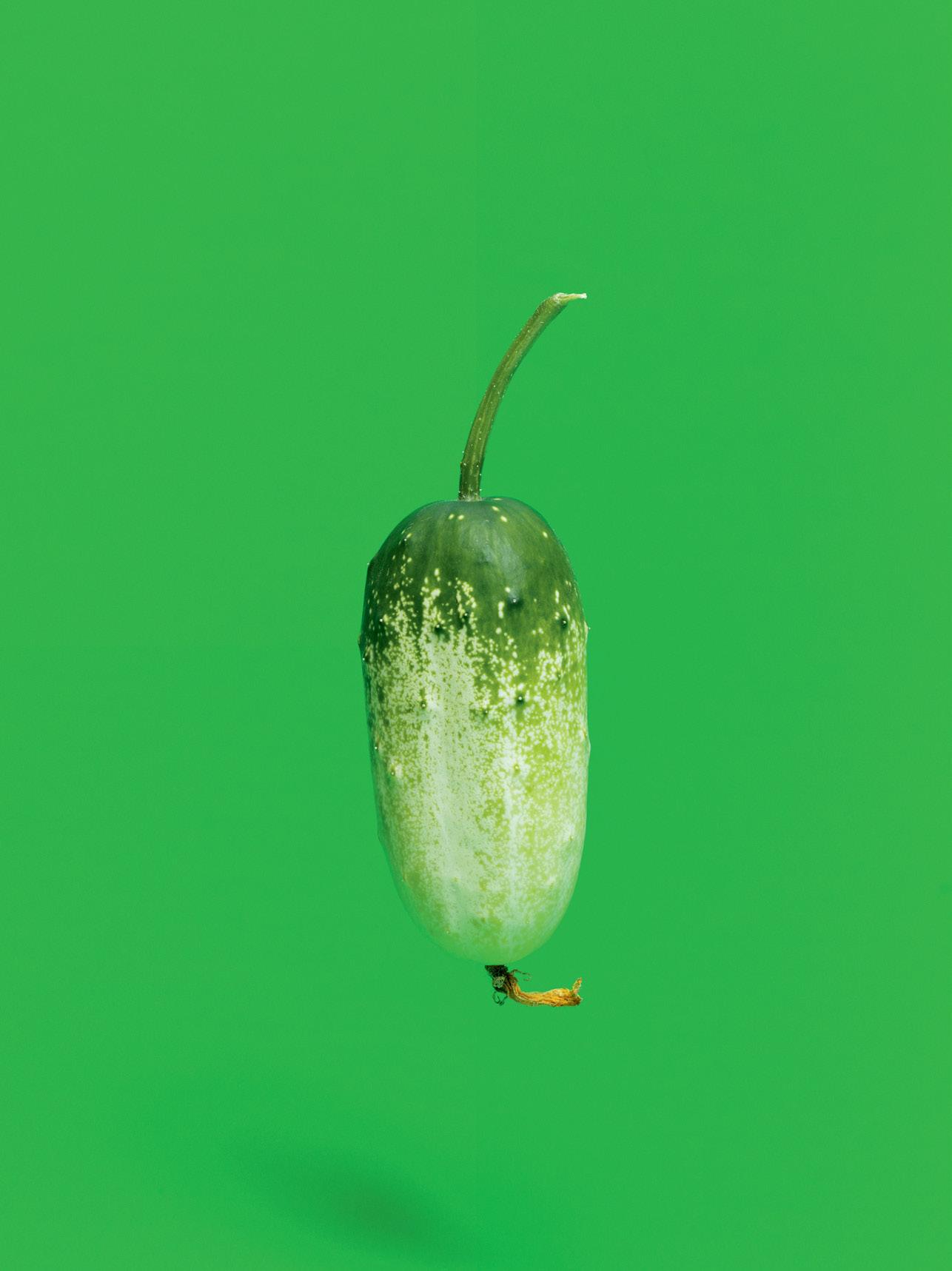
HOW THE WINE OF THE FUTURE WILL TASTE.
Vienna
Steirereck
8 € (AUT), 11 € (D), 14 CHF (SUI) Issue 14




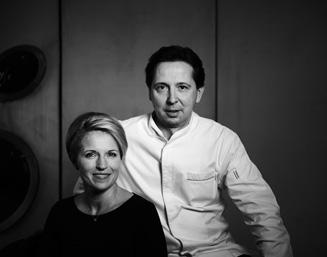
It’s not easy to find the right words in times like these. Why does it first take a pandemic and then, even worse, a devastating war not far from our doorstep to suddenly get cracking with plans and ideas at lightning speed, when it would have been so important to implement them long ago? Must we really have our backs to the wall before European unity emerges and legislative due process doesn’t need too much time?
The fact that our way of dealing with nature, with resources and with our food has been completely out of balance for years is unfortunately also nothing new. But despite all the announcements and promises to change something, decisive steps are still a long time coming. With the current situation and with a view to potential humanitarian catastrophes, this of course seems secondary, but only as long as availability and price security are guaranteed.
It is a shame to see how we waste food next to the sorrowful images of war and food shortages. However, perhaps this sad time will change our attitude, make us appreciate food more and recognize the importance of regional agricultural diversity.
The S Magazin has made it its business to put pioneers in this field on center stage. Michael Wilhelm, for example, is one such pioneer. The Tyrolean breeder of cattle and Zackel sheep high above Sölden is pursuing a bold and incorruptible path all on his own. Or Georg Lindenbauer, who does great work in the wood stove sector. For the new Schankkuchl in the Wirtshaus am Pogusch, he built a huge stove that is by no means used solely for cooking.
Soon we will be almost completely self-sufficient in energy at Pogusch, and we are also trying to leave the beaten track in terms of food handling and production. Visit us at our home in Styria and see for yourself. And as a little foretaste, this 14th issue of the S-Magazin has a story about our inn.
BIRGIT AND HEINZ REITBAUER


Until then, all that remains is to wish for you and all of us that our world does not go completely off its rails. We only have one!
14
EDITORIAL S Magazin, Issue
3 S MAGAZIN INTENTIONS
6 C OME UNTO ME, I WILL GIVE YOU REST A s hort cultural history.
By Christian Seiler
8 SERENDIPITY
Noble, beautiful, tasty Tips for well-being full of enjoyment.
1
Who & why
CONTENTS
2
From what & how much
54 CR OOKED THINGS
The cucumber, an Indian delicacy, has a history going back many thousands of years.
By Ute Woltron
62 GREEN SKIN WHITE FLESH
Four Steirereck examples demonstrating the culinary diversity of cucumbers.
30 ONE SHEEP TO GO, PLEASE!

Up high and into the good life with the Ötztal mountain farmer Michael Wilhelm.
By Sebastian Hofer
38 THE MAN WHO GETS ALL HOT FOR FIRE
Georg Lindenbauer builds perhaps the most spectacular wood stoves in the world.
By Tobias Müller
46 D OUBLE SEASON
The tasty elder bush gives us flowers in spring and berries in summer.
By Katharina Seiser
52 EAT WHAT YOU WANT TO SAVE
Why species and variety diversity mean so more than folklore, nitpicking and hedonism.
By Katharina Seiser
3 How & for whom
68 HEART AND SOUL 2.0
Welcome to Pogusch, which is showing its new face, including the Schankkuchl and a glass house with cabins.
By Achim Schneyder
76 BIG PLATE, LIT TLE BALL
When it goes pop in your head –the magic of surprise.
By Michael Hufnagl
78 PLEASE TAKE A SEAT S pring on a plate –Recipes from Steirereck.

98 WINE IN TRANSITION
Global warming and weather extremes obviously have an influence on wine. Winegrowers tell us how they are preparing for the future.
By Sebastian Hofer
4 S MAGAZIN
4
108
Near & far
A TALE ABOUT PETER’S CULINAR Y ART AND ABOUT PETER HIMSELF CHEF AND ARTIST
Rei tbauer’s travels take us to Vulkanland, where father and son Troissinger aren’t just simple cooks.
By Achim Schneyder

116 THE BARN THAT BE CAME A TEMPLE
A gu est at Lido 84 on Lake Garda, home to great contemporary Italian cuisine and incredibly beautiful to boot.
By Severin Corti
126 SUBSCRIPTION TO THE SAUSAGE STAND
The culinary story of Erwin Steinhauer, who was once a hedonistic gourmand.
By
Achim Schneyder
128 O THER HORIZONS
B irgit and Heinz Reitbauer’s tips for a trip to Antwerp.
Masthead
MEDIA OWNER:
ALBA Communications GmbH
CEO:
Alexandra Seyer-Gmeinbauer, Reinhold Gmeinbauer
Seilerstätte 7, 1010 Wien, www.albacommunications.at
PUBLISHER:
Birgit und Heinz Reitbauer
CHIEF EDITOR:
Achim Schneyder
HEAD OF SERVICE:
Rebecca Wiederstein
AUTHORS:
Severin Corti
Sebastian Hofer
Michael Hufnagl
Ursula Macher
Tobias Müller
Achim Schneyder
Christian Seiler
Katharina Seiser
Ute Woltron
PHOTOS:
Klaus Fritsch
Philipp Horak
Thomas Schauer
Mirco Taliercio
IMAGE REFERENCES:
Seite 46–50, Unsplash, iStock
DESIGN:
brand unit – network for branding, design and content, brand-unit.com
CREATIVE DIRECTION:
Albert Handler
ART DIRECTION:
Annija Česka
DISPLAY:
Reinhold Gmeinbauer
TRANSLATION & PROOFREADING:
TraduScript Translation Agency
LITHOGRAPHY:
Mario Rott
PRINTING:
Print Alliance
HAV Produktions GmbH
Druckhausstraße 1, A-2540 Bad Vöslau
FN 426711t – LG Wr. Neustadt www.printalliance.at
5
COME UNTO ME, I WILL GIVE YOU REST
Why restaurants are about more than food and drink. A brief cultural history.
TEXT: CHRISTIAN SEILER
I go to restaurants when I’m happy and when I’m sad. If the phrase sounds vaguely familiar, you probably remember Madame Lily Bollinger’s world-famous champagne quote, which I have respectfully attempted to apply to my own eating-out habits: When I’m not hungry, a restaurant will whet my appetite, and when I’m hungry, I indulge. Otherwise, I never go to a restaurant unless I want to eat.
Since you probably know your quotes, you probably noticed that I left out one sentence. Madame Bollinger said of champagne, “Sometimes I drink it when I’m alone and when I have company, I consider it obligatory.”
I sometimes eat alone in restaurants, usually when I’m traveling, sometimes because a precious hour or two falls into my lap, and what could be more meaningful than bringing those hours to the restaurant and trading them in for a meal?
However, eating alone in a restaurant is always second best for me, which lies in the very nature of this wonderful institution. The pleasure of having a meal in good company is not limited to a few good dishes being served and a few remarkable bottles being popped.
A restaurant is not only a place where people quench their hunger and thirst, meet their peers and have fun. The restaurant enriches our society on many cultural levels. It is worth taking a closer look at this historicalsociological-aesthetic construct, so that we know what we are actually missing when our favorite establishments are closed, for whatever reason.
Let’s start with what the word restaurant conveys. It is derived from the French verb restaurer, which means “to strengthen”, “to rest”. Restaurant is a young word, which can be traced back to a soup chef named Boulanger in the late 18 th century and, who served small snacks with his soups. He actually met with opposition from his guild, which even took him to court, albeit luckily in vain. A Bible verse is said to have hung above the gate to his kitchen in the Rue des Poulies in Paris, “Come unto me, all ye that labor and are heavy laden; I will give you rest.”
So this word – say it out loud: Restaurant – already contains a biblical message from the owner to us, his visitors. He has set out to make us feel better when we leave his establishment than when we arrived. This, if properly understood and practiced, is evidence of high principles and moral seriousness.
6 S MAGAZIN VIEWPOINT
Of course, a restaurant is about food, sure. But not only. A restaurant provides us not only with the food on our plates and drinks in our glasses, but food for thought that nourishes our memories and identity. The beauty of the room, where no artifice has been spared. The floral decorations. The attention of all the staff. The history and tradition of the place, which we can tap into when we sit in a place of historical significance and imagine that a few years ago, at the very same table where we are dining now, the Chancellor sang about the most beautiful Bordeaux or one of our great poets wrote eternal words on a napkin.
By principle, restaurants are places that are neither public nor private. By being willing to pay for our food, we are allowed to enter spaces whose aura impresses and enriches us. We become actors in a well-choreographed play in which every spectator is at the same time a participant.
We meet in a restaurant to eat meals in the presence of strangers that other strangers cook for us. However, these other people are not really strangers for us: we share tastes, aesthetic values and the common experiences with them. The place where we meet without knowing each other con nects us without words. It stim ulates those deep psychic layers that, as David Brooks describes it in his brilliant book, The Social Animal, shape all of our lives: “The unconscious realm of emotions, intuitions, preferences, desires, hereditary dispositions, character traits, and internalized social norms.”
In one restaurant we get hearty food, freshly-tapped beer and the waitress’s smile. In another, culinary art is taken to the extreme, where the sommelier demonstrates other people’s talents and where the waitress’s smile also radiates. We connect with other members of our great flock, on whatever level.
In a restaurant , I am part of a community that is larger than my nuclear family. I am nourished by the stories that an establishment, but so much more than this, tells me: the tables, the dishes and type of food. Regulars nod at me. I, a regular myself, nod back. I commune together with people to see how other people commune.
Just a little footnote that I found from David Brooks: Diners who eat alone in a restaurant consume the least. When there are two of us, we eat 35 percent more. If there are five of us eat, we eat 75 percent more, and once our community grows to eight, we actually eat twice as much. So we should take a few more people with us the next time we go to a restaurant and really make it worthwhile.
While we are at it, we should then order a large bottle of champagne to thank Madame Bollinger for her unforgettable words. CHRISTIAN SEILER, was born in 1961 and is an author and columnist that has won several awards. In 2019, he published his culinary bestseller “Alles Gute. Die Welt als Speisekarte” (All good. The world as a menu) (Echtzeit Verlag).
7
REAL JUICE FANS
AT THE KÖNIG FAMILY’S FRUIT AND WINE ESTATE IN KITTENBERG IN STYRIA, BIRD CHERRY, GIANT QUINCE AND OTHER FINE FRUIT ARE TREATED WITH THE GREATEST ATTENTION. THE RESULT IS FASCINATING JUICES THAT COULDN’T BE ANY PURER.
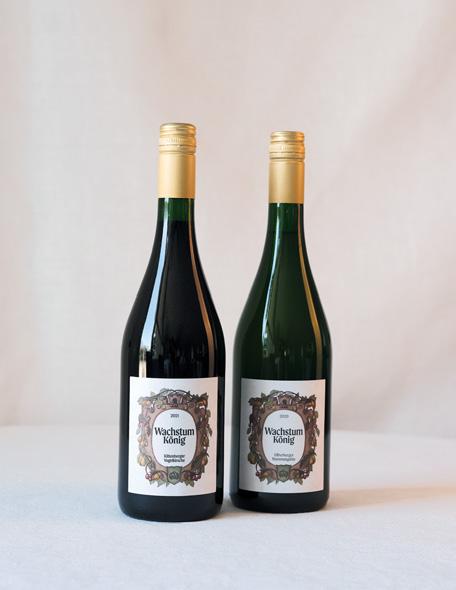
The motto is simple and sustainable: move away from commercialism, towards uniqueness. The family business “Wachstum König” is already in the third generation, run by the two brothers Herbert and Karlheinz König, which was founded by grandpa Fritz, a visionary in matters of high-altitude growing in Styria. The top priority remains thriving to adapt the various almost 100-year-old fruit trees even more perfectly to their terroir so that maximum results can be attained with only minimal intervention. For example, the Königs do not till the soil in the individual vineyards, and mowing is also sporadic, creating
a dynamic in the groves that brings out even better taste. The fruits from the bird cherry, giant quince and Conference pear trees are always harvested when they are fully ripe, i.e. when the phenols, acidity and sweetness are balanced and the aroma is fully developed. The fruit is then cold-pressed and bottled without any additives, unfiltered and unpasteurized. In short: a juice that packs so much punch that one normally only experiences with wine.
Available at the Steiereck store wachstumkoenig.at
8 S MAGAZIN SERENDIPITY

9
TEA FROM THE GUT
THE HERBS THAT GROW ON THE RESTAURANT TERRACE OF STEIRERECK ARE USED FOR THE HOUSE TEA BLENDS, BUT THEY ALWAYS VARY. THAT HAS A LOT TO DO WITH ANDREAS DJORDJEVIC’S GOOD INSTINCTS AND GUT FEELINGS.

About a decade and a half ago, Heinz Reitbauer Sr. suddenly stood in front of Andreas Djordjevic, also known as “Brot-Andi” of Steirereck. He had a few herbs in his hand and an idea in his head: “We need a tea trolley, please take care of it.” As everyone was rather enthusiastic about the subject, Andi threw himself into the task accordingly. He visited tea houses, learned from and at herb suppliers, obtained technical literature – and started creating his blend. Today, it’s a fine-tuned process – the herbs (various types of mint, basil, lemon balm, mandarin sage, etc.) thrive in a separate area on the terrace, which means
that about 80 percent of the spring/summer herbs needed for the blends are grown on site. The herbs are “processed”, collected in pots, remixed week after week, and then tasted by Djordjevic and filled into jars as a tea blend. In any case, there is no recipe –also because the taste, ingredients and mixing ratio are always changing. “First and foremost,” says Andi, “it’s your gut feeling that decides.”
Herbal tea blend “Steirereck”, 35 g available for € 5.50 at the Steirereck shop.
10 S MAGAZIN SERENDIPITY
Menü zur Zeit
Wir bieten eine erlesene Auswahl an feinen Zeitmessern für Freunde der Uhrmacherkunst. Geschmackvolle Kompositionen und edle Zutaten zubereitet von den besten Uhren-Manufakturen der Welt. Ein Fest für Auge und Handgelenk. Als ausgewiesener Uhrenspezialist und als Familienunternehmen sind wir mit unserem Team und unseren Uhrmachern mit Leidenschaft für alle Horlogerie-Feinschmecker da - seit über 100 Jahren.




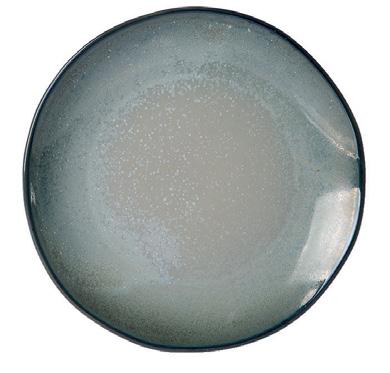
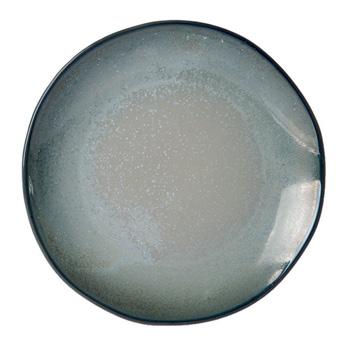






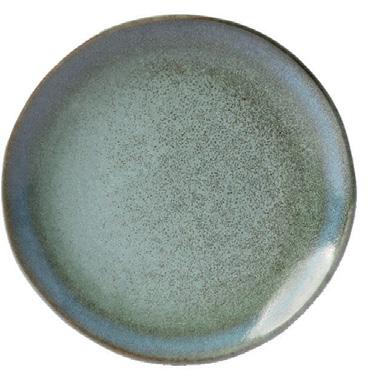
WIEN · GRABEN 28 LINZ · KLOSTERSTRASSE 2 WELS · SCHMIDTGASSE 16 01 / 533 80 65 0732 / 77 33 60 07242 / 21 17 17
www.zeit.at
Baume & Mercier Riviera
JAEGER-LECOULTRE BOUTIQUE - WIEN
ZENITH Chronomaster Sport
Piaget Polo
A. Lange & Söhne KLEINE LANGE 1
Ulysse Nardin Torpilleur
TIME FOR MATURITY
WITH SPARKLING WINES, THE RELATIONSHIP BETWEEN QUALITY AND MATURITY IS PROBABLY MORE IMPORTANT THAN WITH ANY OTHER LUXURY FOOD.

Stefanie and Alwin Jurtschitsch, exceptional winemakers from Langenlois, take all the time they and their handcrafted wines need to conjure up the utmost enjoyment. A Grüner Veltliner was harvested for the first time in 2007, and only popped in May 2019 after twelve years of yeast storage – 120 bottles plus a few magnums went into this first batch under the name 2007 Sekt Grüner Veltliner “Steirereck Edition Vol. 6” Brut Nature, Weingut Jurtschitsch, and provided guests with a very special treat. In 2020,
the next 120 bottles were released, and in September 2021, the third and last batch to date. The even longer yeast maturation in each case gives this special edition an ever-increasing more depth and complexity. René Antrag, head sommelier at Steirereck, deliberately opted for Brut Nature for this collaboration: natural, utmost enjoyment unaffected by added dosage.
Available in the Steirereck shop for € 65.
12 S MAGAZIN SERENDIPITY



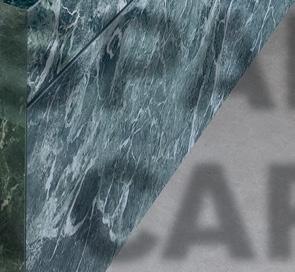


Saunadesign abgestimmt auf Ihr Wohn- & Wellnesskonzept
DEISL SAUNA & WELLNESS
LIEZEN | WATTENS | WIEN — um Terminvereinbarung wird gebeten: anfrage@deisl.com
@deislsaunawellness
A ROUND THING
“A BUNCH OF HOLES” IS THE NAME OF THE VISUALLY APPEALING AND FUNCTIONAL OUTDOOR FURNITURE ENSEMBLE FROM H+S ZAUNTECHNIK. IT WAS CREATED IN COOPERATION WITH MARTIN MOSTBÖCK, ITS “DESIGNER OF THE YEAR”.

The topic is omnipresent if you have a balcony, terrace or garden to call your own: small shower, big problem. Even if the rain clouds soon disappear, the furniture needs time before it can be used again. And, because we all like to sit down dry at the table, it’s great to be able to do it outdoors with our guests too. For this type of situation and others, the familyowned company H+S Zauntechnik from Raaba, in cooperation with star architect Martin Mostböck, has now released a furniture range that not only impresses with its cheerful colors, but also with its striking “hole” design. “A Bunch of Holes” consists
of a table and three stools and has several advantages: on one hand, the clever arrangement of the holes allows the stool legs to be inserted into the table, thus enabling you to stack the set of furniture in a compact and space-saving way. On the other hand, thanks to the hole structure (the holes are cut from stainless steel by laser cutter), the furniture is well ventilated and dries particularly quickly after rain.
A Bunch of Holes, outdoor furniture, stackable, powder-coated stainless steel Contact: sales@hs-zaun.at
14 S MAGAZIN SERENDIPITY
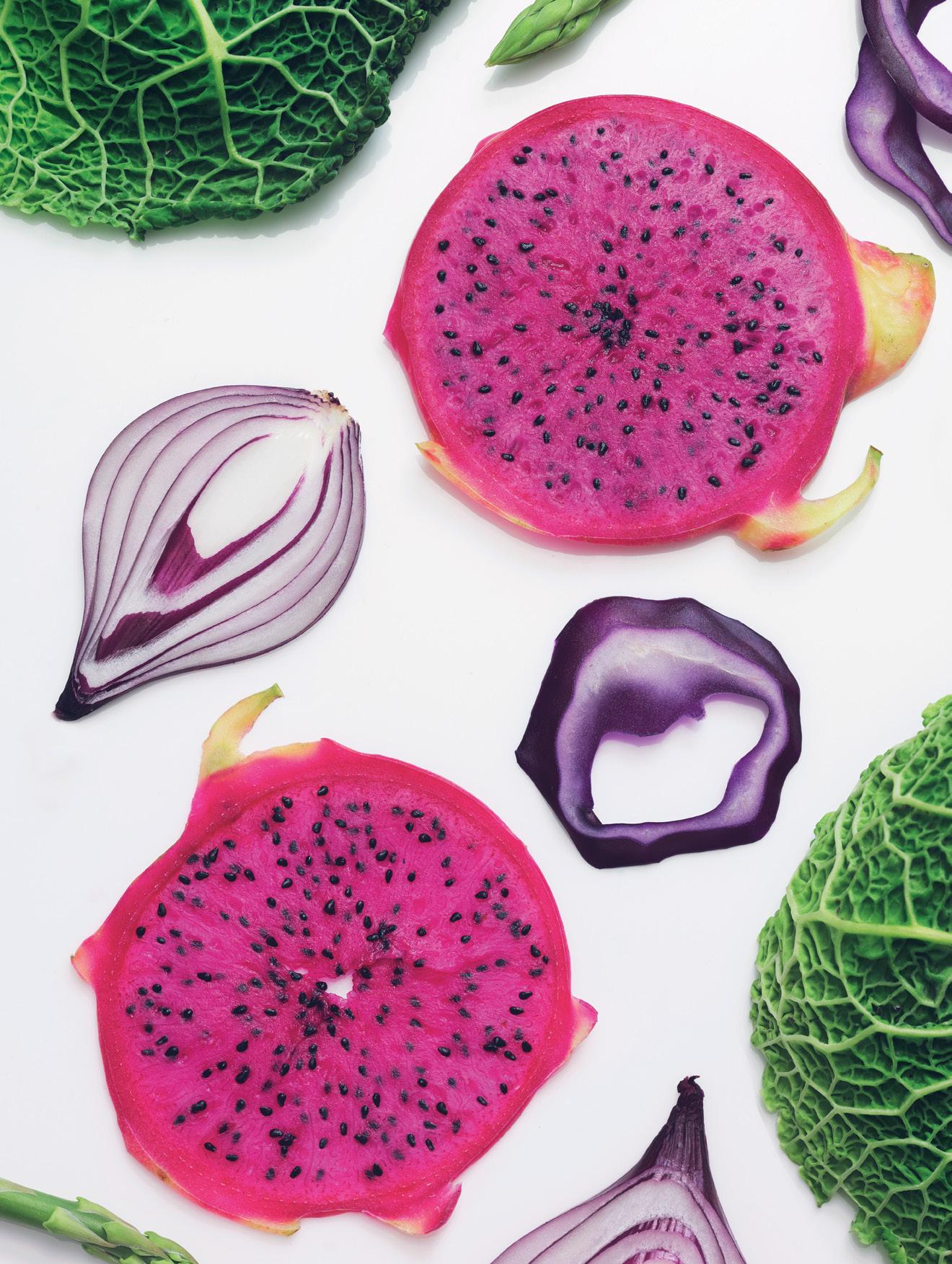
Das Wasser zum Essen.
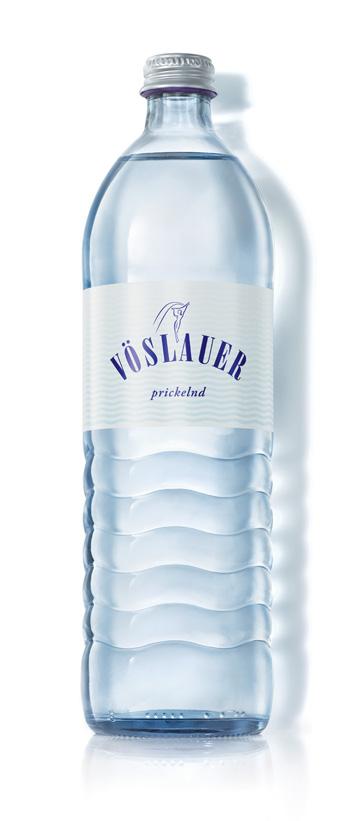
nachhaltig #jungbleiben
*50% der CO 2 -Emissionen ve r glichen mit 2005 r eduziert & 50% k ompensiert.
IMPECCABLE TASTE
VIRUS-RELATED HOURS SPENT IN LOCKDOWN ARE NOT ALWAYS BAD.
MICHAEL BAUBÖCK, THE SOUS CHEF AT STEIRERECK, PUT THEM TO GOOD USE AND LAUNCHED VM CERAMIC – A NOW VERY EXTENSIVE COLLECTION OF TABLEWARE.

No one knows better what a plate should be like than someone who sees them on a daily basis: Glazed or unglazed, raised lip or not – every dish requires the perfect base for harmonious serving. That’s why Michael Bauböck turned his hobby into a second profession two years ago – during the first lockdown – and now designs tableware branded as “VM Ceramic”. The idea didn’t come overnight, however, “because I’ve always had a soft spot for tableware,” says the native of Innviertel. “No matter where I traveled, I always brought dishes home with me.” The Steirer-
eck is close to his workshop, where he has his own potter’s wheel and kiln, and has now transformed a good three tons of clay into plates, bowls, dishes, platters and vases. It goes without saying that many a Steirereck creation is also served on a plate dreamed up by Bauböck. Other colleagues such as Paul Ivić (Tian), Konstantin Filippou or Fabian Günzel (aend) also rely on the know-how of the Upper Austrian all-round talent.
Info at: instagram.com/vm.ceramic/
16 S MAGAZIN SERENDIPITY



FORK-SIZED BITES
THIS STORY IS TYPICAL OF THE MAN: WHEN HE FELT THAT THE CUTLERY FOR THE SCHANKKUCHL AT POGUSCH WAS LACKING A CERTAIN SOMETHING, HEINZ REITBAUER IMMEDIATELY SET ABOUT CREATING IT HIMSELF – BASED ON THE PITCHFORK.

As far as the cutlery is concerned, there are no limits to its diversity: there is now an abundance of forks, knives and spoons with a wide variety of designs and materials. But, there again, there is that certain one that you look everywhere for in vain. In Heinz Reitbauer’s case, the lacking item was a special fork used in the Schankkuchl at the Steirereck am Pogusch for daintily picking delicacies from the platter at the communal table. Every problem has a
solution: Reitbauer consulted his trusted Viennese locksmith without further ado, worked with him to design a prototype that, after a few alterations and tweaks to the length and tines – is now used as a kind of pitchfork: three-pronged, 20 cm long and forged by hand from stainless steel.
Pitchfork, available at € 36,at Steirereck am Pogusch
18 S MAGAZIN SERENDIPITY
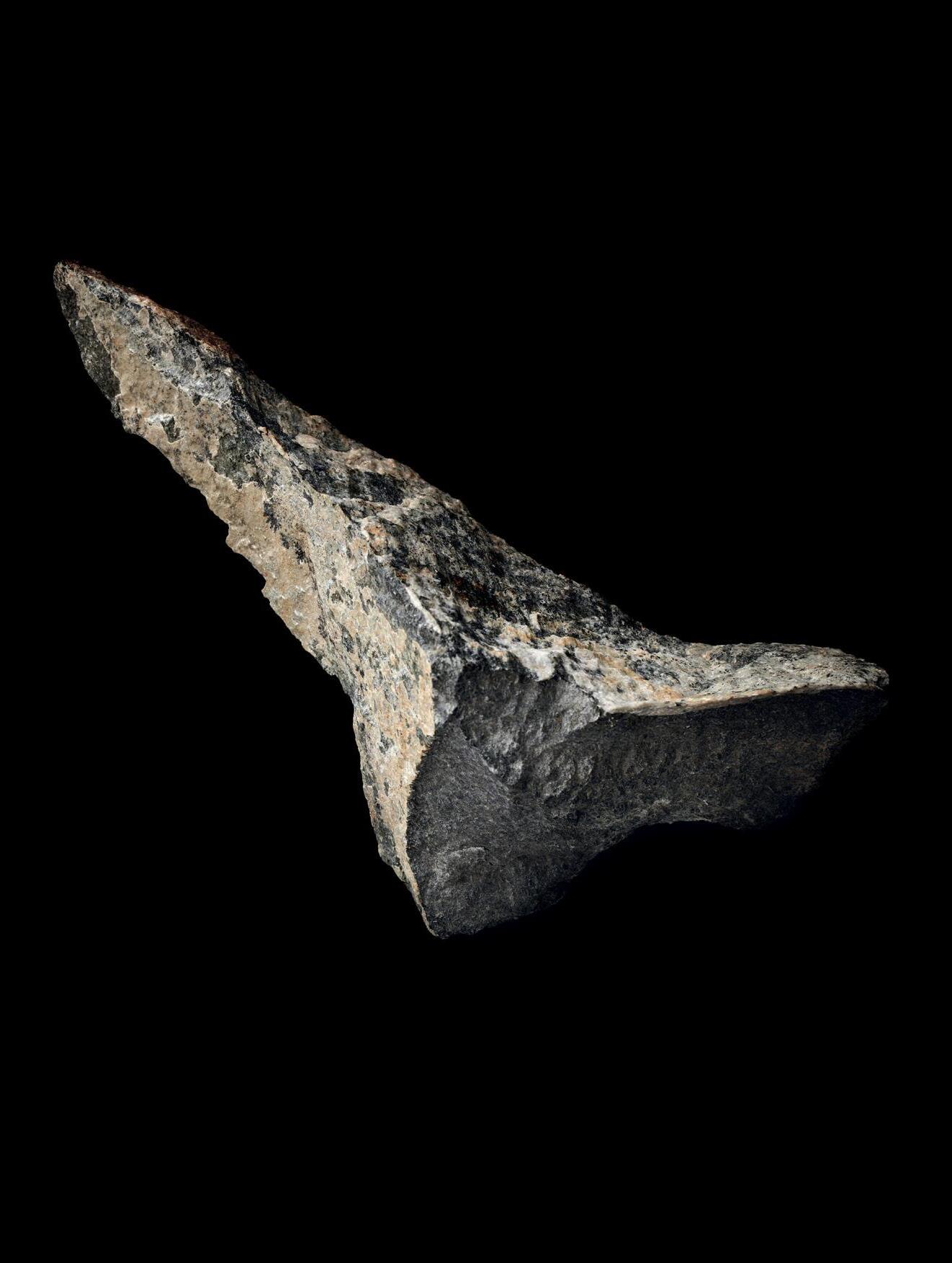



THE MAGIC OF FLOWING DIAMONDS
THE INSPIRATION FOR THE WAGNER COLLECTION RIVIÈRE IS THE LUMINOUS, FLOWING BAND OF LIGHTS IN THE NIGHT SKY ON THE FRENCH RIVIERA.

Fascination for diamonds is at the heart of this versatile collection – the most precious, coveted and beautiful of all gemstones. The closely set diamonds form a single sparkling chain of lights. The jewelry is designed in a sensually beautiful and timelessly elegant manner. Whether worn with a summer outfit at a girls get-together in the city center or for a romantic sunset duo on the terrace of a palazzo: Wagner Rivière guarantees a glamorous appearance.
The rings are made in 18 karat white gold, rose gold or yellow gold and are available in different
diamond settings. They can be worn individually or stacked in a three to five ring configuration, in a single or several gold colors. Jewel connoisseurs also like to complete the jewel set, which consists of a bracelet, earrings and a necklace. The original is signed with the blue Wagner sapphire engraved Wagner-W.
More information at juwelier-wagner.at/shop/en/wagner-jewels/riviere
20 S MAGAZIN SERENDIPITY
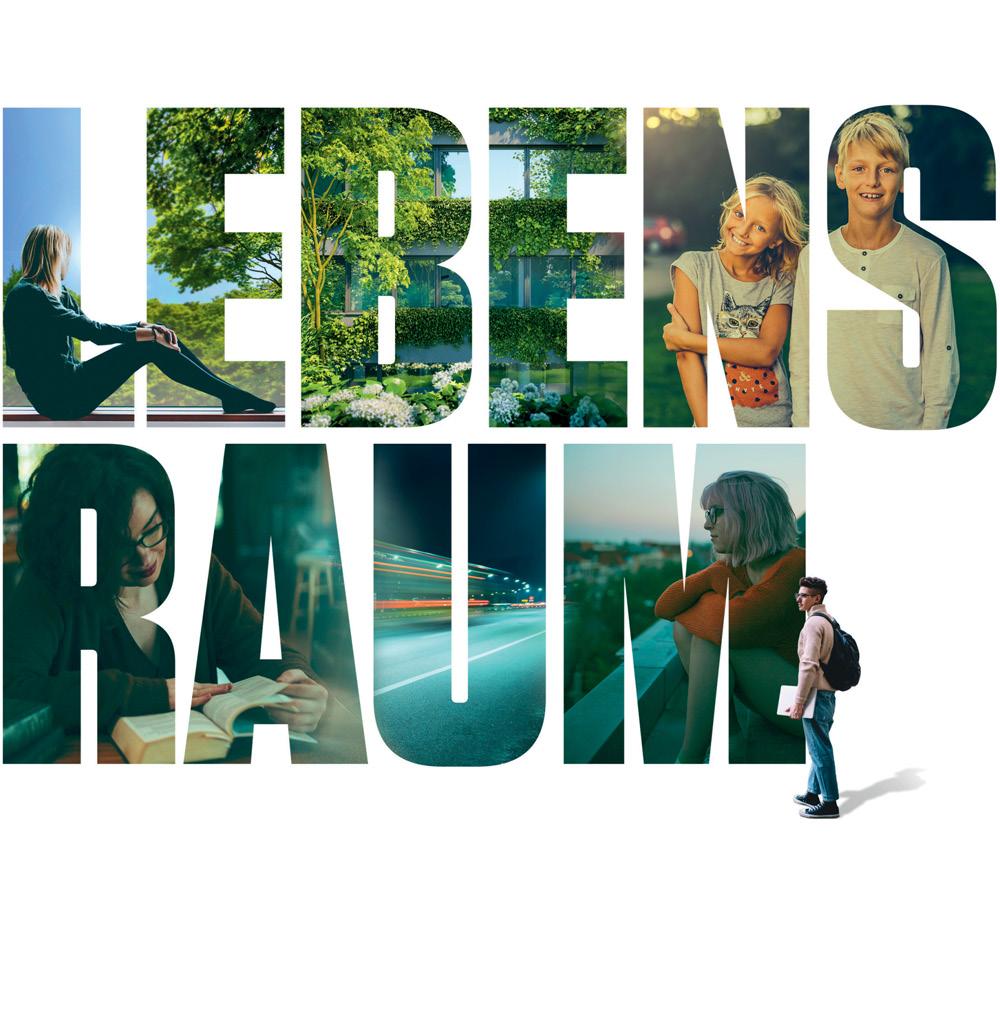
Die österreichischen Projektentwickler ermöglichen die Schaffung hochwertiger Lebensräume: Wohnräume, Arbeitsräume und Bildungsräume vom Kindergarten bis zur Schule und Universität. Sie erwerben Grundstücke, kümmern sich um Konzept und Widmung, beauftragen Architekten und Baufirmen, nehmen das Risiko auf sich und schaffen wertvolle Arbeitsplätze.
/lebensraumentwickler
BREAD WITH SOUL
AT STEIRERECK, NOTHING IS LEFT TO CHANCE. ESPECIALLY NOT THE BREAD. BIRGIT REITBAUER, THE LADY OF THE HOUSE, BAKES A VERY SPECIAL BATCH HERSELF SEVERAL TIMES A WEEK.


Let’s turn the wheel of time back a little. In those old days, an incomparable aroma filled the Steirereck at Pogusch twice a week when fresh bread was delivered, baked by a few farm women from the region. When one after the other retired four years ago, the decision was quickly made to bake the bread themselves in the future – and so this goal was pursued with the appropriate meticulousness. Birgit Reitbauer attended a bread-baking course in the Carinthian Rosental, read up extensively on the subject and set
to work. Today, she bakes 120 loaves of pure organic rye sourdough every week on a stone slab, refined with linseed, rye meal or sunflower seeds, seasoned with coriander, fennel, aniseed and ground Schabzigerklee, also known as bread clover. Baked in Vienna and at Pogusch, to be enjoyed in as pure a form as possible – best with organic butter from the private dairy Höflmaier.
22 S MAGAZIN SERENDIPITY

WOHNEN AM WEINGUT

WINZAREI
Familienweingut Tement
Zieregg 13 • A -8461 Ehrenhausen weingut@tement.at • www.tement.at welcome@winzarei.at • www.winzarei.at
IT’S ALL ABOUT THE SAUSAGE
IN FACT, THERE ARE TWO, NAMELY BLUTWURST AND BRATWURST, WHICH HAVE BEEN PRODUCED AT POGUSCH FOR A GOOD TWENTY YEARS AND ARE SERVED BOTH THERE AND AT STEIRERECK IN VIENNA.

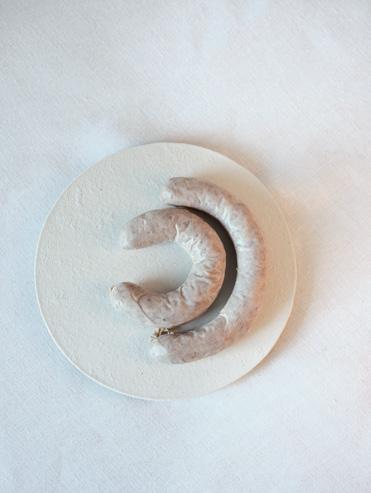
Once a week it’s slaughter day at Pogusch. Then Walter and Franz, the two gentlemen who run the farm there, get down to business and turn meat and other parts into specialties. We would like to introduce to you to two of them here in more detail, in particular the blutwurst (blood sausage) and bratwurst (fried sausage), which are considered by true connoisseurs to be incomparable delicacies. The basic raw material is a pig, more precisely a one-year-old Schwäbisch-Hällische-Duroc mixed breed, that has spent the whole year in the open air. Both sausages are stuffed in natural casings, and in terms of sea -
soning, normal table salt is used instead of pickling salt. The distinguishing feature of these blutwurst is that, in addition to the classic ingredients such as rice, white bread, spices and roasted onions, less blood is used, which makes them a little softer than usual. All sausages are already pre-boiled so that nothing stands in the way of immediate enjoyment. They just have to be thrown on the frying pan.
Blood sausage (2 pieces, 300 g, ready to fry) cost € 9.80, bratwurst (2 pieces, min. 200 g, ready to fry) cost € 8.50, both available at the Steirereck Shop.
24 S MAGAZIN SERENDIPITY

FOOD FROM A BOTTLE
WHEN THE FLOWERS AND HERBS AT POGUSCH HAVE DEVELOPED THEIR FULL POTENTIAL, THEY ARE PROCESSED INTO AN INCOMPARABLE LIQUEUR – “ALPENBITTER”. ON ONE HAND IT TASTES VERY GOOD, ON THE OTHER IT TASTES DIFFERENT EVERY YEAR.
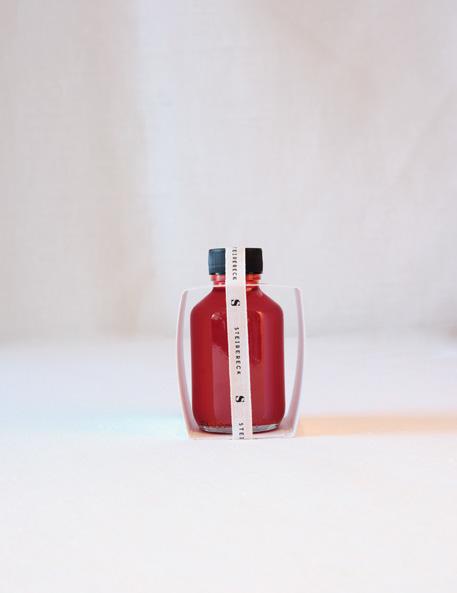
When the first blossoms and herbs unfold their power and splendor in the gardens of the Steirereck am Pogusch at the beginning of summer, the time has come for “Pogusch Alpenbitter”. The high-proof liqueur is not only made of at least twenty different flowers and herbs, but also contains extracts from a variety of roots and barks that grow in the Alpine region around Pogusch. However, at Steirereck, nature doesn’t only set the tone with respect to the ingredients, here they consciously prepare a drink that reflects all the whims of the respective year’s weather.
In this way, a different vintage is created year after year, just like with wine.
How should one best enjoy this powerful drink?
“Alpenbitter” can be served neat as a digestif (also on ice) or as a mixer with soda, orange juice, tonic or ginger ale as an aperitif.
Pogusch Alpenbitter, 100 ml at € 12,at the Steirereck shop
26 S MAGAZIN SERENDIPITY
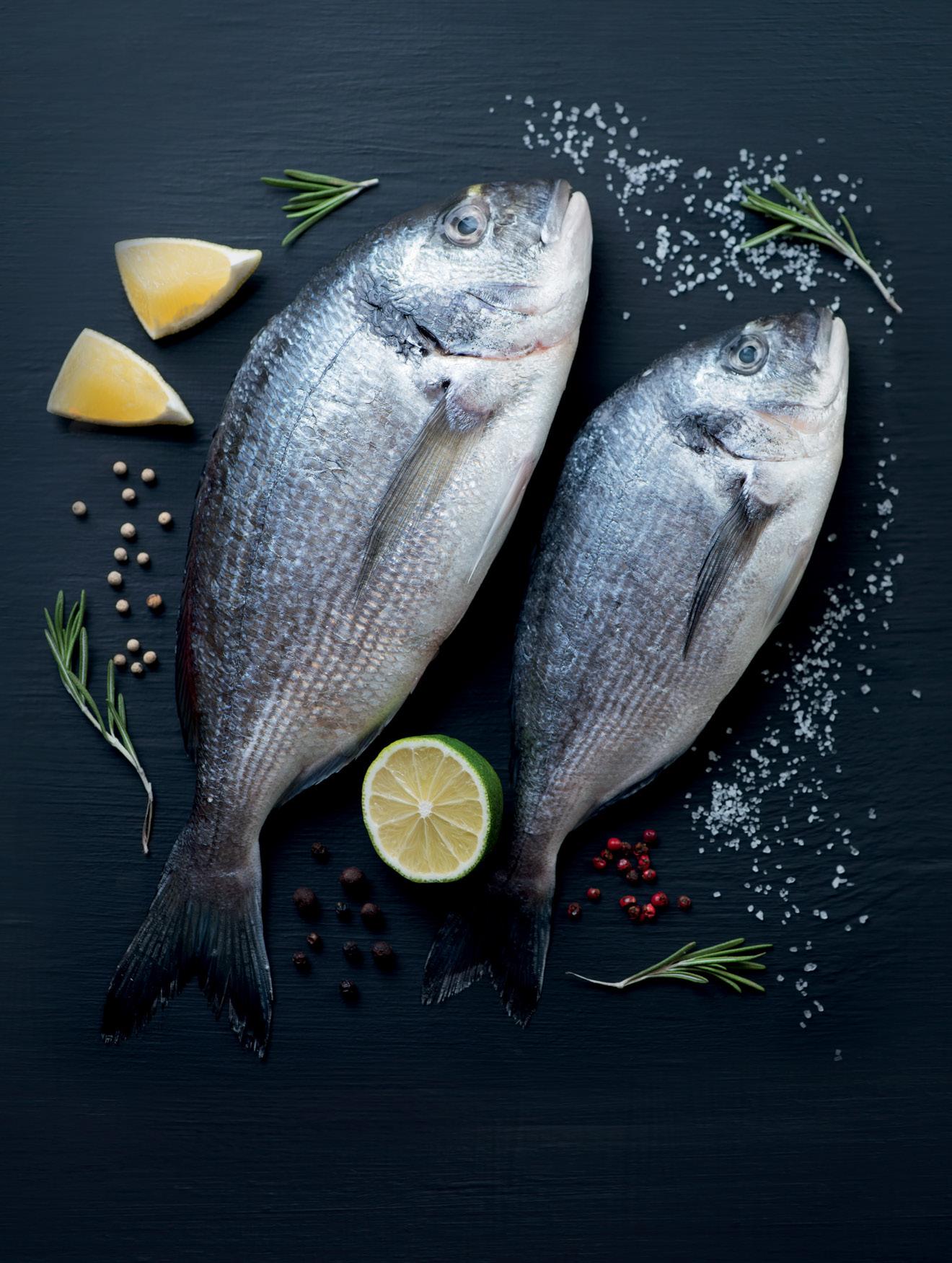
HARMONIE VON HIMMEL & ERDE
Genau wie ihre Reben ist das Winzerehepaar Katrin und Kurt Feiler tief und fest im Weinbau und in der Freistadt Rust verwurzelt.
Ihre Weine streben qualitativ nach den höchsten Sternen.
Biodynamische Bewirtschaftung seit 2008 ermöglicht Weinbau im Einklang mit der Natur
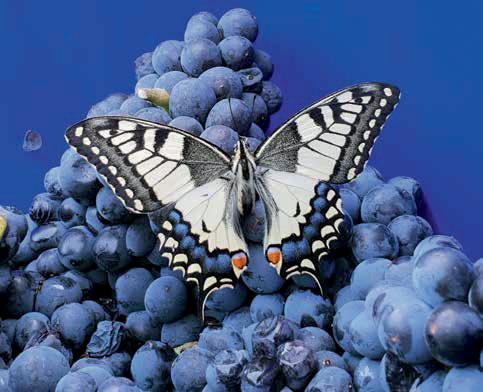

Nicht der Boden oder die Lage allein, sondern erst das Zusammenspiel mit der richtigen Sorte und dem Klima machen Weine einzigartig. Himmel und Erde haben ihren Einfluss. Der Weinbauer ist der Vermittler zwischen all diesen natürlichen Voraussetzungen. Die biodynamische Bewirtschaftung, die wir seit 2008 in unserem Betrieb anwenden, unterstützt mit ihrer ganzheitlichen Sicht und den Methoden und Präparaten den Einklang von Himmel und Erde. Sechs Präparate machen unseren Kompost vom Mist der eigenen Mutterkühe qualitativ noch besser und lebendiger, zwei Präparate (Hornmist und Hornkiesel) werden direkt in den Weingärten ausgebracht. Die Letzteren werden vor der Ausbringung eine Stunde
lang von Kurt Feiler mit seinem »Hexenbesen« dynamisiert. So ist auch der Winzer selbst mit all seinem Bewusstsein und seiner Individualität direkt in die Wachstums- und Reifeprozesse der Reben eingebunden.
Das Weingut Feiler-Artinger liegt mitten in der Freistadt Rust. Typisch für die Herkunft, bieten wir die ganze Ruster Trilogie in höchster Qualität: Weiß-, Rot- und edelsüße Weine (Ruster Ausbruch). Der Neuburger ist die Lieblingssorte und das Steckenpferd unter den Weißweinen. In Rot dominiert der Blaufränkisch. Wir bieten ihn in allen Facetten und Ausbauvarianten an, ganz neu auch einen Leithaberg DAC Ried Ruster Oberer Wald! Ein Geheimtipp des Winzers im Rotwein-Sortiment ist aber der Cabernet Franc!

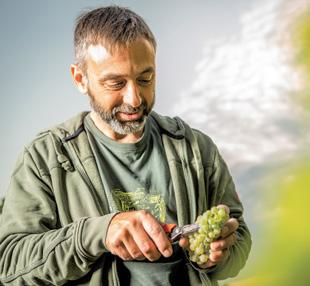


R USTER AUSBRUCH DAC
Die neue bedeutende Jahreszahl neben 1524 und 1681 für die Freistadt Rust und den Ruster Ausbruch ist 2020. Die Ruster Spezialität wurde als erster Süßwein Österreichs ein »regionaltypischer Qualitätswein mit Herkunftsprofil«, besser bekannt unter der Abkürzung »DAC«. Bei uns im Weingut gibt es mit dem heuer neu auf den Markt kommenden Jahrgang 2018 gleich vier Ruster Ausbruch DAC. Rust am Neusiedler See besuchen und himmlische Weine von Feiler-Artinger genießen!
Weitere
falstaff 45 mai 2021 WEINGUT FEILER-ARTINGER ADVERTORIAL Fotos: © Martin Fülöp; beigestellt INFO
Informationen
feiler-artinger.at
unter
A common expression in Austrian German is “Red’ keinen Holler,” which means “Don’t talk nonsense” And if it’s spectacular nonsense, people like to use the intensified form “Vollholler” (full holler). But you will learn from A to Z that the elder plant has done nothing to earn this dubious badge of disparagement. Before that, we will be talking to a Zackel sheep breeder and a stove builder. And they have a lot to tell, but won’t be talking any holler or nonsense.
Who & why
S.
30 ONE SHEEP TO GO, PLEASE!
TO SAVE
S. 52 EAT WHAT YOU WANT
S. 38 THE MAN WHO GETS ALL HOT FOR FIRE
S. 46 DOUBLE SEASON
1 S MAGAZIN MAN & BEAST, FLOWERS & BERRIES 29

ONE SHEEP TO GO, PLEASE!
SEBASTIAN HOFER PHOTOS: PHILIPP HORAK 30 S MAGAZIN HIGH PLEASURE
TEXT:
HE WHO DANCES WITH THE ANIMALS –AND THEN GOES HIS OWN WAY: HIGH UP, INTO A BETTER LIFE WITH THE ÖTZTAL MOUNTAIN FARMER AND TASTE PIONEER MICHAEL WILHELM.

31
03–04 Among insiders, the Windach Valley high above Sölden is also called Little Canada. The comparison is not far-fetched.
“There you will delve into a world that hasn’t existed for 50 years,” promises Wilhelm a few days before the visit to the furthest end of the Ötztal valley. In the world Wilhelm is referring to, the houses are made of stone and wood and were built by their inhabitants themselves. The food is prepared on a stove, under which a fire blazes. There is smoke in the kitchen, the chickens look over your shoulder as you cut onions, and they are glad that today there is only mushroom gröstl. The Gröstl consists – with the exception of the onions – of ingredients that the cook found and collected not even five hundred meters up the road. Amazingly, there is relatively good cell phone reception in the world we are talking about here. When he feels like it, Michael Wilhelm even picks up the phone. When he doesn’t, he doesn’t. There are more important things. The animals, for example.
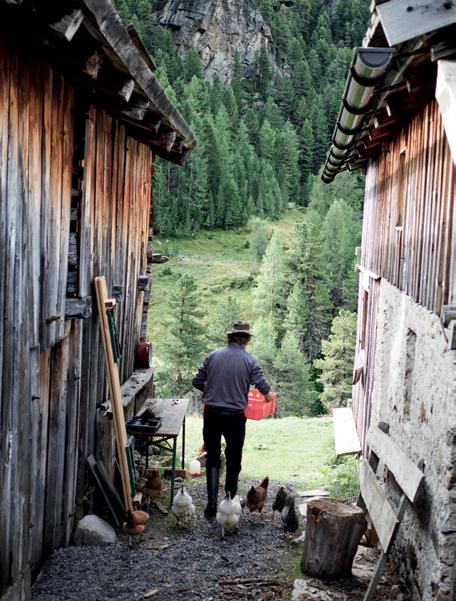
Michael Wilhelm is a mountain farmer in Tyrol. He raises sheep, cattle and yaks, and not only the latter indicate that he does many things differently than others. He’s been doing it this way for almost 30 years now. Michael Wilhelm was only 16 when his parents died and he, who actually wanted to become a sculptor, had to take over the farm. His parents had run a traditional dairy farm run according to classic Tyrolean mountain tradition, so not really the thing for Michael the maverick, who went his own road in those years. He searched for animals that are exactly suited to here, the upper Windach Valley. He found ancient breeds like the Zackel sheep, the Tux cattle and then he found the yaks that now live a visibly contented life here, on the alpine meadows above Sölden.
The Wilhelm’sche Windachalm is located at 1990 meters above sea level and was built by Michael’s father 70 years ago. The Gaiskogel towers some 3129 meters high to the front, a pair of bearded vultures breeds on the opposite slope and, behind the alpine hut, Michael Wilhelm’s chickens peck in the lush meadow. They are Swedish Flower and Steinpiperl hens, because Michael’s penchant for the unusual and special is not limited animals with hoofs.
“You will delve into a world that hasn’t existed for 50 years”
But now it’s first off to the high alpine terrain. At least that’s what Michael Wilhelm says, with a grin that’s hard to interpret. He doesn’t want to be more specific, because: “Sometimes it’s better if you don’t know what’s going to happen beforehand.” The farmer merely casts another glance at his visitors’ shoes, “Ah well, it’ll do”. He himself wears rubber boots with grandiose naturalness. And then it really does go steeply uphill, and Michael Wilhelm just lets things happen. He has the calmness of those who know that they cannot force nature, but can understand it. He has an eye for the wonders of this world and a sharp mind that likes to branch off in unexpected directions. Michael Wilhelm is introverted in a productive way, he doesn’t talk too much, but when he does – goodness! He talks about the past: “A thousand years ago, rye was still grown up here. The high alpine pastures were permanently populated.” In fact, there was extensive grazing here as early as 8,000 years ago. Among insiders, the Windach Valley is also called Little Canada, and the uninitiated will not understand this comparison
32 S MAGAZIN HIGH PLEASURE

33
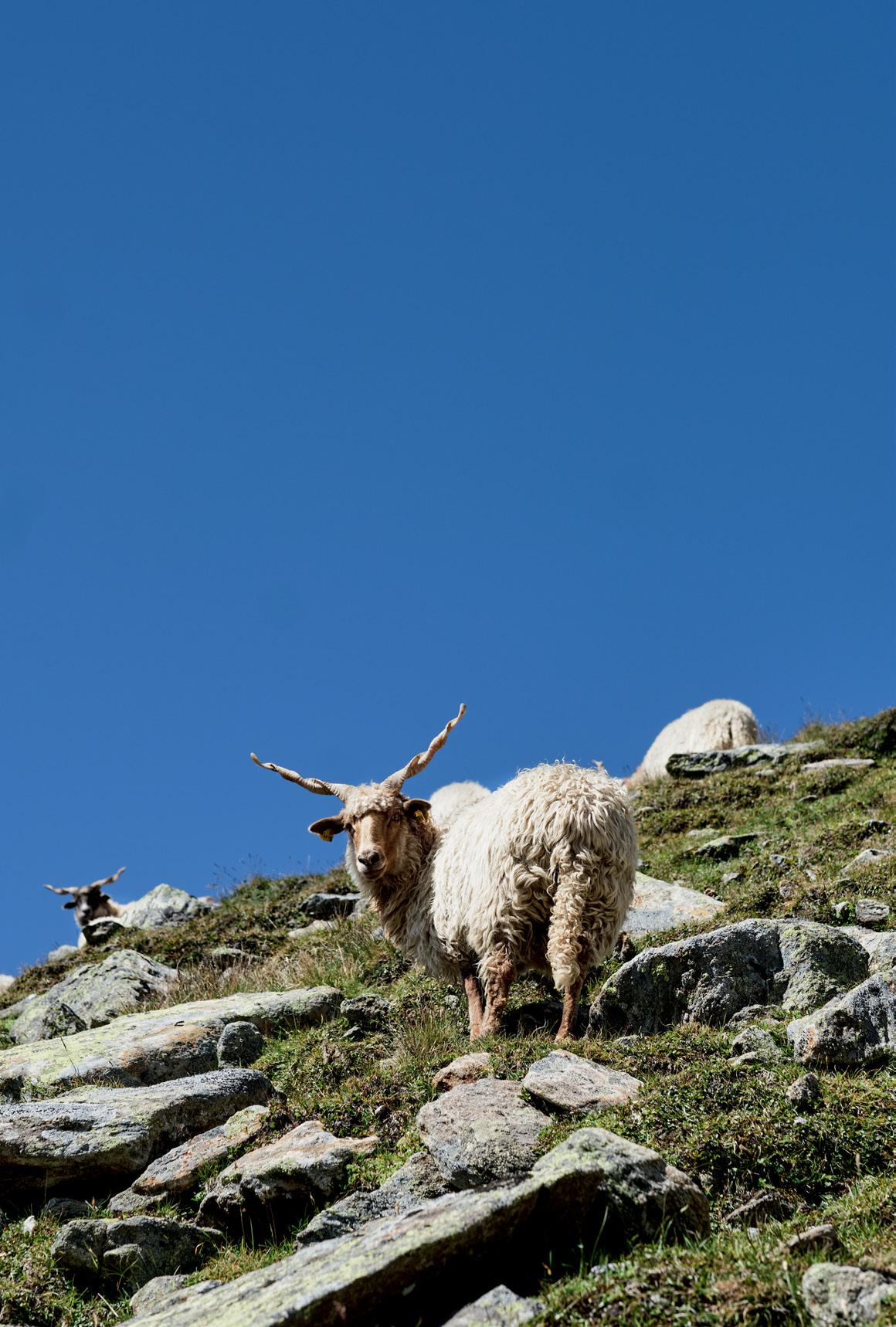
34 S MAGAZIN HIGH PLEASURE
05–06 At the end of April, the animals are driven up the mountain, where they live and graze completely independently until autumn.
until a second glance. The water bubbles from every pore, the slopes all around outdo each other in the variety of their green hues. A marmot sounds the alarm, a flock of mountain sheep – not Michi Wilhelm’s – trots along with us for a few meters until their hopes of an extra feed fade. The bearded vultures spiral up into the thermals. The Alps are really putting on their best for us today!
The Zackel sheep can be easily recognized by its screw horns and horizontally protruding ears, even by mountain-farming laymen – if they get close enough. It is also very shy, quite robust and frugal. Its history goes back at least 5000 years. Hungarian Zackel sheep were also a widespread farm animal in the alpine region until the 18 th century. But then times changed and alpine agriculture became more intensive. Michi Wilhelm doesn’t care, he just does it differently, or rather like back in the past. His animals are driven up the mountain at the end of April, where they live and graze largely on their own. In the fall, usually around the beginning of October, they slowly come down from the higher altitudes, but they still have to be driven down into the valley proper. This is a task that requires quite some energy, because herding dogs are not common in the Ötztal. They just wouldn’t have existed here in the past, says the sporty shepherd: “How could the people here have fed a dog when they often didn’t even have enough for their own children?” It was a poor area and a hard life lived very, very close to nature. Basically, Wilhelm herds wild animals up here. That’s also why they are so much better suited to life on the mountain than more recent breeds, and also why their meat tastes so special, like lamb, game and high-mountain pasture; it’s dark red and clearly marbled, short-fibered and adorned with a distinctive layer of fat. Only about ten percent of his flock is slaughtered each year, which can be lambs or young sheep, but now and then also two– to three-year-old castrated rams. In reality, only the shepherd himself knows which of his sheep will taste how and when. The differences can be enormous, depending on the feed supply, age and feeding range of the animals.

If Michael Wilhelm had to present a business plan to a bank, he wouldn’t get very far with what he’s doing. Extensive breeding of wild grazing sheep, yaks and old breeds of cattle is not a very lucrative business model, the effort in relation to the yield downright insane – unless you factor in the enjoyment that becomes possible in this way and, of course, the quality of life of the mountain farmer himself. Michael Wilhelm assures very credibly that he would not want to trade places with anyone in this world.
With its curved horns and ears sticking out horizontally, the Zackelschaf is easy to recognize even for people who don’t know anything about the mountains.
We are still going uphill, Michael Wilhelm’s sheep must be somewhere up there, but even he himself can’t say exactly where. The grazing area of his animals covers about 200 hectares. But then: Something moves in the scree, high up, almost on the rocky ridge. A good 60 sheep, black, white, mixed. We are now at 2500 meters altitude and Michael Wilhelm makes contact: “Behbehbeh! Coooome heeere!” The sheep prick up their ears.
35

Along the way, Wilhelm shows what the mountain has to offer. No alpine meadow is like any other, and no alpine meadow looks exactly like it was just two weeks ago. There is constant change, a constant rhythm, a constant, persistent growth under not so adverse, but still very special circumstances. Michael Wilhelm shows us the eyebright plant, which helps against inflammation, he picks sand thyme and silver thistle, whose heart can be eaten like an artichoke, which is why it is called hunter’s bread. “And there, look, that’s also a super story”: wild juniper, which has a splendid aromatic taste up here because, when it matures, it just doesn’t shoot up, but only grows a few centimeters per year in the high alpine conditions. The flavor doesn’t spread, it condenses. “Do you notice it?” You notice it: at first the taste reminds you of blueberries, then comes a peppery note, then something slightly bitter; the actual juniper aroma follows only after 30, 40 seconds – before that, the palate has already had a full technicolor experience. Then Michael spies something else out of the corner of his eye, staggers across the slope and returns with a satisfied grin and much booty: “Redcap boletus mushrooms. Absolutely noble specimens, grown at 2200 meters above sea level. That would be something for Heinz.” He means Heinz Reitbauer, for whom he expresses honest respect, which one should understand quietly as a distinction. Because when it comes to the taste and the handling of the local products from the meadows and pastures of the Windach Valley, the mountain farmer, who is otherwise quite in the mood for a joke, has no sense of humour at all. He knows all too well the natural and human effort that goes into these products, the potential they hold, be it the wild juniper or the meat of his Tux cattle, which has unparalleled finesse, but which also needs the right person in the kitchen who knows how to handle it and lure out its charms. Unfortunately, says Wilhelm, not every chef or cook is blessed with this understanding, and certainly not with this very special regional knowledge concerning the relationships between these products, the micro-seasonal interplay of meat, herbs, spices, water, sun and air. “If you taste closely, you’ll notice that the water from each spring tastes a little different. And the spectrum only gets bigger from there. But to work that out, you need experts, and unfortunately there are too few of them. Heinz is one of them, and so is Thorsten Probost.”
“The mountain farmer never jokes when it concerns the taste of his products.”
Then, Michael Wilhelm shows that he is also one of those experts, and fires up the oven at Windachalm. The ceilings are low, the equipment and dishes are spartan. And there, in a stained cast-iron pan, a mushroom gröstl is created like no other, so ultra-regional and micro-seasonal – just a joy, seasoned with beef fat, sand thyme and nettles, accompanied by a top German Riesling, which Wilhelm fishes out of his pantry as a matter of course – all of the above seasoned with lots of unprintable tales from Ötztal mountain farming life. During this, slowly the awareness matures that although one has landed here in a world that hasn’t existed for fifty years, it can exist again if all goes well. You just have to stray from the right path.
07–08 And then Wilhelm cooks a mushroom gröstl like no other – because his ingredients only grow up here.
36 S MAGAZIN HIGH PLEASURE
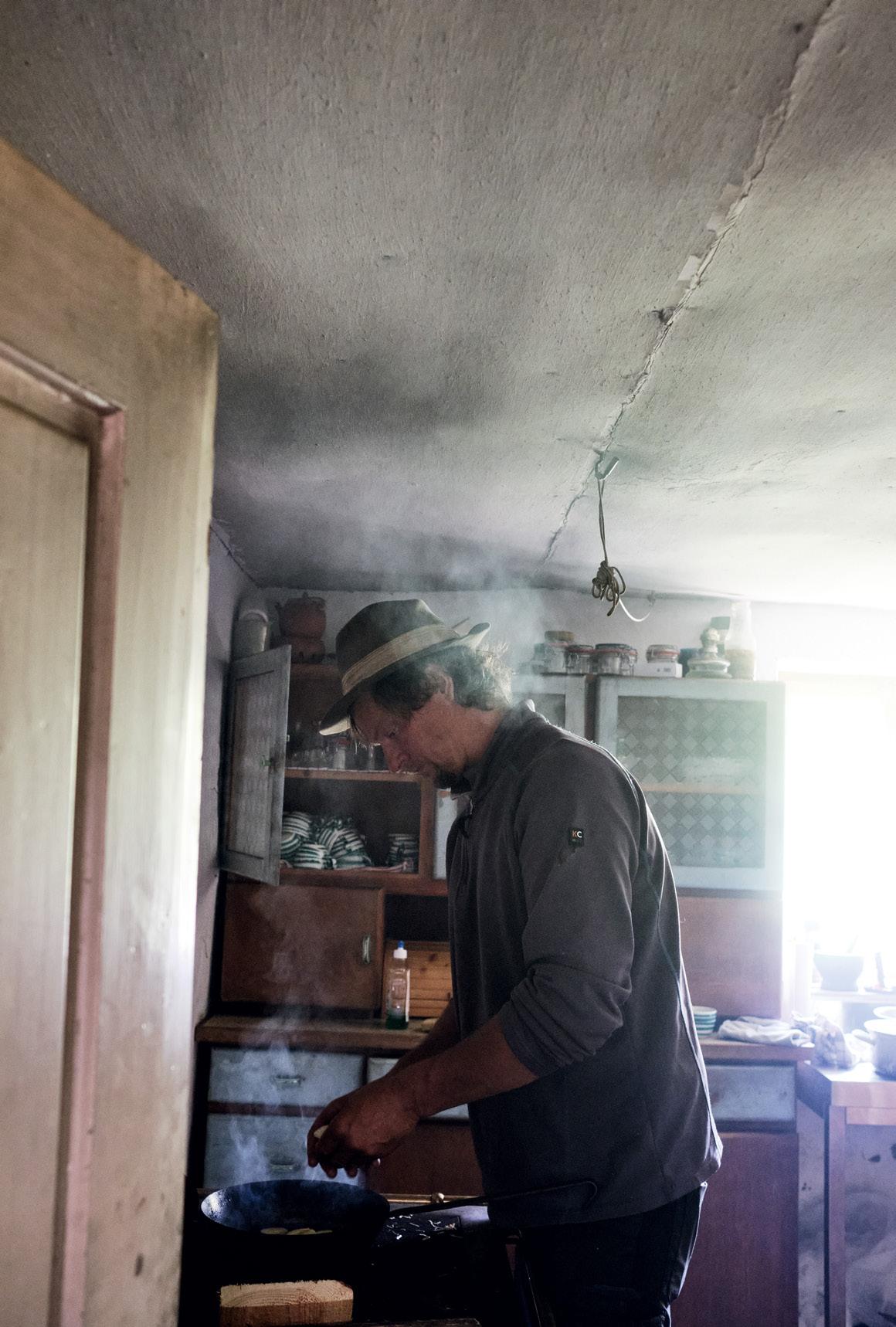
37
GEORG LINDENBAUER BUILDS PERHAPS THE MOST SPECTACULAR WOODBURNING STOVES IN THE WORLD. NOW HE’S BEEN DISCOVERED BY THE WORLD OF HAUTE CUISINE.
TEXT: TOBIAS MÜLLER
THE MAN WHO GETS ALL HOT FOR FIRE
 PHOTOS: MIRCO TALIERCIO
PHOTOS: MIRCO TALIERCIO
38 S MAGAZIN FIRE DISPENSER

39
One could simply call Georg Lindenbauer a stove builder. He himself prefers to say that he is the “most significant representative for ‘heatable’ large sculptures”, and his website is called Heizobjekte. at . This is meant to sound funny, but is neverthe less meant seriously. However, you’re mistaken if you think you’re dealing with an aloof artist. If you ask him what a good stove is, he says, “It has to work and look awesome.”
His “heatable large sculptures” have as much to do with ordinary stoves as a Steirereck dish has to do with a sausage roll. Some look like organic forms grown in a galactic jungle, some like alien heads, others recall designs by Mies van der Rohe or Le Corbusier. Some almost pass for traditional tiled stoves, some have crazy surfaces, such as clay that he beat with a riding crop before drying.
He builds small stoves, just shoulder-high, and ton-weight SUV-sized structures that seem to float and rotate weightlessly. Some are so eye-catching that they take up the entire room, others disappear seamlessly into the wall so that only the fire chamber is visible.
It is therefore difficult to speak of a Lindenbauer style – “I am constantly improvising, every stove is a prototype,” he says. If you look for common features, you’re most likely to find a simple, functionalist elegance, beautiful proportions and a certain penchant for a space aesthetic reminiscent of Stanley Kubrick’s “2001: A Space Odyssey.” He does a pretty good job of “looking awesome”.
Heinz Reitbauer’s latest project could simply be called a barbecue restaurant; he prefers to call it “Schankkuchl” himself. The Steirereck boss has remodeled the Wirtshaus am Pogusch and created an open kitchen with a large communal table next to the inn. There he serves his guests almost only dishes that come straight from the fire: Grilled sturgeon with artichoke, grilled sweetbreads, fire-kissed pork tails and pheasant. The stove that makes this possible is Georg Lindenbauer’s work.
“When we rebuilt Pogusch, we definitely wanted to be able to cook with fire,” says Reitbauer. “After all, an open fireplace is the most typical thing Styria has to offer. And you can’t get the taste you get from cooking with wood with anything else.” And
01–05 Lindenbauer is one of those people who create rather than slave: his furnaces are created from scratch.


40 S MAGAZIN FIRE DISPENSER
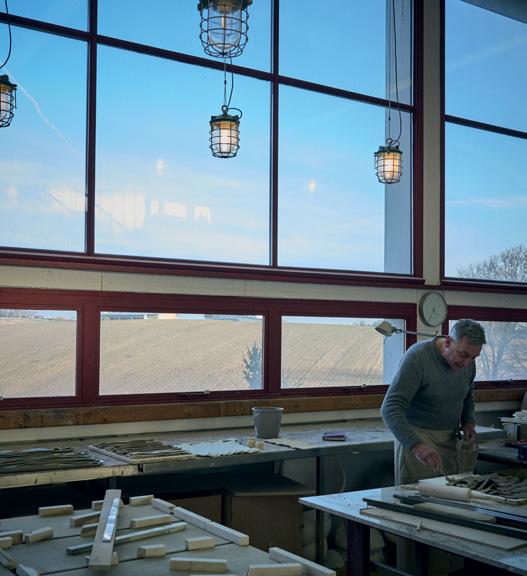

Each Lindenbauer stove is unique and handmade. He makes most of the parts in his workshop in an old gymnasium in Stadtschlaining in Burgenland.
because the stove had to be really good, Reitbauer, the exceptional chef, called Lindenbauer, the exceptional stove maker. It wasn’t the first cooking stove for the artist – he’d already built around 20 – but it was the first of this dimension.
Lindenbauer designed a “fire machine” made of steel and brick for Pogusch, weighing 13 tons and eight meters wide. When it runs at full power, 7800 cubic meters of air pass through it every hour, the volume of six single-family homes. The construction is a bread oven, stove, grill and rotisserie all in one and is fired exclusively with wood. A powerful exhaust ensures that the aroma of grilled food stays on the food and doesn’t smoke up the guests.
The cooks have two ovens with different temperatures at their disposal, about two square meters of hot plate, four grilling basins with height-adjustable grates and an area where coals can be grilled vertically, as if for a kebab skewer. “It’s like learning to cook all over again,” Reitbauer says. “And there are a lot more possibilities than we thought.”
In the morning, at around 8:15 a.m., the main stove is fired up, the basis for a good day. Then it is
regularly refueled and embers are shoveled here and there, or extra kindling is added with a small fan before the meat is added on top. Not only is bread baked in the baking pipes – skewers are also braised there and whole fish hang under the exhaust, which are smoked very slowly and gently here. “Analog cooking” is what chef Manuel Weissenböck calls it. “It’s a challenge, but makes you insanely proud.”
Like all Lindenbauer objects, the Poguschofen is a prototype, something never seen before. Lindenbauer and Reitbauer worked together on the model and came up with various features. Some functions, like the ovens, work great whereas some, like the heat recovery for the hot water, still need a tweak –but all in all, the oven is an amazing machine.
Applied physics is required to make the stove look awesome and be functional. As with all stoves, the size of the surface and the interior must correspond, the chimney must not be too long and not too short, and most importantly, there must be enough draft.
41
06–07 The three height-adjustable grates and the vertical fire basket are only part of the oven at Pogusch: to the left of them adjoins the bread oven, to the right the wood-fired cooking unit.
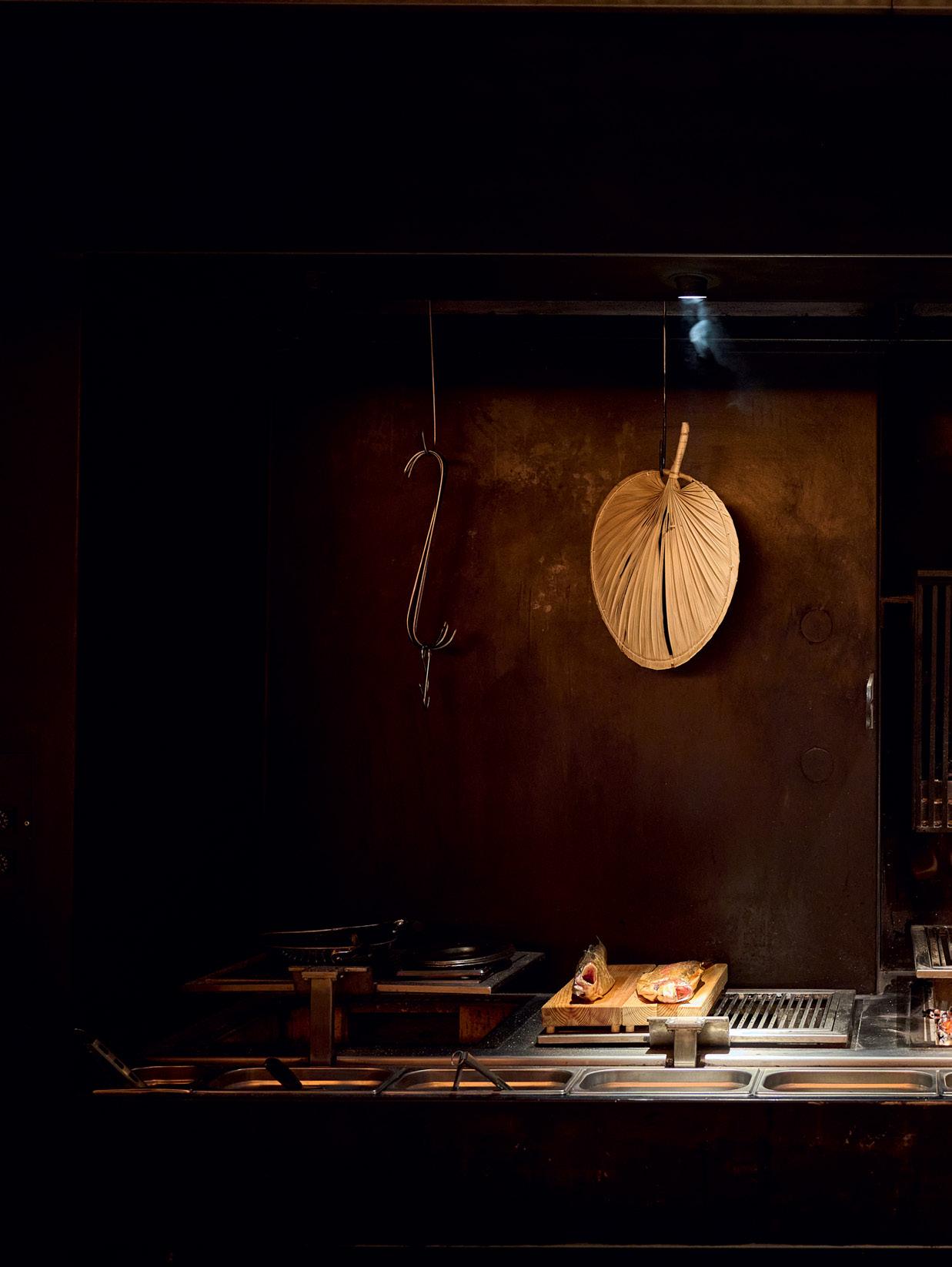
42 S MAGAZIN FIRE DISPENSER
Lindenbauer has designed a steel and brick “fire machine” for Pogusch, weighing 13 tons andeight meters wide. When it runs at full power, 7,800 cubic meters of air pass through every hour, the volume of six single-family houses.
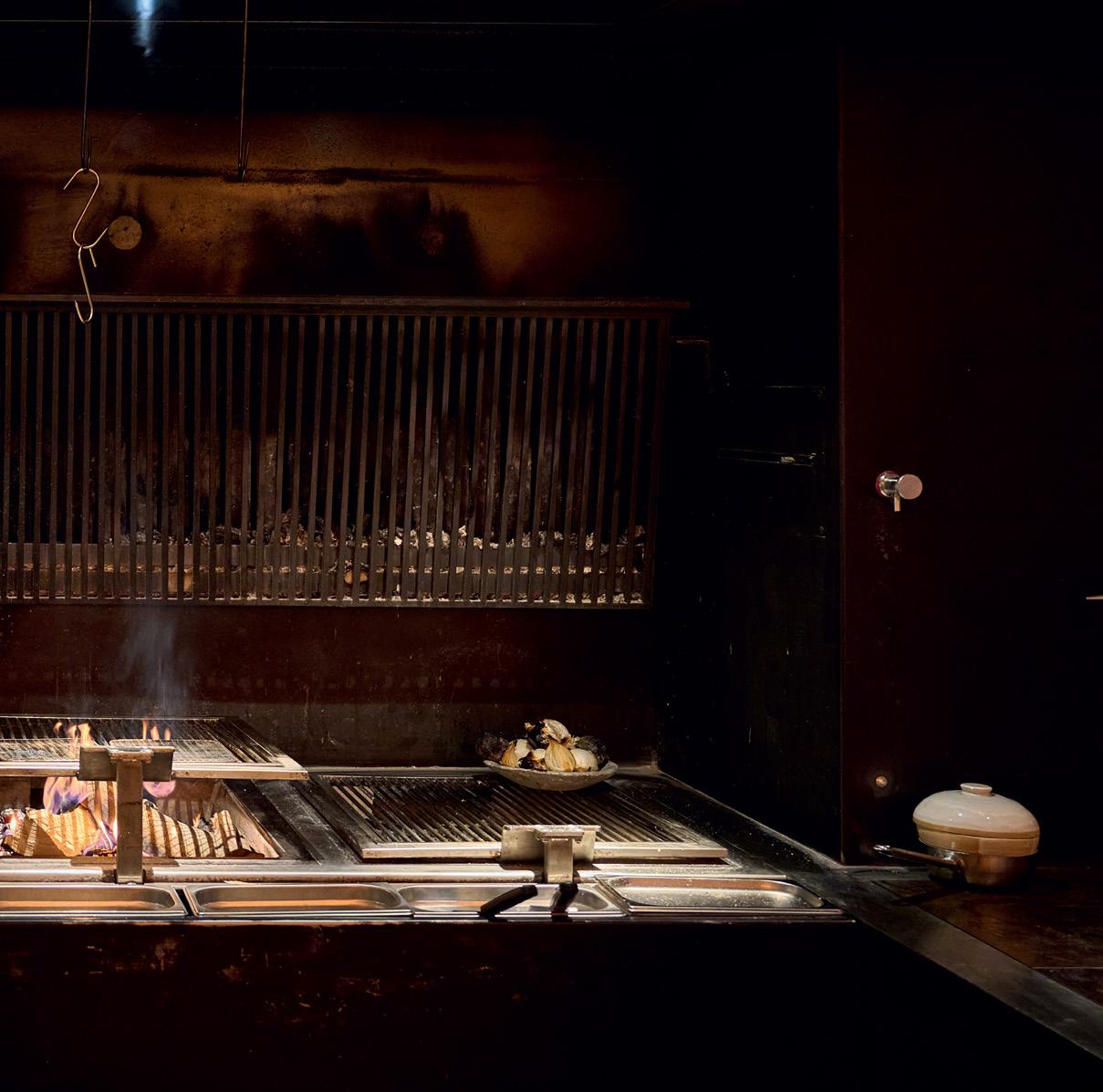
43
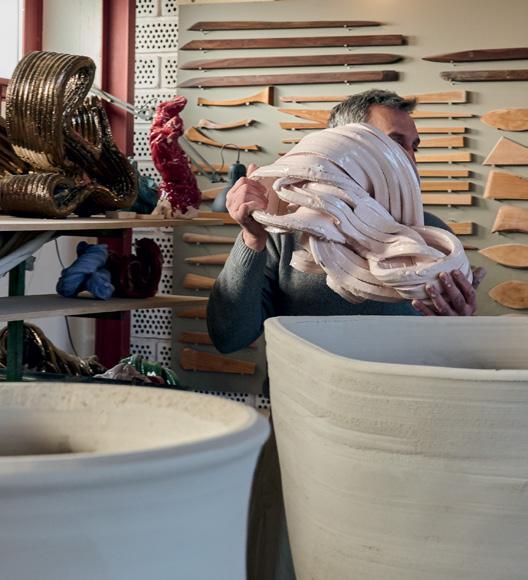

Behind the fireboxes, Lindenbauer has built a precisely calculated labyrinth of winding, increasingly narrow passages. As this means that the same amount of hot air has to pass through narrower and narrower openings, the flow velocity becomes higher, just like at a narrow point in a river. This ensures that the fire blazes properly.
Lindenbauer has built hundreds of furnaces over the 35 years since he started doing his job. The stove builder says that there about 60 in Klosterneuburg, where he lived for a long time, while the rest are dotted around the world. That gives you a pretty good idea of how much the man works and how quickly he lives, thinks, speaks and moves. Sometimes he sleeps only three hours a day for months at a time, doing nothing but pottering, firing, eating, drinking and smoking. “I have an extreme capacity for suffering,” he says.
Lindenbauer is one of those people who create rather than slave. Once he lets go, he begins to shape the world around him, to change it and to design it according to his ideas. His kilns are created from scratch. He works with steel, bricks, wood, ceramics, or whatever else comes his way. He cuts, welds, saws, potters and fires his own ceramic tiles and bricks,
mixes glazes, builds and draws models. For one project, he kneaded 425 tons of clay by hand because machines just can’t do it that well.
He even builds the kilns in which he hardens the ceramic parts himself – there’s no other way, because they can’t be bought in the size he needs for his meter-high sculptures. And he also built a good part of his studio himself.
Lindenbauer attended a ceramics school in Graz, but his successful stove builder career is thanks to his self-confidence and a nice coincidence. In 1985, as a young man, he hitchhiked to Vienna, and the man who gave him a ride asked him if he could build a tiled stove. Lindenbauer, who had never built a tiled stove before, said yes. When he put up photos of his work at his next ceramics exhibition, he sold seven stoves in one weekend. Since then, taming fire has not released him from its spell.
He has become even more self-confident over the years because the world, when he wants to shape it, usually obeys him. “That could also be in the Guggenheim,” he says of one of his works, and he doesn’t shy away from comparisons with Wassily Kandinsky and Paul Klee. When, at 27, he was offered
44 S MAGAZIN FIRE DISPENSER
10 Lindenbauer even builds the kilns (right) for his ceramics himself, so that they meet his unusual requirements.
an assistantship at the University of Applied Arts in Vienna, he turned it down. He did not want to take less than a professorship.
Anyone who eats at the Schankkuchl at Pogusch must admit: a Lindenbauer oven must indeed be something special if such food can be prepared with it. It therefore looks as if he will be building a few
more “cooking items” in the future – since the oven at Pogusch, more and more chefs have been calling him. Max Stiegl, boss at the Purbach estate in Burgenland, has already ordered a bread oven with a cooking unit and Richard Rauch from Bad Gleichenberg “Steira Wirt” is also interested in a Lindenbauer stove. After all, they work, and look awesome.
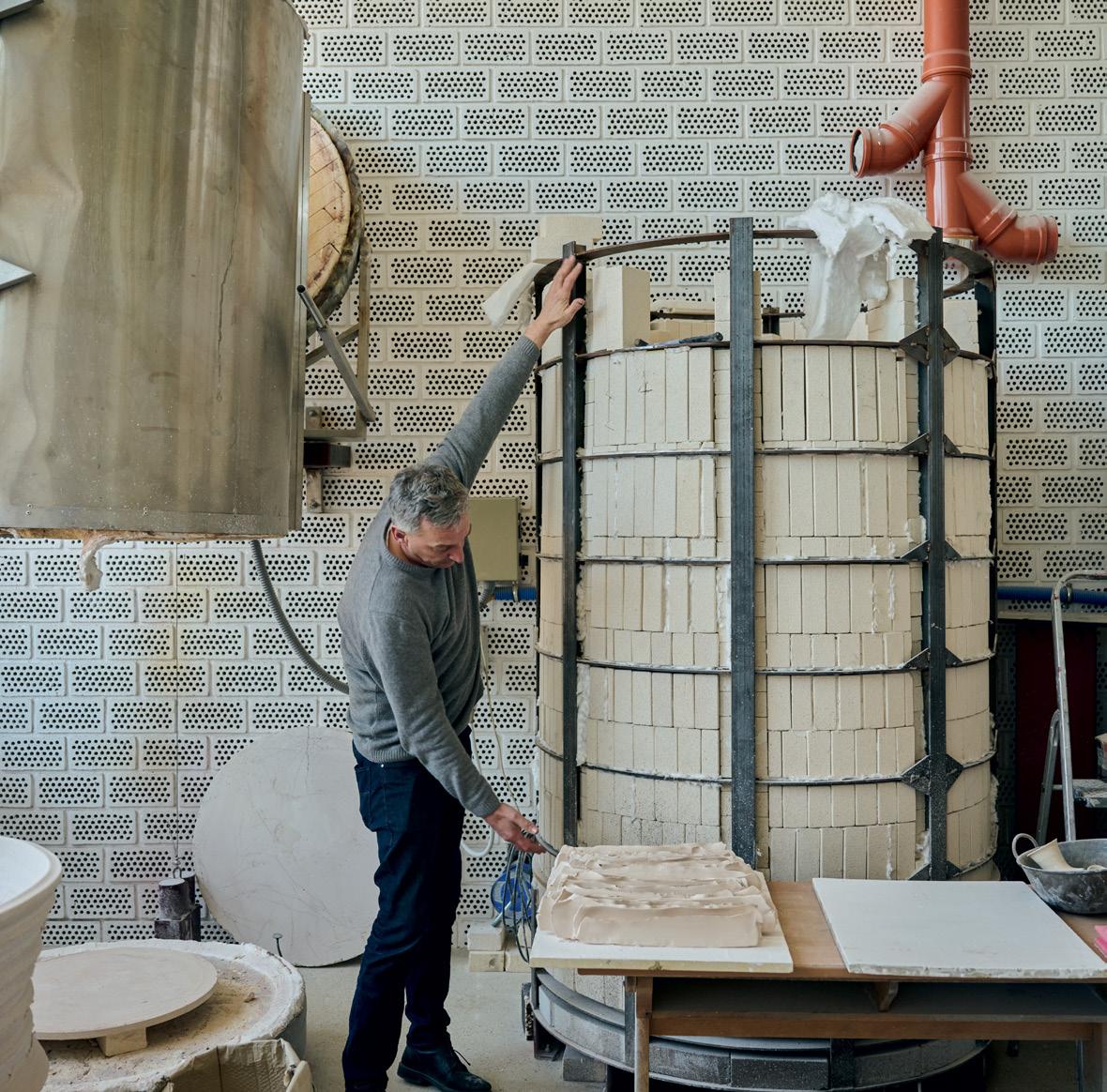
45
DOUBLE SEASON
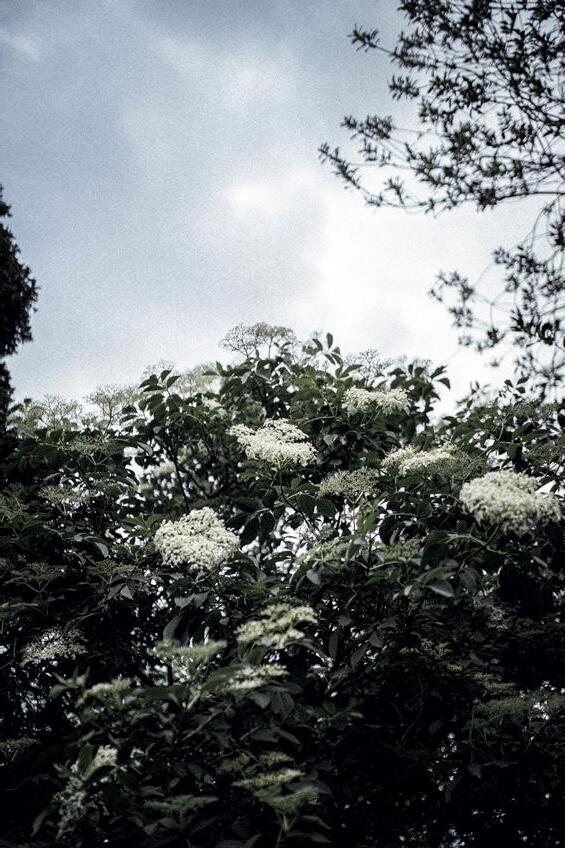
TEXT: KATHARINA SEISER IT DOESN’T MATTER WHETHER YOU CALL IT HOLLER IN COLLOQUIAL AND FAMILIAR LANGUAGE OR ELDER IN CORRECT HIGH GERMAN. BUT YOU CAN’T MISS HOLLER’S TWO SEASONS: THE VERY AROMATIC FLOWERS IN SPRING AND THE INTENSELY COLORED FRUITS IN LATE SUMMER.
BUSH WORK 46 S MAGAZIN
AAGRICULTURAL PRODUCTION
Although elder bushes grow on every fallow piece of ground or “Gstättn” and around every old farm, “black” elder is also grown commercially because of the berries. Eighty percent of the elder grown in Austria comes from Styria – which is also around a quarter of European production.
For those who have their own garden: Heinz Reitbauer recommends the Austrian variety Haschberg.
BBERRIES & FLOWERS
Both elder’s white flowers, which ripen in late spring, and its dark purple, almost black, small berries that hang from the bushes in heavy bunches in midsummer are highly sought after for culinary purposes. While the flowers can also be eaten raw (but are usually preserved as syrup, oil, jelly or vinegar), the fruits must be cooked because they contain the glycoside sambunigrin, which in harmless cases can lead to diarrhea and vomiting, and poisoning in the worst cases.
CCOCKTAILS
Holler has become a bit of a trendy flavor in recent years, which you can see in bars and commercial drinks. But there are definitely worse trend drinks than Holler Spritz, shrub (the beverage) with cucumber and elder or Gin with Holler tonic.
DDISTINCTIVE FRAGRANCE
You only need to say elderflower, and almost every child has an idea about it. Its aroma is fruity and floral-fresh, berry and reminiscent of passion fruit, with perhaps a tiny whiff of musk, – you could also call it summer-hot-sticky. This distinctive scent is perceptible when sniffing and retronasal when chewing and swallowing. That is why products made from flowers are so popular, because they preserve this flavor (and not only the fragrance) well.
EELDERFLOWER VINEGAR
Fragrant elderflower vinegar is one of the most amazing and easy to make secret weapons in the home kitchen. Mild, white balsamic vinegar with its slight sweetness and relatively neutral fruity taste is best. Strip the ripe bunches of flowers from the green stems as thoroughly as possible over a preserve jar until full to the brim, then fill with the condimento bianco and let the mix steep for 14 days. Strain through a fine cloth or nylon strainer. Ideal for vinaigrette for leaf and cucumber salads, but also for asparagus, kohlrabi, carrots and peas.
FFISH
gets along with elder blossoms just as well as mussels. Whether fresh blossoms at the end or – even better – pickled blossoms or vinegar, oil or butter on top, Holler flowers have long since ceased to be used only in pastries and cakes. What has long been common knowledge in Scandinavia and England or in the restaurant trade has slowly filtered its way down to the rest of us.
GGELLED FRUIT
What the quince is to late fall, the elder blossom is to late spring: a highly elegant provider of flavor for a delicate, very fragrant jelly. Because elder blossom is not a fruit, it needs one as a carrier. High-quality apple juice with crisp fruit and acidity is perfect for this (the single-variety ones from the Wetter family, for example). Steep as for syrup and boil down with preserving sugar to soft jelly. Tastes especially good on crumbly croissants.
HHOW RASPBERRIES
are just like strawberries – close friends with elder flowers. Flavored with a splash of elderberry syrup or mixed with elderberry vinegar to make refreshing shrub, as a combo in cakes made of sponge or shortcake. Used in punch or the fresh fruit marinated with elderflower.
47
Ialso love elderflower, which is not surprising given the fragrance. If there are too many insects, they –and the elderflowers – should remain in place on the bush. A few little bugs or grubs can be carefully shaken off. But not too hard, because the aroma is in the pollen. That is one should never wash elder blossom.
JJAMS AND SUGARS
Elderflower syrup is just as suitable for flavoring good yogurt as elderberry jam preserve. Breakfast yogurt becomes particularly refined when sprinkled with crunchy elderflower sugar – made from granulated sugar mixed with blossoms, which is spread out on a baking tray and dried at a low temperature.
KKRACHERL, CELLAR, CHILDHOOD
LLEMONADE & LIQUEUR
You can buy Hollerkracherl (elder lemonade), but it tastes even better homemade: from fresh, cold prepared elder syrup with soda or strongly sparkling mineral water and maybe a squeeze of lemon or lime juice. Eternal memories of running in sandals with no socks, freckles and spaghetti straps!
You can also prepare liqueur from the fruit, similar to blueberries, raspberries or blackcurrants.
MMUSCATEL
The riddle of the chicken and the egg should be very easy to solve in this case: Holler can be guaranteed to have existed before wine made from muscat grapes. Therefore, the association “Holler flowers” in the bouquet of classically vinified Styrian Muscatel wines is completely justified. Who possesses the second and encountered the first during the third, knows what it’s all about: the drama when the preserved Holler fermented and burst the glass jar. This can happen when the mix starts to ferment and if the glass was tightly closed. Lightly sparkling, naturally fermented Hollersekt, sealed with rubber caps so that only these, but not the whole bottles fly into the air, is a rare delicacy that is only available in early summer.
NNOSE TIP
This is a good indicator of the maturity of elder flowers. Firstly, because, when collecting, you should smell each individual bunch (because not every elder bush has strongly fragrant flowers and not every bunch of elder blossom is equally intense) and secondly, abundant pollen on the tip of your nose means that you’ve chosen the right time to harvest them: only on dry, warm days in the late morning/around noon, never on rainy days or the first days after.
OOIL
The idea of obtaining oily extracts from all sorts of herbs and flowers comes from haute cuisine. Elderflower oil is one of the most amazing incarnations of this familiar plant. It isn’t used for frying or cooking, but for seasoning and marinating. According to Heinz Reitbauer, it is really useful in vegetable and fish dishes, for example, when you want neither the sweetness of syrup nor the acidity of vinegar, but where you still require the intense aroma of elder.
PPAPER BAG
If you collect elder blossoms, you should take large paper bags with a stable bottom and a pair of scissors (either garden or kitchen scissors will do!). The scissors can also be used to pinch off blossoms that are hanging a little higher up, and they can be transported home in a bag. It is essential to process them on the same day.
INSECTS
48 S MAGAZIN BUSH WORK
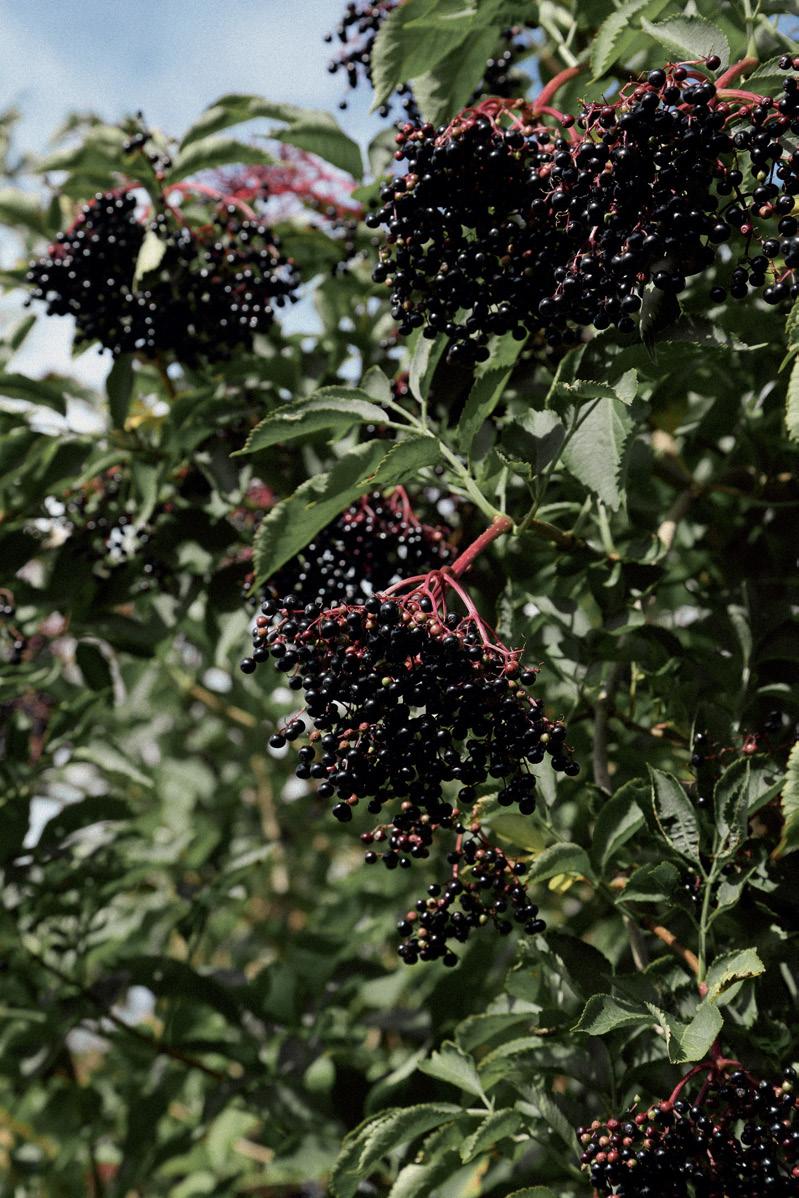
Depending on altitude and sunlight, elder blossom ripens gradually from May to July. The bunches must have fully bloomed and be rich in pollen and exuberantly fragrant.
49
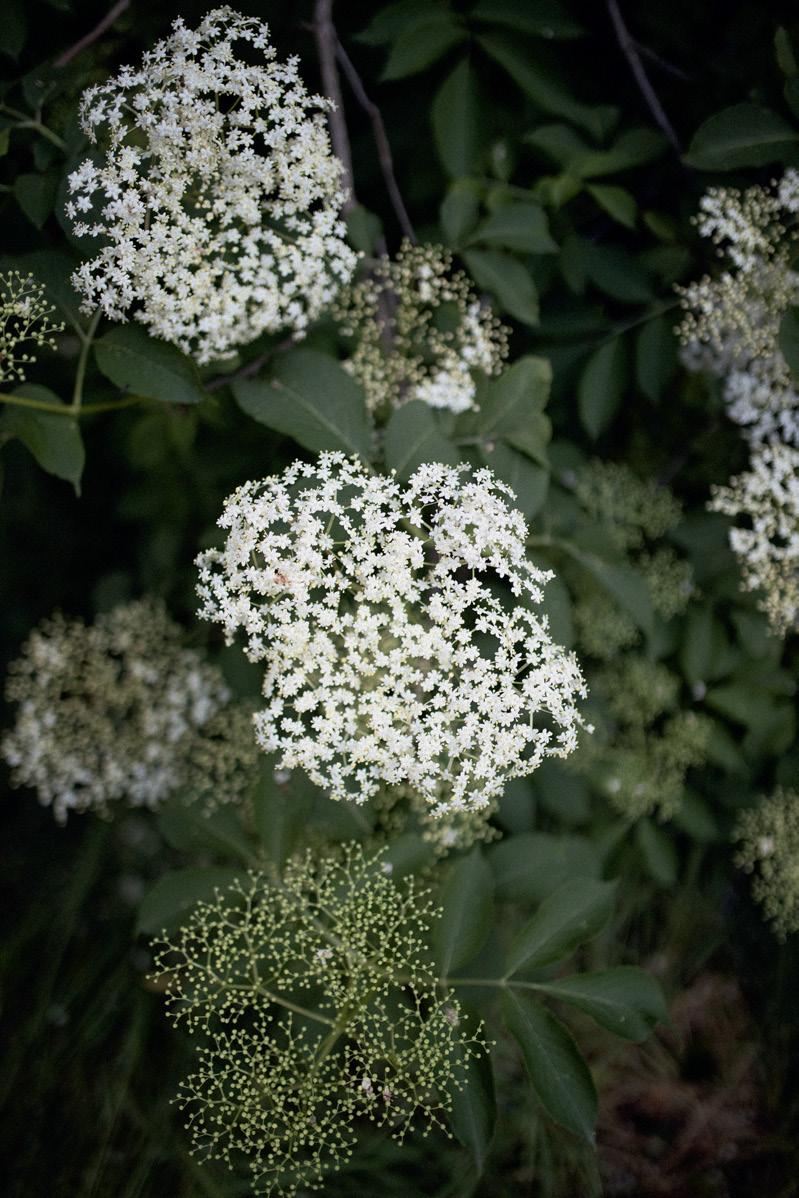
Cinema for the mind with the provocatively-scented elder blossoms in the leading role: baked whole in batter? preserved in vinegar, oil or syrup? as a really seasonal topping for salads, vegetable and fish dishes or desserts?
50 S MAGAZIN BUSH WORK
51
Q
RQUITE EASY TO SOURCERÖSTER OR PRESERVES
While damson preserves or röster can be found in every Austrian supermarket, this was not the case with Holler preserve for a long time. It was considered as being grandmother fare, usually topped up with apple and/or pear and/or plums and, depending on preference, lightly thickened with starch. The slightly tart, sour Holler is the king of preserves when served with crispy semolina pancakes or semolina slices. It also goes wonderfully with red cabbage and game. Use only ripe fruit when making anything with elderberries (when the bunches are heavy and shiny).
S
SUGARED, BATTERED ELDER
Bunches of elderblossom dipped in batter and fried in clarified butter or oil, sprinkled with powdered sugar and served burning hot can once again be found more often on menus of country inns. Battered Holler is usually only available in June, highly sought after by connoisseurs.
TONIC
stands for all refreshing alcoholic or soft drinks made from elderflower, with its special and enchanting aroma. By the way, cucumber goes perfectly with el derflower in drinks, not only in salads.
T U
elderberries should not be used, because they contain particularly high levels of the toxin sambunigrin. Therefore, you need to thoroughly sort the berries or only pick fully ripe bunches.
VVICTORIA SPONGE
is the traditional English summer cake, consisting of two round cake layers assembled with strawberry jam and whipped cream. Elderflower syrup makes a great addition to this simple but very popular cake – just soak the sponge or flavor fresh strawberries (instead of the jam). The syrup also goes well in light creams with buttermilk or yogurt, whether between two cake layers or in a dessert glass.
Wild elder grows in almost every sunny corner. In theory, one could confuse it with the unpleasant smelling Danewort (dwarf elder) or with Red elder (Red-berried elder). The true elder, that is the one sought after for culinary purposes, is much bigger, has an intensive smell and the ripe fruit hang in heavy dark violet bunches.
X
XANTHAN GUM
WILD YUZU
is maybe used nowadays to slightly thicken elder preserves. Starch was used previously, but that doesn’t start with X.
is a stand in for other rather acidic citrus fruits such as lemons and limes. But they are welcome because their acidity is so harmonious with elder blossom! Even elderberries, which themselves are neither particularly sweet nor sour, do well with a little fruit acid.
W Y Z
Damsons, just like apples and pears, are elderberries best friends. They like to hang around together like a gang, then call themselves Holler preserve and have a rather dark, seductive side.
ZANY FRIENDS UNRIPE
It’s difficult to find an easier source of food than elder in the wild. So simple, in fact, that the flowers are never sold, because they grow freely available everywhere. The season begins from the end of May, when it is impossible to ignore the fragrance and, depending on altitude, continues into July.
EAT WHAT YOU WANT TO SAVE
TEXT: KATHARINA SEISER
Why a variety of species and varieties is so much more than folklore, nitpicking and hedonism
Whenever diversity is mentioned in a dinner conversation, the same examples have been used for many years: old apple varieties from Berlepsch to Renette, colorful rare tomatoes from America and southeastern Europe, or extensively raised pig breeds such as Mangalitza and Schwäbisch-Hällisches. Then the talk turns to Slow Food, Noah’s Ark and the Svalbard Global Seed Vault on Spitsbergen in Norway. My old acquaintance Mephistopheles, sitting on my shoulder, whispers: But do you actually know what’s in your packet of flour? With a mocking smile, I reply. Says so on the packet: smooth wheat flour, 960 rye flour, whole spelt flour. From Austria, and organic, of course! Yes, but which type of wheat, rye or spelt? No one knows the answer to that. Because we have no idea at all whether the flour packet contains the unloved hybrid wheat variety or the one that has been adapted to the location for centuries but is unfortunately a bit unpredictable in the flour packet. We don’t even have a clue whether one or more or how many varieties.
When I was writing a book about making bread with two master bakers a few years ago, we also visited one of the largest mills in the country . It was only there that I realized, amid all the noise and hightech, that what we buy as “normal flour” is always a cuvée or blend. Each single-variety grain delivery is analyzed for its physical and chemical properties in the mill, that has its own laboratory and a fleet of expensive trucks. After that, it is blended because what do professional and private bakers want from flour? Consistent quality, predictable behavior, expected texture. Obvious and understandable, but also a problem, because we don’t care what varieties with what growing requirements are used for our flour. This industry, like the poultry industry, has specialized in a few high-yielding varieties. With just as much risk. Because these monocultures are easy game for invasive diseases or pests.
I am currently reading the book “Eating to Extinction” by British journalist Dan Saladino, where he gets to grips with the issue of very rare foods –or rather, foods that have become rare – around the globe. Above all, he puts them in context with the demands of modern agriculture, climate change, world nutrition. With each of the 34 portraits, the desire for tasteful and traveling discoveries grows – along with the horror of what is being lost in terms of gene pools, traditional knowledge and craftsmanship. This is not a hedonistic or highly cultural problem, but has a global one for a long time, because the same few varieties are grown and bred everywhere and the simple loss of any one of them is tantamount to catastrophe.
There are other aspects as well. If some product groups are excluded from the daily diet due to excessive demand, then we lose much more essentials with this reduction than just a colorful and diverse Noah’s Ark: The more types and varieties of plants (and possibly also animals) we eat, obviously the better it tastes. However, the more diverse and varied a diet is, the healthier it also is, because in this way we are constantly supplied with all nutrients and vital substances without needing nutritional tables or supplements. The diversity of species and varieties also maintains and expands a large network of farmers. This diverse network will hold, even if should one part of it fail or break down. This would be a good insurance for the future – in contrast to the food industry, which uses only a few raw materials such as soybeans, mushrooms, peas and the cheapest meat from animals kept in catastrophic conditions in order to make, flavor and shape everything you can imagine.
That’s why the motto “eat what you want to save” applies more than ever: form alliances with scarlet runner bean nerds and rye freaks, aficionados of bitter-tasting salads and sour-cherry fetishists, with breeders of rare livestock breeds and passionate restaurateurs. We need all of them: the thousands of species and varieties – and the people who grow, breed, sell, process and ultimately eat them.
52 S MAGAZIN FUNDAMENTALS
No, don’t turn the page right away, read these lines first! Especially if you love a good riddle. So, what is it? It is an annual, bristly-haired plant that grows prostrate and climbing, and can grow up to four meters long. Voted Vegetable of the Year in Germany in 2019 and 2020, it is extremely cold resistant, the fruit is an armored berry, and its name derives from the Old Polish ogurek. Well, does it ring a bell? If yes, then read on now, and if not, then think harder....
From what & how much
S. 54
CROOKED THINGS
S. 62
GREEN SKIN, WHITE FLESH
2
S MAGAZIN 53 CUCUMBERS & PLEASURE
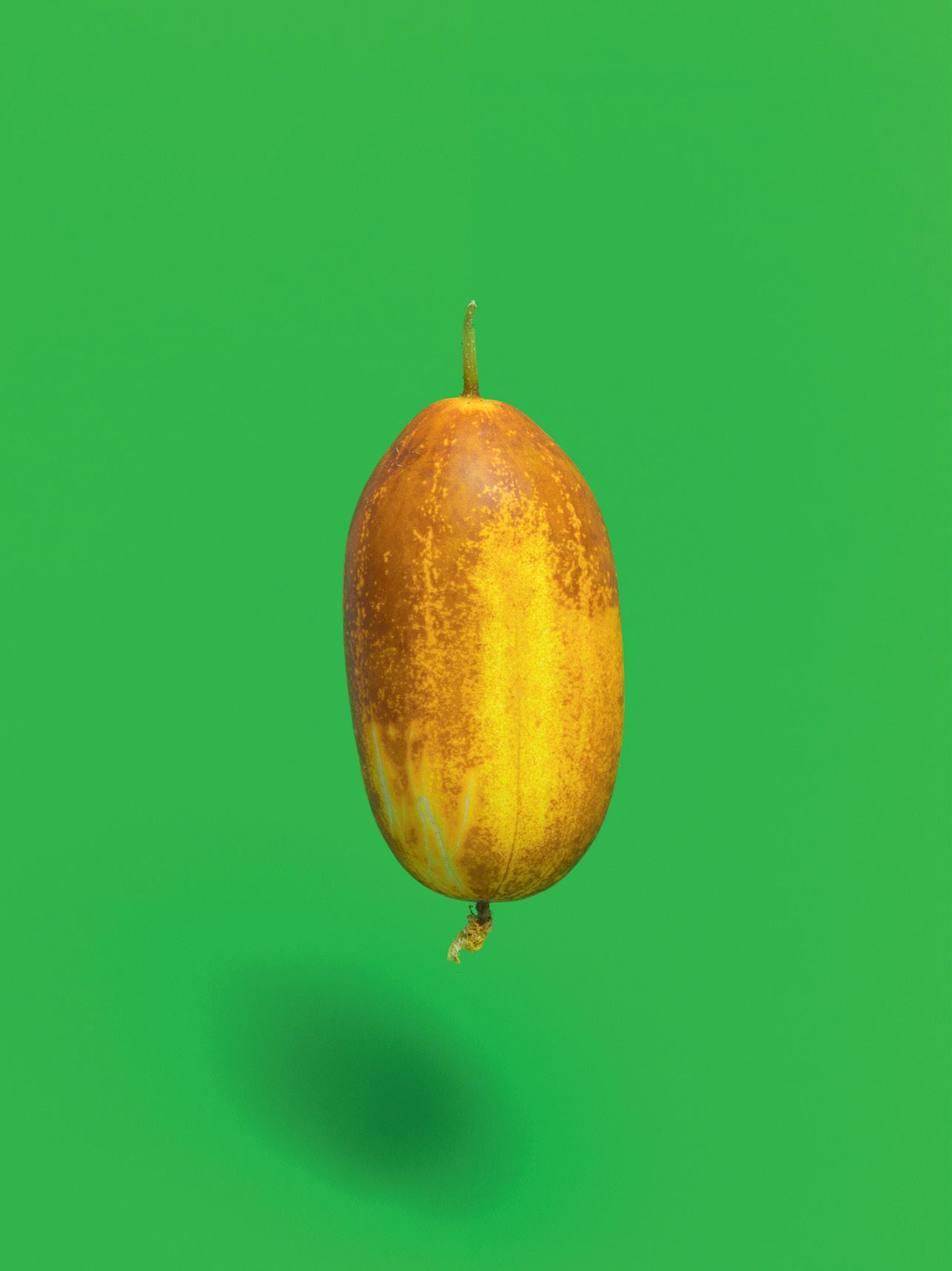
54 S MAGAZIN FIELD FRUIT
TEXT: UTE WOLTRON
The cucumber, an Indian delicacy, has a history going back many thousands of years. The bitterness has been driven out of it and an infinite number of varieties have been bred. Today, this member of the cucurbit family is one of the most popular fruits in the world, whether served fresh and crunchy or appetizingly preserved as pickled gherkins.
Crooked things
RUSSIAN CUCUMBER
Cooler climates naturally produce more robust varieties, and this is the case with this large majestic cucumber with a particularly hard skin. This skin must be removed before the cucumber is eaten fresh or processed, but it also ensures that the Russian cucumber is the only variety that can be stored quite well. The flesh is surprisingly tender and very bright.
PHOTOS: KLAUS FRITSCH
55

56 S MAGAZIN FIELD FRUIT
ANTILLEAN CUCUMBER
This cucumber variety originates in Africa and not in India. Like its Indian relatives, it is now cultivated in all warm regions of the world. It has a spiny, sometimes smooth skin, and is eaten both raw and pickled. Depending on regional cuisine, it can also be served boiled and fried. In South America, where the cucumber is called maxixe, it is popular in stews.
The cucumber’s kingdom is in India, where it originated and has been cultivated for at least four thousand years, enrichening the already varied cuisine of the entire subcontinent in fresh, raw form, but also pickled in vinegar, oil or salt and – surprisingly for us – cooked, roasted and boiled. Starting in India, this versatile fruit already spread in ancient times via trade routes to the Middle East, as far as Greece, the Roman Empire and finally throughout the entire Mediterranean region. Countless historical stories and anecdotes abound about this popular delicacy, which after all consists of 96% water. It has little nutritional value in the form of calories, but is considered exceptionally healthy and digestible due to its high content of phytochemicals.
However, in terms of taste, it has made significant progress over the past millennia. The original Indian cucumber in its wild form was probably an extremely bitter thing indeed, bitterness which fortunately can no longer be tasted at all today. Selective cultivation has largely driven these bitter substances out of the armored berry – because botanically speaking, the cucumber is actually a berry with a very hard outer shell. Only occasionally, however, does the wildness strike through and we are reminded of it when the ends of the slender fruit are suddenly unpleasantly bitter. The root cause of this is quickly explained – it is all down to care: the cucumber plant is a creature that loves warmth and sun and it hates being thirsty. If the temperatures in our comparatively cool latitudes fluctuate too much or if the cucumber gardeners do not fulfill their responsibility of watering regularly, then these bitter ends can and do occur.
The cucumber is one of the five most important and popular vegetables in the world, and yet it is hardly known that it exists in an almost infinite number of varieties and species. As a separate genus within the cucurbit family, it is closely related to the garden squash and to the sugar melon and watermelon. More than fifty species of cucumber are known and, over time, they have given rise to an incredible range of varieties, which are often very different from region to region.
Basically, depending on their use, three groups of cucumbers can be singled out. In the German-speaking world, this applies since the late Middle Ages! Because even then, people north of the Alps knew to appreciate the fresh, juicy taste of this member of the cucurbit family. These groups are: salad cucumbers, peeled cucumbers and pickling cucumbers. And to make the matter a little more complicated and also to explain it from a botanical point of view, it should also be mentioned that most types of cucumbers sprout female and male flowers on the one plant. Only some cultivars produce exclusively female flowers that fruit without pollination. Experts call this “virgin fruiting,” and we mention this here because the cucumber has another trait that is also
57

58 S MAGAZIN FIELD FRUIT
BLANC DE BONNEUIL
Its white skin and mild taste characterize this rare variety of cucumber, which is very appreciated in its native France. This delicate beauty is hard to find in this country, but at least in Vienna you can get it at the Bach nurseries. It is not the only white cucumber variety, but it is one of the oldest. Marie-Antoinette is said to have cared for her hands and complexion with its juice.
largely unknown: the male cucumber flower is fragrant, and fabulously so. However, if you want to smell the surprisingly subtle, vanilla-like fragrance, you will have to sniff the flower at night, because like many other plants, they only emit their perfume at certain times to attract certain pollinator insects. In any case, it’s well worth a trip to the cucumber plants in your vegetable patch on a summer night!
But let’s go back to the days when the cucumber began its conquest of the world as a commodity. Probably one of the oldest written mentions is found in the Babylonian Epic of Gilgamesh, where the cucumber is praised as a cooling fruit for hot days. It most likely came to China, today by far the world’s largest producer of cucumbers with more than 72 million tons, in around two hundred B.C., and even the Bible pays homage to it when it says in the fourth book of Moses: “We remember the fish we were given to eat for free in Egypt, the cucumbers, the melons, the leeks, the onions and the garlic!” The ancient Egyptians, in whose fields the cucumber has also grown for at least three thousand years, are said to have made a mild alcoholic drink from it by drilling a hole in very ripe fruit and stirring around the insides. It was then resealed and buried for a few days. Whether this fermenting juice was a delicacy, we will probably never know.
The Romans, however, proved to be the greatest admirers of the cucumber, the finest gourmets of the ancient world in terms of consumption, but also in the cultivation and refinement of vegetables and fruits. It is said that the Emperor Tiberius ate cucumbers every day, and since the demand was also high outside the imperial kitchens, the gardeners had to cater intensively to the needs of the heat-loving plant in order to meet demand. These gardeners discovered that the cucumber, as a climbing plant, ideally needs a climbing framework, such as taut ropes, trellises or similar, because this significantly increases the yield. And since the weather plays an important role, as already mentioned, not only portable planters were designed for the sensitive cucumber plants to bring them in and keep them safe on cool nights. People even invented protective little structures that actually functioned much like modern glass houses. Window glass was still a long way from being invented, but people used thin, translucent silicate plates as panes, and it is fair to say that the Romans are thus considered as having invented the predecessors of the modern greenhouse.
It took a while until the cucumber crossed the Alps and before our latitudes became familiar with it. It was only at the instigation of Charlemagne, who had come to know and appreciate the crop in Italy, that it finally came to us in the north, and from the 15th century even the British tried their hand at growing cucumbers during their short summers. The reason for this was the culinary preferences of Catherine of Aragon. The first wife of Henry VIII, as a Spaniard
59
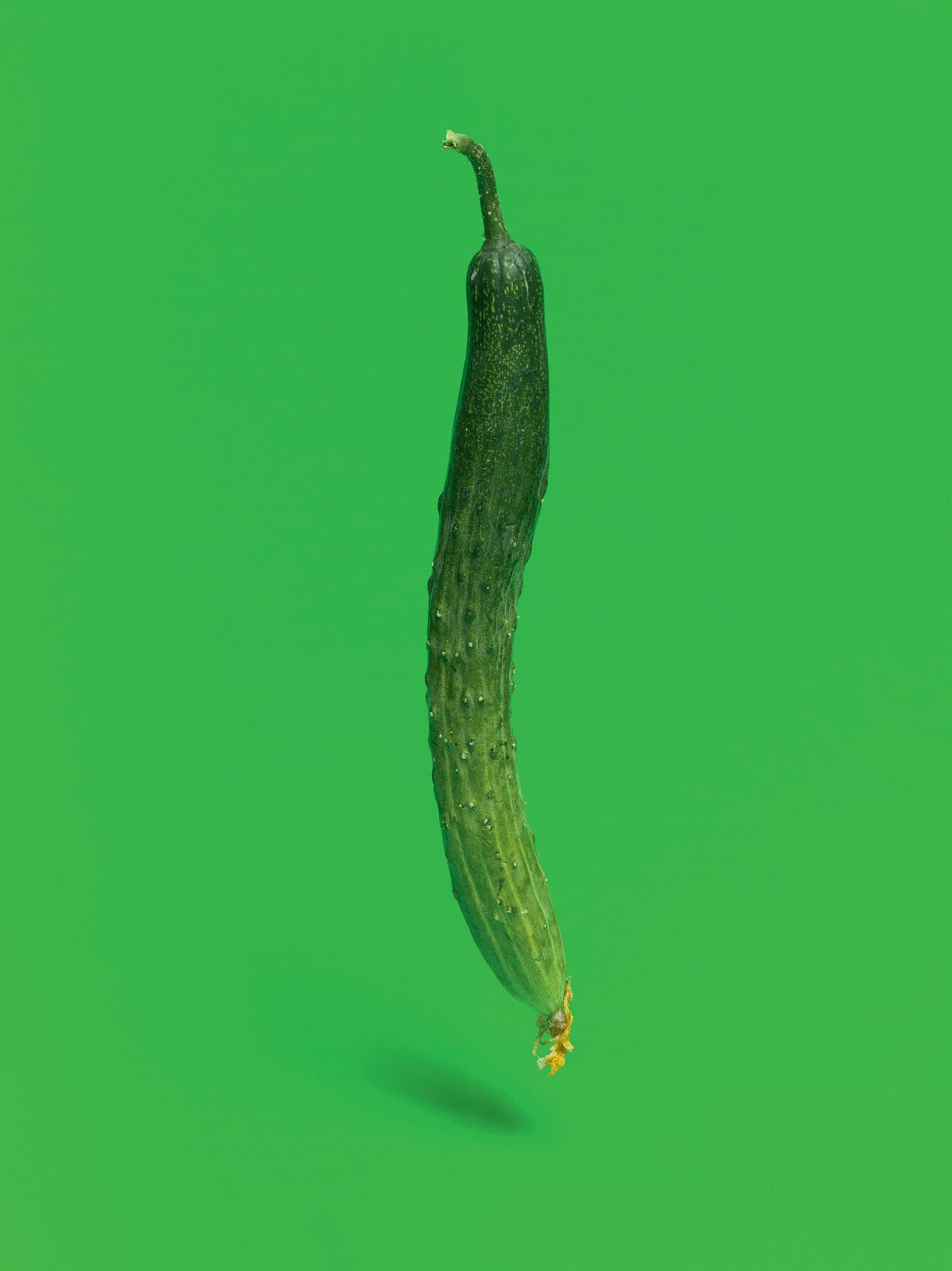
60 S MAGAZIN FIELD FRUIT
SACHIKAZE
As the name of this elegant and very long (up to thirty centimeters) variety would suggest, this cucumber is a breed from Japan. Taste is a matter of debate, but it is often claimed to be the best cucumber variety in the world. Because it is so tender, it is preferably eaten raw, often together with the fine skin.
accustomed to cucumbers, wanted this fine fruit in her salad. The Spanish conquistadors finally brought the cucumber to the New World in America, where it soon became one of the most popular plants and found ideal growing conditions in the fertile, warm and humid climate of the southern zones. Hernando de Soto, one of the conquistadors, said that he was surprised to find that the taste of cucumbers grown in Florida was much better than that of Spanish cucumbers. So much for the history and the journey of the cucumber, at least as far as its geographical distribution is concerned. As far as the culinary aspect is concerned, we have to go back to antiquity, where the export of cucumbers from India to Mesopotamia started a transnational tradition. This is the story of the pickled cucumber, which, as we all know, still delights us today in all its most diverse incarnations, whether preserved in vinegar and refined with all kinds of spices or fermented in brine to become a pickled cucumber.
The New York Food Museum dates the birth of its historical predecessors sometime around 2030 B.C. in Mesopotamia. There, preserving methods such as lactic fermentation and the pickling of vegetables were already commonplace, where the cucumber proved to be an ideal ingredient for these processes. Researchers assume that the first pickles were in fact pickled cucumbers, and there is also historical evidence of this.
Aristotle, for example, praised pickled cucumbers and their healing effect as early as the 4 th century BC. Elizabeth I’s chef noted the English queen’s fondness for pickles, and Shakespeare mentions “pickles” in his plays Hamlet and Antony and Cleopatra. Thomas Jefferson, third president of the United States, wrote in his diary, “On a hot Virginia day, there is nothing more comforting than a fine, spiced pickle, fished under the stairs of Aunt Sally’s cellar like a trout from the glistening depths of the aromatic preserving jar.” In short, whether pickled, added fresh and crisp to salads, roasted or cooked into ragouts, the pickle is now an international staple and a joy at every table.
61
GREEN SKIN, WHITE FLESH
FOTOS: PHILIPP HORAK

When a footballer rolls the ball through his opponent’s legs and gets one over on him, we colloquially call it “giving him the cucumber”. And when there is no action going on, we call it “sour cucumber times”. Obviously Cucumis sativus hasn’t done anything to deserve this reputation, because it is one of the most economically significant vegetables and often a component of great culinary delights. Here are four examples.
62 S MAGAZIN FIELD FEARING
LAVENDER FLOWER LIME MARINADE
INGREDIENTS
- 10 g mustard seeds
- 5 g fennel seed
- 5 g coriander seed
- 200 ml lime juice, finely strained
- 100 ml white wine vinegar (Bertoli)
- 70 ml honeydew melon succo (strained melon juice)
- 70 ml cucumber succo (strained field cucumber juice)
- 25 g Carpathian salt
- 10 g lavender flowers
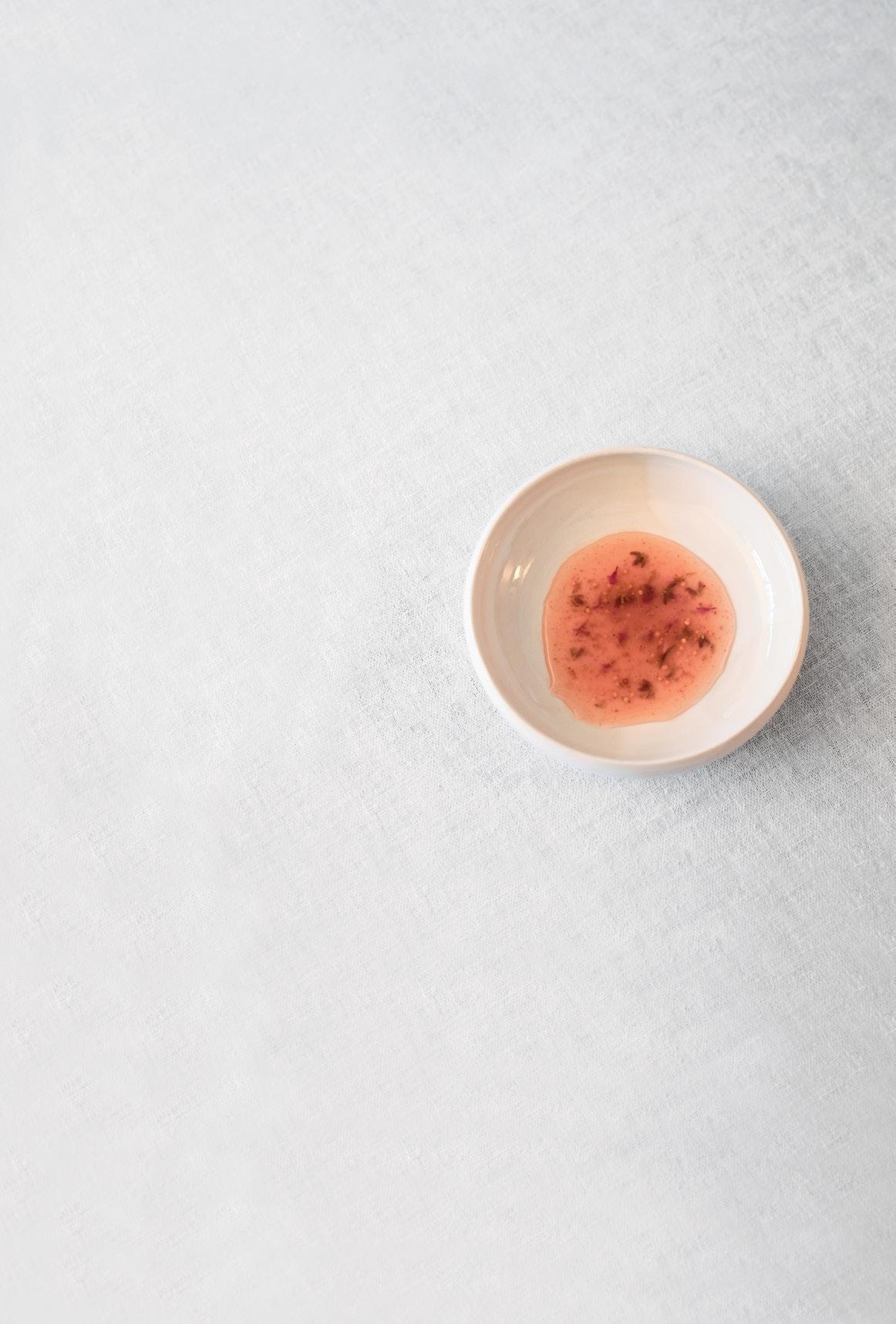
PREPARATION
Dry roast in a saucepan over medium heat.
TIP
The sweet and sour, flowery marinade can be used for pickling vegetables or used as a marinade for fish and shellfish dishes.
Deglaze, bring to a boil, cover and allow to infuse for 24 hours.
The next day, strain through a Belgian sieve and add the lavender flowers crushed in your hands and the Carpathian salt.
63
PICKLED MUSTARD CUCUMBERS
20 SERVINGS
INGREDIENTS
- 3 kg field cucumbers/Russian cucumber (firm fleshed)
- 4 tablespoons salt
- 2 tarragon sprigs
- 4 bay leaves
- 4 shallots
- 500 ml white wine vinegar
- 175 ml water
- 40 g mustard seeds
- 6 allspice seeds
- 8 peppercorns
- 40 g granulated sugar

PREPARATION
Peel the cucumbers, cut in half lengthwise and remove the seeds. Cut into glass-length sticks about thumb-thick, salt and let stand for two hours.
Drain the cucumber water and place the cucumber sticks with bay leaf and tarragon tightly in sterile preserving jars.
Peel shallots and cut into medium-fine rings.
Boil with the remaining ingredients for about twelve minutes, strain, cool and pour over the cucumbers.
Seal jars airtight and store refrigerated.
64 S MAGAZIN FIELD FEARING
CUCUMBER AND PHYSALIS WITH NASHI PEAR SALAD
4 SERVINGS
INGREDIENTS
- 1 tsp aniseed
- 1 tsp fennel seed
- 300 ml lime juice, strained
- 4 sprigs of coriander, coarsely chopped
- 4 basil sprigs, coarsely chopped
- ½ green pepperoni (depending on how spicy)
- 1 young leek, finely cut into rings
- 5 g ginger, peeled, finely chopped
- ½ clove garlic, finely chopped
- 2 tablespoons granulated sugar
- 2 Nashi pears, cut into wedges
- 2 young leeks, finely chopped
- 15–20 physalis
- ½ green pepperoni (depending on how spicy)
- Russian cucumber/field cucumber/ Melothria cucumber (depending on availability), peeled and cut into bite-sized pieces
- Carpathian salt
- 100 ml lemon savory oil
- Fennel flowers
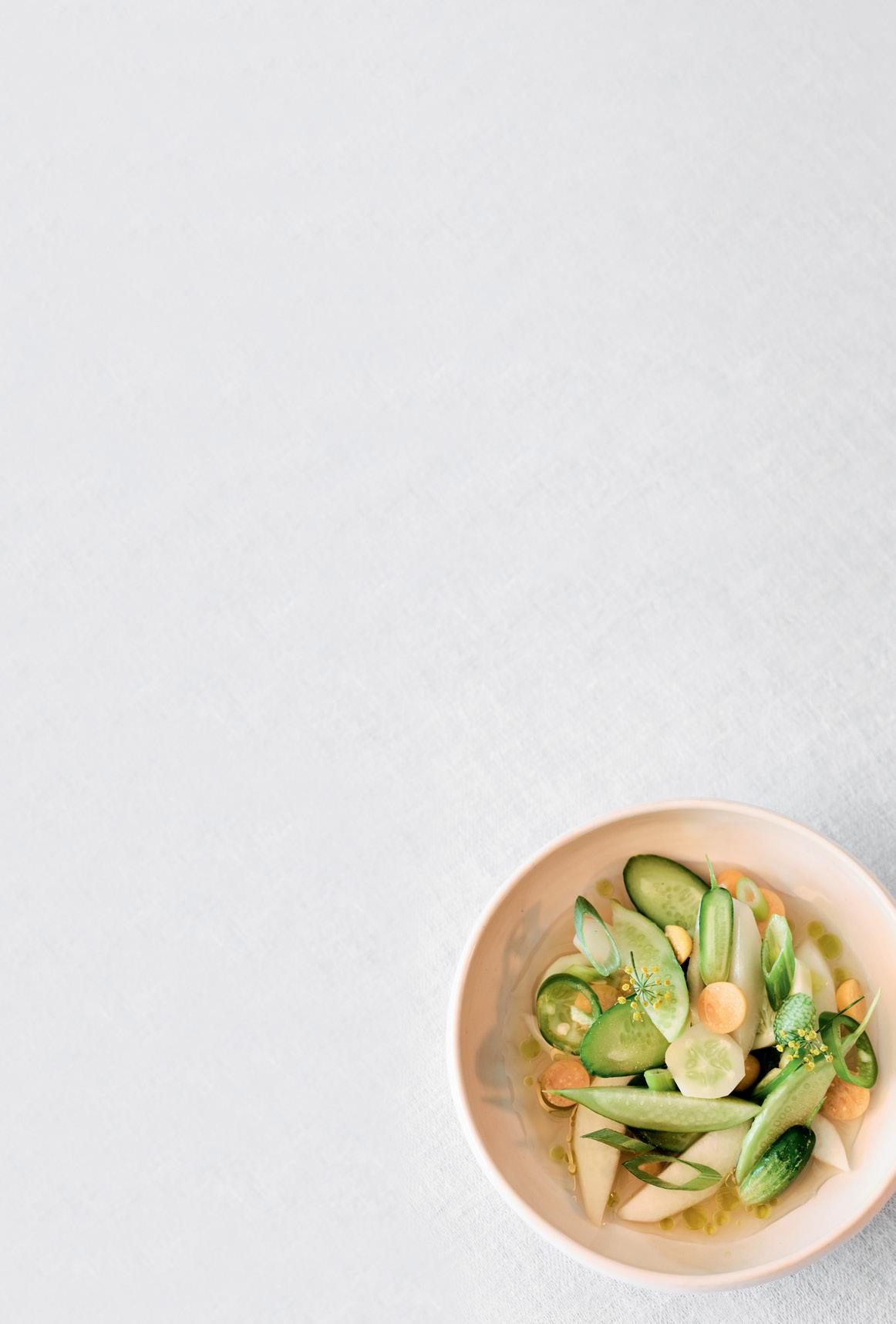
PREPARATION
Dry roast in a saucepan over medium heat.
Infusion
Whisk all ingredients together once, remove from heat and let steep, covered, in refrigerator overnight.
Strain the next day and marinate the salad with it just before serving.
PREPARE AND DRESS THE SALAD:
Marinate the cut elements in a bowl with the marinade and season with salt.
Let the salad stand for a few minutes and then serve chilled.
Add just before serving and garnish with the fennel flowers.
65
FIELD CUCUMBER YOGURT ICE CREAM
QUANTITY: 1,2L
INGREDIENTS
- 1 organic field cucumber
NOTES
Use the remaining cucumber juice for other purposes (salad marinades or vegetable juices, etc.).
- 50 g cucumber juice, finely strained
- 50 g lime juice, finely strained
- 100 g glucose
- 120 g granulated sugar
- 4 g super neutrose (stabilizer)
- 2 sheets gelatin

- 200 g cucumber juice, finely strained
- 500 g yogurt (3.6% fat)
PREPARATION
Wash and peel the field cucumber.
Then cut in half and scrape out the core with a spoon, leaving only the firm flesh.
With the help of a juicer, juice the cucumber and strain the juice through a fine sieve.
Set aside 50 ml of cucumber juice for the next step and save another 200 g of juice for finishing.
Heat all ingredients together in a small saucepan to 100 °C, stirring constantly.
Then immediately remove from the heat.
Mix sugar and stabilizer whilst dry and trickle into the hot liquid (approx. 80 °C).
Soak in cold water for a few minutes, squeeze well and stir into the still hot liquid until completely dissolved.
Allow to cool to room temperature in this state.
Stir into the room temperature liquid until a homogeneous mass is obtained.
66 S MAGAZIN FIELD FEARING
“Kabale und Liebe”, Friedrich Schiller’s great drama, was premiered in Frankfurt on April 13, 1784. “Kabane und Liebe”, the Reitbauer comedy – Desire for Enjoyment and Desire to Stay – has recently been staged at the Wirtshaus am Pogusch. People now sleep in cabins in the glass house, and eat there, where food is always prepared with love, but now also in an open inn room. And, of course, people also drink there. But what will the wine of the future taste like?
How & for whom 3
S. 68
HEART
S.
S. 78
AND SOUL 2.0
S. 98 WINE IN TRANSITION
76 BIG PLATE, LITTLE BALL
PLEASE TAKE A SEAT
S MAGAZIN 67 KITCHEN, CELLAR & CABIN

ZEITEN-WENDE 68 S MAGAZIN TURN OF THE TIMES
HEART AND SOUL 2.0
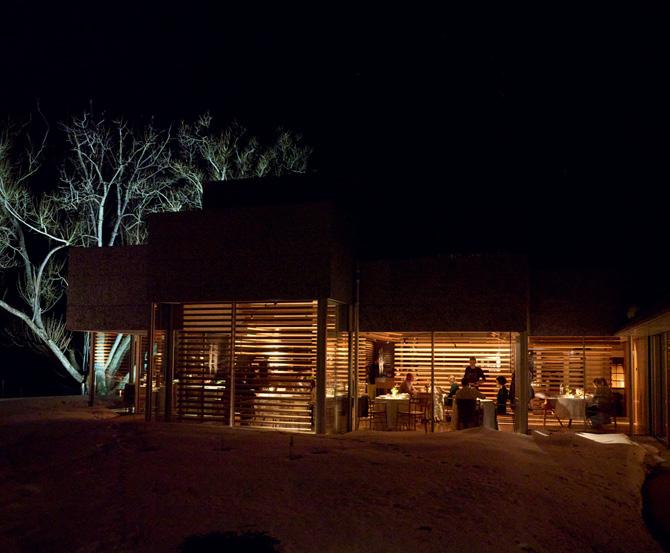
TEXT: ACHIM SCHNEYDER
PHOTOS: MIRCO TALIERCIO
The Steirereck inn at Pogusch shows its new face, more radiant, friendlier and smiling than ever before. A perfect facelift at 1050 meters altitude, performed by Birgit and Heinz Reitbauer, who tirelessly look toward the future.
69

ZEITEN-WENDE 70 S MAGAZIN TURN OF THE TIMES
The lord and lady of the manor seem very satisfied. It’s almost midnight and there are only a few guests left in the inn. The newly-built, gigantic stove in the new extensions – in addition to the normal kitchen – still exudes a little warmth, the last embers on the grill still glow red, whilst here and there a good soul flits about cleaning up. Meanwhile, Birgit and Heinz Reitbauer sit relaxed at the seemingly endless bar table, with two “good-night” glasses of wine in front of them.
“The work of the past years has paid off,” says Birgit. “Although we’re still not quite finished,” says Heinz. Heinz only plays a limited role in the new

were completed at the end of 2014, the owners started thinking about the outpost in the Mürztal valley in Styria, about 90 minutes by car from the main establishment. Making the inn fit for later days, for the Reitbauers themselves, for the staff and also in terms of the range of products on offer – these were the starting points taken into account by the two restaurateurs and their inner circle. “It was no longer enough for us to simply run an inn with good cuisine, a few overnight accommodations and around 300 guests a day,” says Heinz. “Rather, we wanted and still want to create not only a gastronomic hub, but also an agricultural hub, something sustainable for future generations with the motto ‘Feed the Future’.

03–05 The new look suits the inn at Pogusch very well. It’s a bit classier than it used to be, but it’s still a good inn with self-service in the walk-in wine cellar (top left) and the large taproom and open kitchen.
Schankkuch’l. He prefers the modest inn kitchen when he is there at weekends, because the Steirereck in Vienna is closed then. In the front of house – therefore on display – are close employees with unre stricted trust who create – in consultation with Heinz –dishes that are a bit different from classic inn fare and for which tweezers are sometimes used during preparation. “However, the Steirereck isn’t intruding at Pogusch at all – rather, this is a contemporary further development in line with our overall concept, which is in our own and also our guests’ interests.”
Let’s take it one step at a time. After the renovation works at Steirereck in Vienna’s Stadtpark
And we want to be, and will be, virtually energy self-sufficient. As far as that’s concerned, we still don’t have the combined heat and power plant, but we’ve got the water thing well under control by now.” This was in fact a problem at Pogusch, at least in the past. Today, however, a very simple service water system ensures that not a single precious drop is wasted. Rainwater is stored in three large cisterns and fed into the water system. Here at Pogusch, there’s no need to worry even if it doesn’t rain for a month.
By the end of 2018, the Reitbauers had thought things through and come up with a fully planned idea. Heinz even built a 2m × 1m model corresponding
71
to the finished concept during countless hours of painstaking night work. This model also included the two glass houses, the one integrated into the main building, measuring around 100 square meters behind the two kitchens, and the free-standing one diagonally behind it, which measures a good 600 square meters in total on three levels. “The glass houses are necessary, because at an altitude of 1050 meters there are of course climate restrictions. But we want to work with our entire plant diversity all year round, including the various citrus fruits. So we decided to use glass houses, so-called cold glass houses, where the temperature changes with the season.”
Steirereck renovation in Vienna was titled “Heart & Soul”. The recipients of said letter could read the following: “A successful business has left its mark on the house and furniture; to make our house fit for the future for the next generation, it needs more than a little paint and varnish. We want to rekindle the desire to come to stay. To give the house a new, enhanced vision and sharpen the overall image. (...) We believe that the time has come to bring about a fundamental change in our inn. As we did in Vienna, we want to show the courage to change and allow our inn to transform so that it once again suits and pleases us. (...) In order to go in the same direction
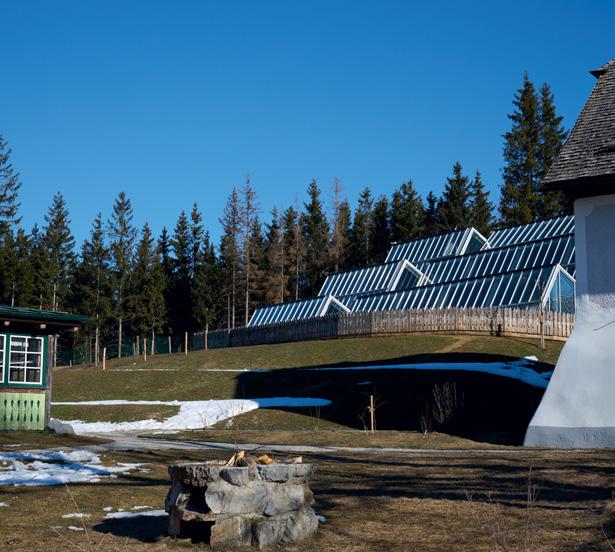

blossoms, grows and thrives, but not only that: Guests also find peace in this architectural marvel laid out over three floors...
To put it in a nutshell: The Reitbauers’ farm includes lambs, pigs, goats and seven different breeds of chicken, as well as more than 300 edible herbs and plants and over a hundred different types of fruit, which, like the four different types of potatoes they grow, are not grown in glass houses but in the great outdoors.
But back to the finished plan. Once the Reitbauers had drawn up their plan, they sent a handful of pre-selected architectural firms a written invitation to participate in the competition, accompanied by a letter entitled “Herzblut” or Heart & Soul II. Formerly, the letter that supported the invitation for the
again, we would like to create a new framework for our activities as well as a new stage for us and our employees. (...) We give our heart and soul every day and we expect heart and soul from our partner. We want to redefine the Steirereck inn at Pogusch with an extraordinary team, with no restrictions, muzzles or preconceived ideas (...). We want the power of ideas as our central leitmotiv”
There was one more requirement: It also had to be possible to sleep in the large 3-storey glass house. “We got this idea from the Bachs, a Viennese gardener family who have breakfast and lunch in their glass house,” Birgit explains. The original plan to
06–08
The large glass house diagonally behind the main building is Heinz Reitbauer’s dream come true. Here, everything that is important for the kitchen
72 S MAGAZIN TURN OF THE TIMES
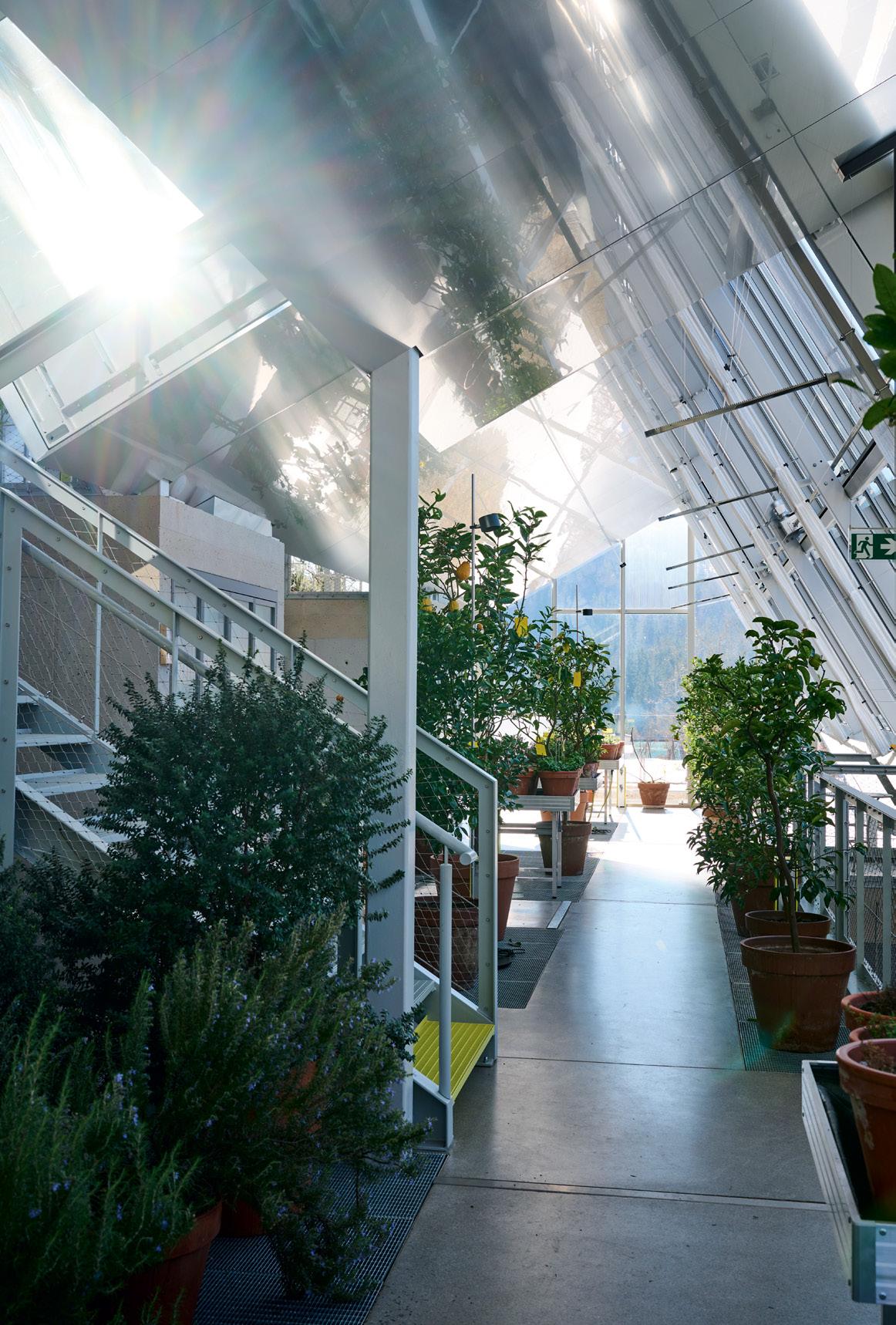
73
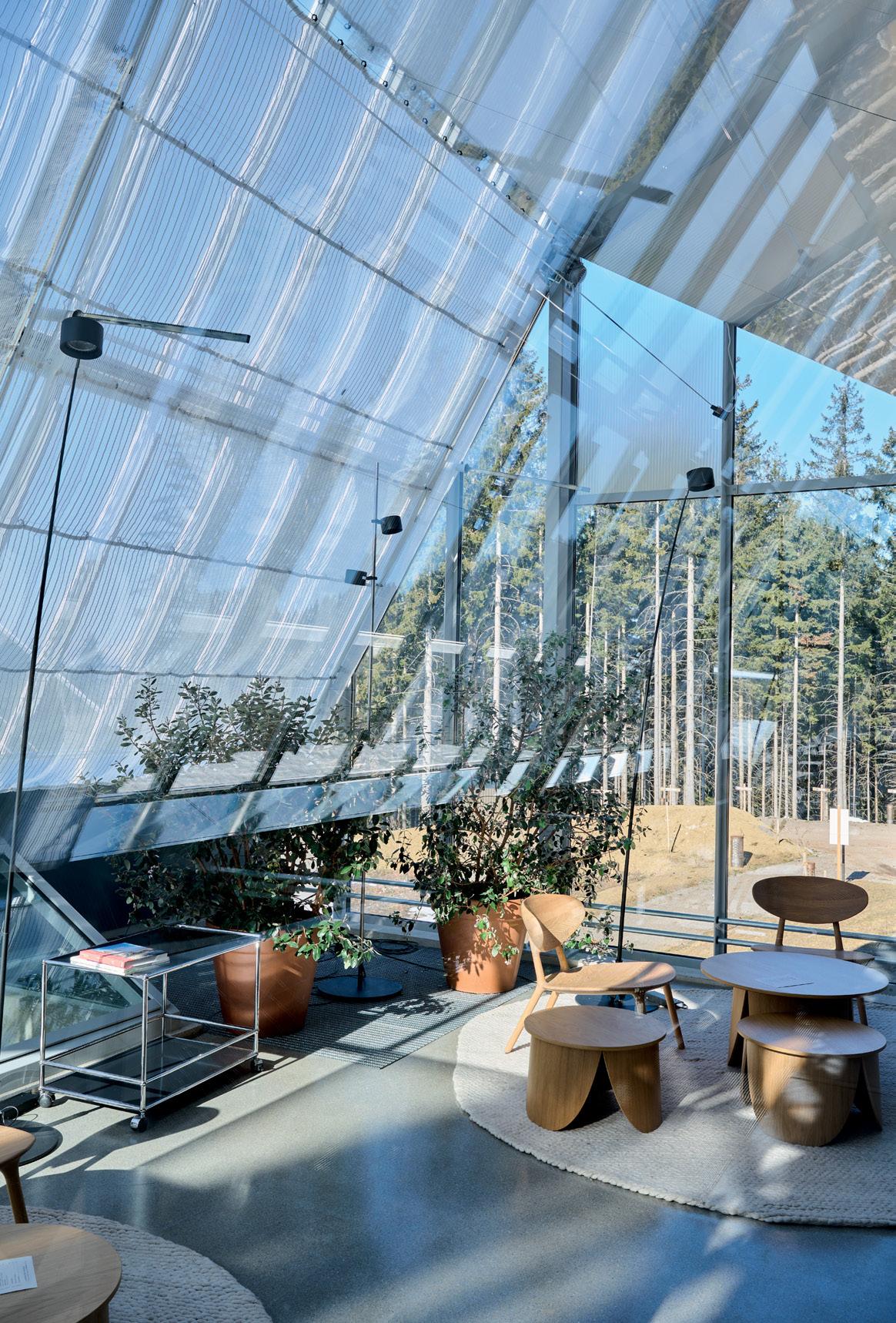
74 S MAGAZIN TURN OF THE TIMES
simply place beds between the 80 or so plants, which are often more than person-high and exclusively intended for the kitchen, was rejected due to the fact that the temperatures in the glass house are often too low. So, the architects who finally won the contract, PPAG Architects Vienna, planned a simple, heated communal washroom and living room with a fireplace, in addition to ten cabins equipped with a double bed and a nightstand. Instead of a wardrobe, which would never have fit in the cabins, there is also a spacious, walk-in and lockable wardrobe per cabin directly next to the showers. There’s also a large sauna, and all that for a price that’s not even in triple digits per cabin.
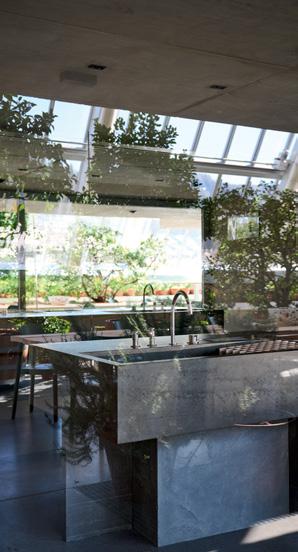
I can tell you from experience that it’s more than just culinary pleasure that awaits you ...

09–12 It is very special to live in a glass house. You sleep in small cabins (top center), walk around in slippers, on socks or barefoot among the plants and share the communal living room with fireplace (large picture) and also the showers. But: It is so really coherent!
“For those guests who don’t want to splash out on the large rooms, the bird houses and the tree houses, we also want to give them the opportunity to experience Pogusch beyond a lunch or dinner,” Birgit explains. Moreover: guests at the glass house have the exclusive right to help out at Pogusch doing such tasks as, for example, harvesting potatoes, baking bread or peeling onions, thus ending up paying only half.
At this point, like a PS, please note: You can reserve the entire glass house with its ten cabins to celebrate at Pogusch with an appropriate group of friends for a merry night or perhaps several days.
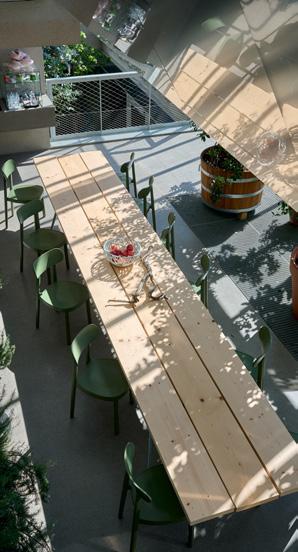
“Birgit and I wanted to rekindle the desire to come to stay at Pogusch, and give the house a new vision and sharpen the overall image.”
75
And suddenly everything is different. A rapid appears on the long, calm river of life, changing our rhythm of just floating along and giving us a moment of true awareness. Recently, one of our garbage-collection heroes snapped his fingers with a sign to the truck driver to stop immediately. Then he jumped off the running board, came up to me and held his open hand in front of my dog Gustav’s muzzle. His palm held a cookie.
A few seconds later, the treat was gone. Then the man. Then came my routine indifference. I called out, “Great, thanks.” Naturally, Gustav, did not, but wagged his tail. The hero waved nonchalantly. And out of the unconscious, the words of Wilhelm Busch found their way to freedom: a surprise always occurs/ where you didn’t expect it.
“Look at that”, I said to the dog. However, I could have said this in the same tone that I might have said, “I need milk” or “Off we go to Finland,”. Gustav therefore had no inkling of my feelings about the amazingness of this situation. But at least he can look at you with those big eyes somehow, and that’s nice.
Without such rapids and treats, our existence would probably be hard to bear. And the encouraging thing about surprise, after all, is that it is surprising. George Bernard Shaw once wrote: “I have learned not to expect too much from life. That is the secret of all genuine cheerfulness and the reason why I always experience pleasant surprises instead of dismal disappointments. ” How well he succeeded in the exercise, we do not know. But after all, he lived to be 94 years old.
BIG PLATE, LITTLE BALL
A culinary effect becomes an experience that makes your head go pop! Some thoughts on the treachery of expectation and the magic of surprise.
TEXT: MICHAEL HUFNAGL
76 S MAGAZIN BALL-BLITZ
So perhaps it is indeed advisable to adapt our own expectations and set down our rucksack, in which the wealth of experience sometimes weighs as heavily as a millstone.
Perhaps it is invigorating not to tidy away our inner child in the cellar of our soul, like an antique photo whose blaze of color fades more with each passing year. Perhaps we can even learn anew this wonder, amazement and sense of surprise.
For example, when we sit in a good restaurant and are not simply satisfied with the pleasure of the taste experience from the amuse-gueule to the schnapps afterwards. Instead, we embark on a journey of discovery: searching for surprises. Just as the chefs imagined it. How wonderful it is when we notice the conspicuousness of an unusual spice, ask about it and then secretly Google it under the edge of the table? Or how wonderful it is when the sommelier tells us about the unknown, quirky winemaker from a Galician mountain village and we get the feeling that we are not only enjoying the wine, but also enjoying the whole experience and story thereof?
Once I sat in a restaurant of which I had been told good things. An intermediate course was served there. I was served a very large plate, on which was placed a very small green ball that was no more than 1.5 centimeters in diameter. Quite surprising aesthetics, although the suspicion of over-exaggerated staging crept in – so much porcelain for so little food. There it was again, the routine of expectation. The instruction was then to put the ball in my mouth, not to suck, not to chew, not to move. Just let it lie on my tongue – with my mouth closed, of course, to avoid leaving me with the impression of a visit to my ENT doctor. I did as recommended. And I experienced one of those culinary surprises that I still rave on about today.
In particular, the small ball was frozen. And it did actually take a few seconds before something wonderful happened. It popped. And in the next moment, a pleasantly cool herbal composition spread out in such an intense density that I would have loved to write an ode to that ball. Because the last time I felt so subjugated by surprise was 40 years ago, when I unwrapped a model train under the Christmas tree.
The concept of taste explosion was interpreted in a way that made me ... beg for a second ball and to immerse myself once again in that particular world of pleasure. And be surprised – even though I knew exactly what was happening – one more time. It worked. Which gave me the gift of awareness. That the magic of the unexpected can also be found in the expected. We just have to want it enough.
MICHAEL HUFNAGL
Was born in 1970 and is a journalist with the Red Bull Media House. His wife and he have also written the column “Paaradox” in the Kurier for the last ten years. He will celebrate his second cabaret solo première on 22 February 2023.
77
PLEASE

Take a seat, dinner is served. No, it really isn’t an easy time, people are thirsting for PEACE, their hunger for change for the better is greater than it has been for a long time. Isn’t it almost obscene to indulge in JOY and celebrate a FEAST? No, because JOY like this means life.
EDITORIAL OFFICE:
ACHIM
SCHNEYDER
78 S MAGAZIN RECIPE SUGGESTIONS
TAKE A SEAT
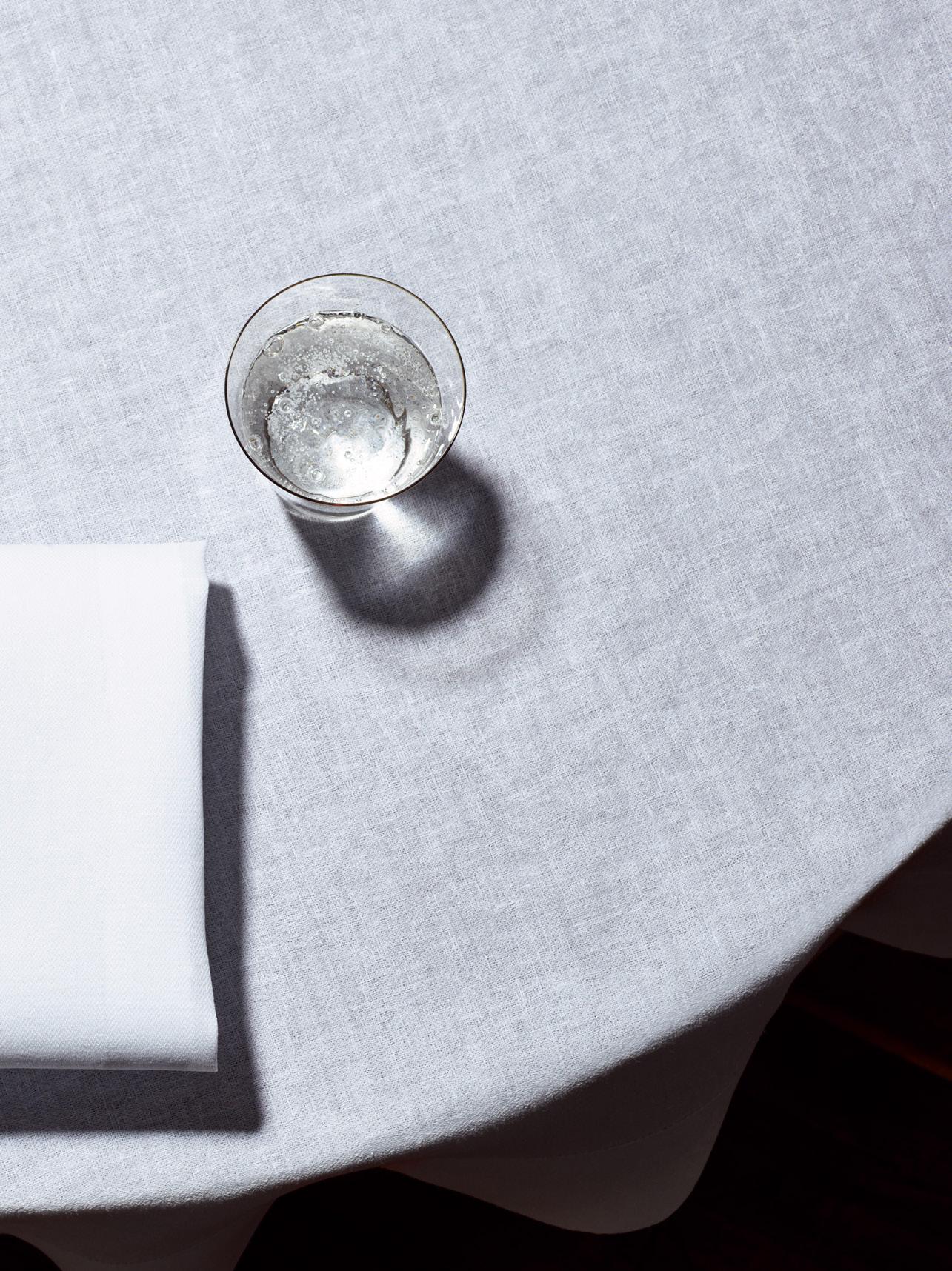
But there is one thing we must always keep in mind: We are the privileged ones. We must remain grateful and be aware that this is anything but a given. We eat and drink. Gladly and fully, full of humility.
So, within this context: May the food taste good – and sharpen our senses.
PHOTOS: THOMAS SCHAUER
79

80 S MAGAZIN RECIPE SUGGESTIONS
Recipe
A TRIP TO AUSTRIA AND BEYOND
1 Lard pastry with apricot kimchi, sour cream, pickled sturgeon & bronze fennel
2 Soave chili with cloves & smoked hazelnut
3 Chioggia turnip with pickled porcini mushrooms, scented roses & pinecones
4 Cucumber variety with eucalyptus & juniper
5 Crispy Jerusalem artichoke with fermented apple, thinly-cut lime & wood sorrel
6 6 Potato hash browns with Weinviertel kiwi, horseradish leaf & makrut lime
CULINARY CULTURE:
Over the centuries, Austria has developed a diverse culinary identity. Rooted in the Austro-Hungarian monarchy, its history has been developed and influenced by the various crown territories, thus making it a multi-ethnic cuisine with its own regional specialties, which are not limited to just a few dishes or regions. Of course, we can identify many tastes, products or preparation methods as belonging to a particular geographical area. But these different tastes also reflect and create cross-border connections with our families and our history, which in turn reflect our way of life and culture. A journey through Austria and beyond.
By the way: Viennese cuisine is the only one in the world that bears a city name. It originated more than 200 years ago at the Congress of Vienna in Viennese kitchens, where the most diverse cuisines shared their traditions and tastes in a peaceful mission, thus establishing the fame of Viennese cuisine.
INGREDIENTS
- 1000 g porcini mushrooms, small & firm
- 10 % Scented rose petals, cleaned
- 90% granulated sugar
- 500 ml Zweigelt verjus (Öhlzelt)
- 20 g Carpathian salt
- 20 g scented rose sugar
- 1/2 red Thai chili, fresh
- 12 lemon verbena stalks, coarsely chopped
PREPARATION
Prepare the mushrooms:
Carefully pat the porcini mushrooms dry and clean them using a brush or small sponge.
Cut slightly larger specimens in half.
Then transfer them into a sterilized 1000 ml screw-top jar.
Scented rose sugar:
Pluck the petals from the scented roses and clean them.
Tip: Separate according to varieties & colors. Mix together briefly in a Thermomix.
Preparing the preserve:
Boil all ingredients together, remove from heat, add the verbena and infuse for 4 minutes.
Strain and pour over mushrooms while hot.
Immediately close the jar and sterilize at 93 °C in a pressure steamer for 5–8 minutes, depending on the size.
Then cool as quickly as possible.
PORCINI MUSHROOMS (PRESERVED) WITH SCENTED ROSES, FOR A 1 LITER PRESERVING JAR 81
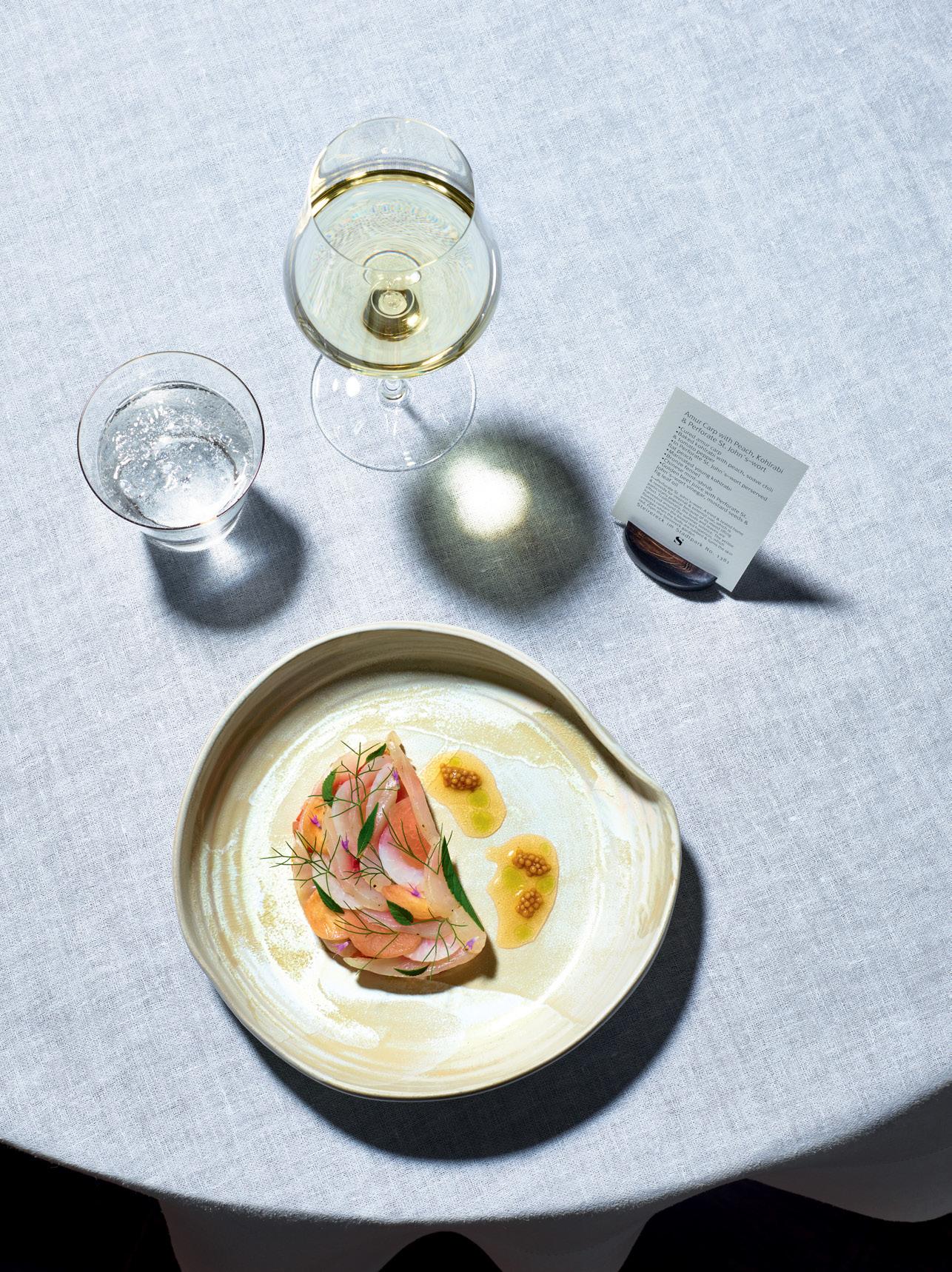
82 S MAGAZIN RECIPE SUGGESTIONS
AMUR CARP WITH PEACH, KOHLRABI & ST. JOHN’S WORT
1 Pickled Amur carp
2 Braised kohlrabi vegetables with peach, Soave chili & Paradeis peppers
3 Saturn peaches pickled in St. John’s wort
4 Marinated young kohlrabi
5 Bronze fennel
6 Chinese spice
7 Golden beet juice with St. John’s wort vinegar, mustard seeds & fig leaf oil
ST. JOHN’S WORT:
A time-honored home and medicinal remedy for internal as well as external use, which is especially popular for its mood-lifting effect. Traditionally, the buds and leaves are harvested around the summer solstice. The yellow flowers contain the blood-red hypericin, which comes out when the buds are rubbed and turns the skin red. From the garden at Steirereck.
PICKLED AMUR CARP, 4 PORTIONS
INGREDIENTS
- 2 g black pepper
- 7 g fennel seeds
- 4 g coriander seed
- 3 g juniper berries
- 2 bay leaves
- 300 g Carpathian salt
- 200 g granulated sugar
- 15 g pickling salt
- 1 Amur carp
- 100 g coarse sea salt
- Fish pickling solution
PREPARATION
Fish pickling solution:
Dry roast the spices in a saucepan over medium heat for about 1 minute without releasing too much color.
Then chop coarsely.
Mix the crushed spices with the salt-sugar mixture.
Amur carp pickling solution:
Fillet the Amur carp and cut out the Y-bones. Then sprinkle both sides vigorously with the pickling solution.
Fill a shallow dish with coarse sea salt, sprinkle the fillets with the skin side down on the salt and cover the meat side with the remaining dressing.
Cover with baking paper, refrigerate and pickle for between 8 to 12 hours, depending on the thickness of the fillet.
After the pickling time, briefly rinse the fillets with cold water, pat dry and vacuum seal.
Keep refrigerated for at least 12 hours.
After this time, remove the fillets from the vacuum, peel off the skin and portion.
Tip: The vacuum will cause the meat separated by the bone cut to stick together again.
83
Recipe

84 S MAGAZIN RECIPE SUGGESTIONS
Recipe
FENNEL WITH BERGAMOT, HEMP, SALTED FIGS & LOVAGE
1 Glazed young fennel braised with hemp, star anise, lime & verjus
2 Roasted hemp seeds
3 Fennel bergamot cream
4 Salted figs
5 Crispy rolled barley
6 Lovage powder
7 Caramelized fennel seeds
8 Lovage
9 Clarified braised fennel juice with roasted fennel seed & lovage oil
HEMP SEEDS:
True or Indian hemp is one of the oldest cultivated plants in the world. Hemp is considered a superfood and is one of the ten most valuable and nutrient-rich foods in the world. The hemp seeds (nutlets) contain all the right ratios of essential amino and fatty acids to meet human nutritional needs. From Heidenreichstein/Lower Austria.
BRAISED YOUNG FENNEL, 4 PERSONS
INGREDIENTS
- 75 ml hemp oil
- 200 g shallots, peeled & coarsely chopped
- 1 pc. star anise
- 20 g Carpathian salt
- 40 g granulated sugar
- 250 ml Pernod
- 75 ml Vetliner verjus (Öhlzelt)
- 50 ml white balsamic vinegar
- 1000 ml chicken stock
- 2 fennel bulbs
- 1 tbsp butter
- 1 lime (squeeze)
- 1 tbsp hemp seeds (roasted)
PREPARATION
Sauté shallots and star anise in a saucepan until colorless.
Add and release the juices until you get a syrupy consistency.
Deglaze and reduce for 10 minutes.
Pour in the chicken stock and reduce for a further 15 minutes.
Halve and remove the hearts of the fennel and trim.
Place the fennel hearts in the stock and let them simmer slowly, covered, at 90 °C for about 75 minutes until soft.
In a sauté pan, reduce 250 ml of fennel stock to about 80 ml, add 1 tbsp of butter, add fennel and glaze.
Sprinkle with lime zest and toasted hemp seeds.
85
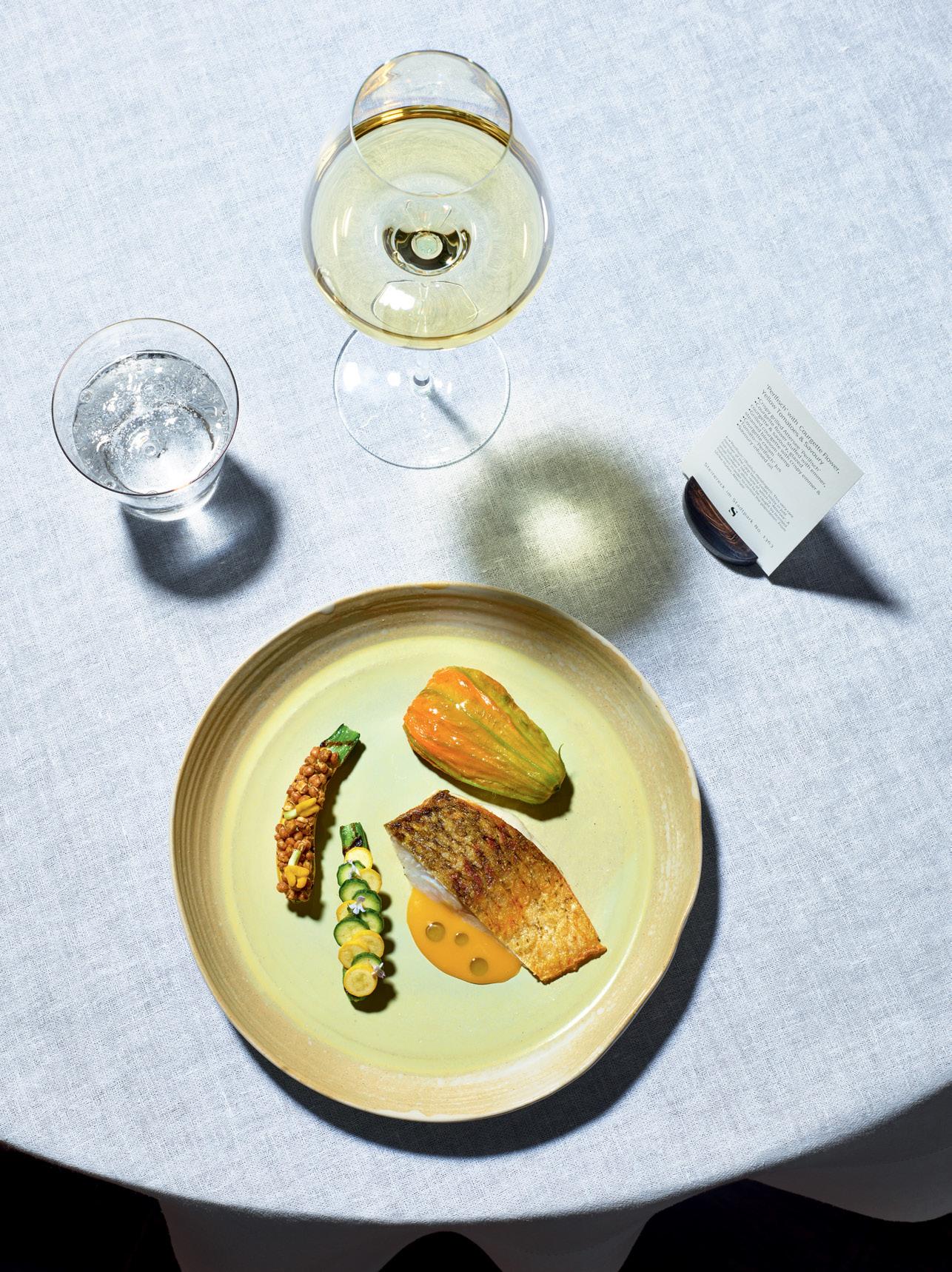
86 S MAGAZIN RECIPE SUGGESTIONS
Recipe
PERLFISCH WITH COURGETTE FLOWERS, YELLOW PARADEIS PEPPERS & SUMMER SAVORY
1 Crispy fried Attersee perlfisch
2 Courgette flowers stuffed with emmerwheat, courgette & summer savory, steamed & glazed.
3 Fried courgette with crispy emmerwheat & steamed flower pistils
4 Zucchini cream
5 Paradeis pepper & perlfisch juice
6 Summer savory oil
PERLFISCH:
A carp-like, rare delicacy from Lake Attersee. Fishing them is strictly restricted and statistically recorded in order to control the population. It may only be sold by licensed professional fishermen. From Ulrike Huber, Attersee.
SUMMER SAVORY OIL, 300 ML
INGREDIENTS
- 400 ml grapeseed oil (Keller)
PREPARATION
Clean all coarse stems and dry parts from the summer savory.
Using a Thermomix, blend with the grapeseed oil on speed 8 for about 1 minute without heating.
Then heat the oil in a saucepan to about 85 °C, stirring constantly. Briskly pour/strain through a fine hair sieve (Belgian sieve) into a bowl set over ice and stir until chilled as quickly as possible.
Decant the cooled oil into small units and store in a dark, refrigerated place until further use.
Tip: By heating briefly and cooling quickly, the oil retains its fresh flavor and color.
- 150 g summer savory, blue-flowered, cleaned 87

88 S MAGAZIN RECIPE SUGGESTIONS
Recipe
HEART OF LEEK WITH COOKING SALAD, ORANGE BLOSSOM AND SALTED APRICOT
1 Braised leeks whole with caramelized coriander seeds
2 Steamed young spinach
3 Cooking salad and celery vegetables with roasted almonds
4 Celeriac pickled in orange blossom spice broth
5 Green almonds
6 Buttermilk & salted apricot whey
6 Olive oil with herbs
ORANGE FLOWERS:
Orange and bitter-orange blossoms from the Schönbrunn Orangery. By Heimo Karner, orangery gardener at the Austrian Federal Gardens/Vienna.
CELERIAC (PICKLED) WITH ORANGE BLOSSOM & SPICES , 4 PORTIONS
INGREDIENTS
- 7 g bitter-orange blossoms
- 125 g sugar syrup 1:1
- 1 young celeriac
- 100 ml bitter orange blossom syrup
- 50 ml lime juice, strained
- Carpathian salt
- 1/2 teaspoon coriander seeds, roasted
- 5 g ginger, coarsely chopped
- 1 pc. lemongrass
PREPARATION
Bring the sugar syrup to the boil and cool quickly. Place the cooled sugar syrup with the bitter orange blossoms in a vacuum sealed jar.
Tip: Vacuum seal only with ice-cold lauter sugar.
Cook in a water bath at 60 °C for 15 minutes. Cool quickly and let it mature in a refrigerator for at least 24 hours.
Peel the celery and cut into thin (about 1 mm) slices.
Boil together once briefly, remove from heat and let steep covered for 30 minutes. Strain and boil the sliced celery in the mix once.
89
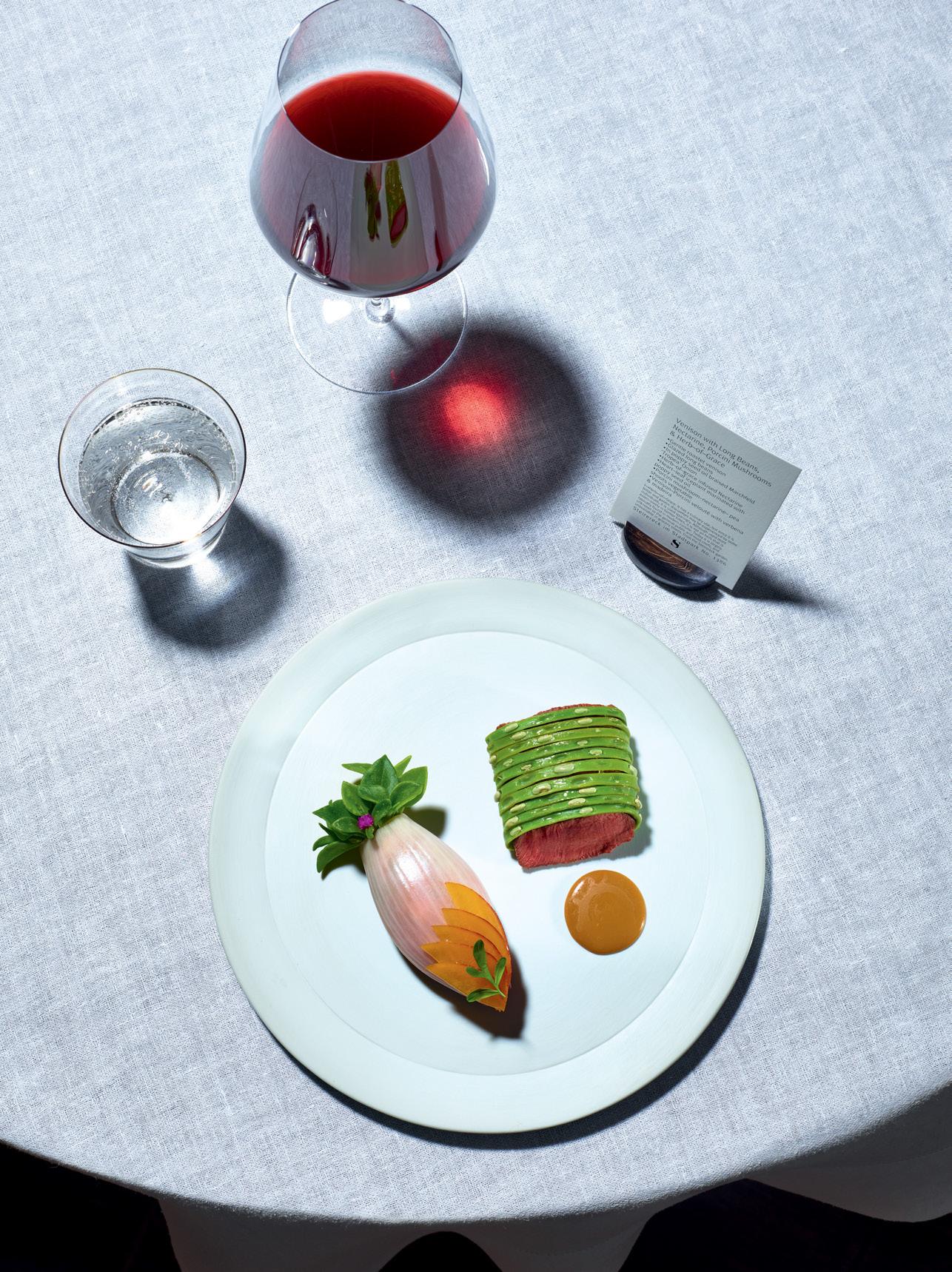
90 S MAGAZIN RECIPE SUGGESTIONS
Recipe
ROEBUCK WITH SNAKEBEANS, NECTARINES, PORCINI MUSHROOMS & RUE
1 Gently roasted roebuck
2 Glazed snakebeans
3 Marchfeld Tropea sweet onion braised with poppyseed oil
4 Nectarines preserved in rue verjus
5 Salad heart marinated with poppyseed oil
6 Porcini mushroom with nectarine and green sugar snaps
7 Roebuck-porcini velouté with Madeira & verbena
RUE:
The blue-green, pinnate, oily leaves of this spice and medicinal plant have an aromatic bitter-sweetishsoapy, idiosyncratic aroma with hints of passion fruit. In ancient times and in the Middle Ages, rue was considered a powerful medicinal plant and was popularly used as a spice for hearty dishes and sweet foods. Even today, rue leaves are used to flavor grappa. From the garden at Steirereck.
TROPEA SWEET ONIONS (BRAISED) WITH POPPYSEED OI, 4 PORTIONS
INGREDIENTS
- 4 Tropea sweet onions (Marchfeld)
- Vegetable oil for frying
- 40 g shallots, peeled & coarsely diced
- 15 ml poppyseed oil
- 50 ml Madeira
- 15 ml Zweigelt verjus (Öhlzelt)
- 10 ml white balsamic vinegar (Bertolli)
- 4 g Carpathian salt
- 8 g granulated sugar
- 250 ml chicken stock
PREPARATION
Cut the Tropea onions in half lengthwise, including the skin, and then fry the cut surfaces with oil on a grill plate at 200 °C until they gain a little color.
Tropea onion braising stock: braise the shallots with the poppyseed oil over medium heat until golden.
Add, deglaze and reduce by half.
Add the chicken stock, bring to a boil and then strain through a slotted sieve.
Place the halved, fried Tropea onions in an ovenproof dish, pour the stock over them, cover and braise in a preheated oven at 200 °C for about 10 to 15 minutes (depending on size).
Note: The onions should be soft and sweet, but still have some crispness so that they do not collapse when removed.
Lift out of the stock and allow to cool.
Cut off the root base and separate the individual layers of the braised onions like small bowls.
91

92 S MAGAZIN RECIPE SUGGESTIONS
Recipe
ICED NASHI PEAR WITH ELDERFLOWER, PASSION FRUIT & THAI BASIL
1 Nashi pear infused with elderflower, sherry & peach liqueur
2 Iced parfait of caramelized apples & pears, with pear brandy aged in a wooden cask
3 Passion fruit
4 Szechuan pepper & lime
5 Thai basil
6 Nashi pear, peach & passion fruit iced tea
7 Elder blossom oil
ELDERFLOWER:
Popular flowers for syrup, vinegar or sparkling wine production with a fine muscatel aroma.
NASHI PEAR (PRESERVED) WITH ELDERBLOSSOM, SHERRY & PEACH LIQUEUR, 4 PORTIONS
INGREDIENTS
- 200 g elderflower syrup
- 150 g water
- 35 g sherry
- 35 g sake
- 35 g peachtree
- 1 tablespoon yuzu juice
- 2 nashi pears (preserved)
PREPARATION
Mix all ingredients, stirring while on ice until cold.
Peel the nashi pears and cut them into 1.5 cm-thick slices.
Cut out slices with a 7 cm round cutter and then remove the core with a 3 cm round cutter.
Infuse the nashi pear slices with the cold stock.
93

94 S MAGAZIN RECIPE SUGGESTIONS
Recipe
POMPO SQUASH WITH PYHSALIS & BITTER ORANGES
1 Braised pompo squash with physalis, vanilla & hot lemon chili
2 Caramelized gelled hay milk whey
3 Pompo squash marinated with verjus & verbena
4 Pumpkinseed cake
5 Bitter-orange topping
6 Crispy Little Buddha physalis
7 Orange tagetes
8 Pompo squash stewed juice with cold-pressed pumpkinseed oil
9 Bitter-orange blossom ice cream
LITTLE BUDDHA PHYSALIS:
The fruits are rich in vitamin C and have a high pectin content.
Grown by the Wurm family at Oftering, Upper Austria.
PUMPKIN SEED CAKE, 12 PORTIONS
INGREDIENTS
- 160 g butter, room temperature
- 40 g powdered sugar, sifted
- 40 g cane sugar
- 2.5 g vanilla fleur de sel
- Grated lemon
- 180 g egg yolk
- 50 g pumpkin seeds
- 180 g egg white
- 140 g granulated sugar
- 1 pinch of Carpathian salt
- Butter & egg mix
- Egg whites
- 220 g wheat flour, smooth
- 110 g pumpkin seeds, fried, salted & ground
PREPARATION
Butter, sugar and egg mix:
Beat the butter, sugar and aromatics in a food processor with the whisk until very fluffy.
Mix both ingredients and very slowly incorporate into the whipped butter.
Keep the food processor running slowly while doing this.
Whipped egg whites:
Whisk the egg whites and salt in a food processor, gradually sifting in the granulated sugar.
Pumpkinseed cake (bake):
Preheat a convection oven to an air temperature of 180 °C and a fan speed set at 2.
Fold the beaten egg whites, flour and finely ground pumpkinseeds alternately into the butter and egg mix.
Spread the dough evenly in a deep 1/1 banking tray lined with baking paper and bake for about 35 minutes.
Turn the cake out of the pan while it is still warm and then wrap it in cling film and let it cool.
95
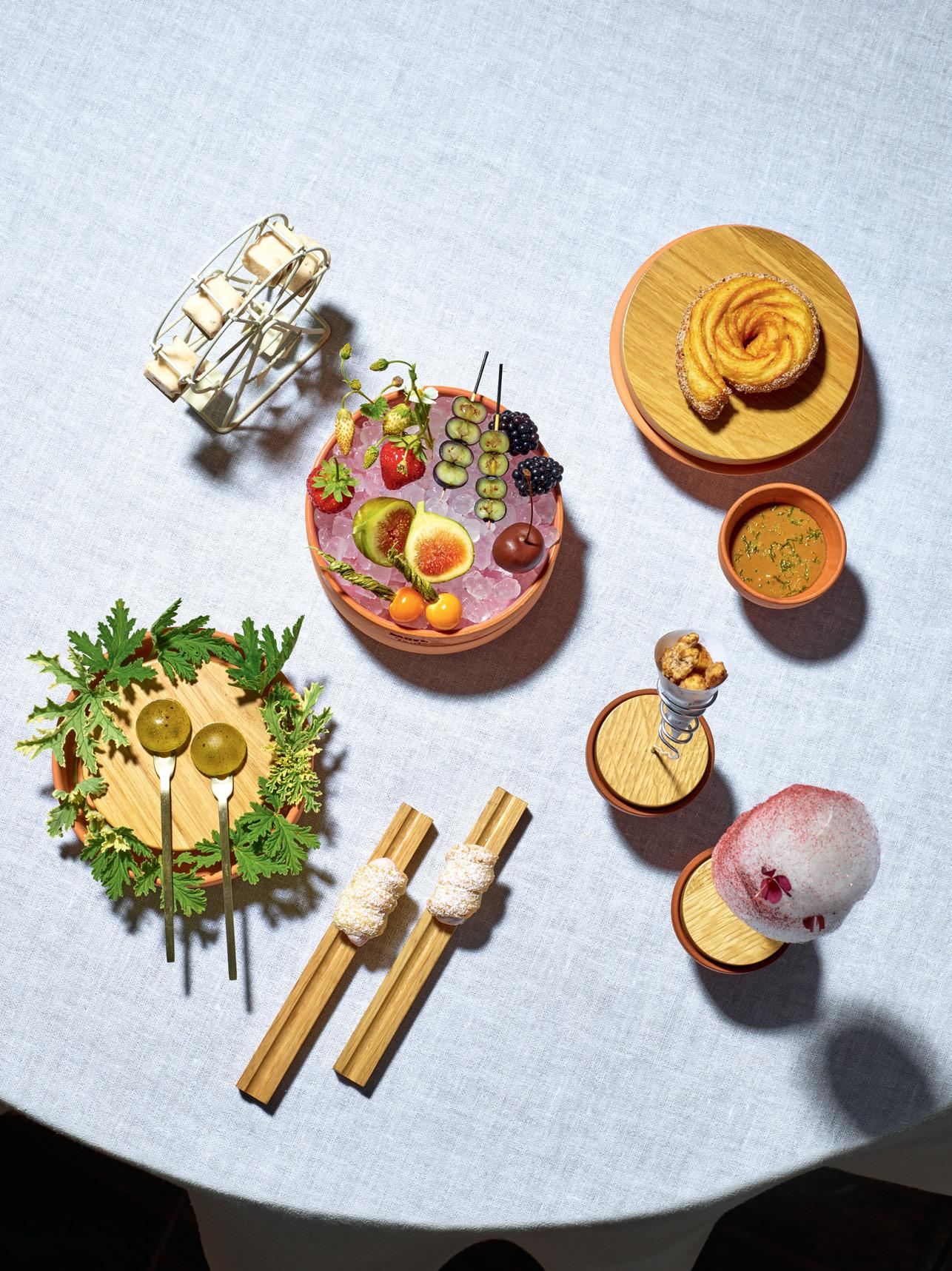
96 S MAGAZIN RECIPE SUGGESTIONS
Recipe
VIENNA PRATER
1 Spritz cookies with coriander, Schönbrunn lime & boiled-down organic raw milk
2 Roasted nuts
3 Redcurrant cotton candy with wood sorrel
4 Cream-filled pastry roll with Vienna malt & Vienna figs
5 Iced lemon & pelargonium gum
6 Apricot & tarragon marshmallow
7 Viennese fruits
SPRITZ COOKIES WITH CORIANDER, 4 PORTIONS
INGREDIENTS
- 5 0 g coriander seed
- 400 g organic raw milk
- 56 g butter
- 19 g cane sugar, brown
- 141 g wheat flour, plain
- Salt, orange & lime zest
- 2 organic eggs
PREPARATION
Bring all ingredients except the flour and eggs to a slow boil in a saucepan.
Once the milk comes to the boil, stir in the flour and “burn off” over medium heat.
Then pour the still-hot mixture into a mixing bowl and beat with a whisk until smooth.
While still warm, add the eggs and continue beating for about 5 minutes until the mixture is totally cool.
Now fill the choux pastry into a piping bag and, using a piping nozzle, pipe it into hot fat (approx. 180 °C) and bake until golden brown.
97

98 S MAGAZIN GLASS WISE

TEXT: SEBASTIAN HOFER
PHOTOS: PHILIPP HORAK
A tale about global warming and extreme weather, hail and sunshine, about the departure from old certainties and about the question: What does all this mean for wine? What will we drink in the future? And why?
WINE IN TRANSITION
99
When Martin Muthenthaler stands at the top of Vießlinger Stern and looks along Spitzer Graben, he can see the future and hear the past. He sees his vineyards and hears the echo of his colleagues who, some more loudly than others, called them nuts back in the 1980s and 90s. The “nuts” were those few Don Quichottes from Wachau who tended their vineyards up there, where the sun never shines and where Wachau ended long ago, on steep, barren hills between old dry-stone walls, a thoroughly laborious and manual feat. Today, Muthenthaler, who once learned to be a car mechanic and worked for a long time as a driver at Domäne Wachau, knows that the effort was worthwhile and that he backed the right horse: vineyards that have a future.
Because this future will be different from what people were used to in the 1980s and 90s. Warmer, drier, more extreme. Hardly anyone today would want to dispute the fact that the climate is changing, and anyone who does want to dispute it should talk to a wine producer. He will tell him what has happened in the past ten or 15 years and what the effects are: The hotter years are becoming more frequent, the storms more dramatic, the wine producers’ worries greater. There is a fine line between drought and severe weather; anything can happen at any time. However, on the other hand, where grapes rarely ripened in the past because it was too cold or too shady – for example back there, at the upper end of the Spitzer Graben – today they develop just perfectly.
René Antrag, the sommelier at Steirereck, opens a bottle of Martin Muthentaler’s 2015 Riesling Vießlinger Stern and quickly goes into raptures as he explains: “Yes, this is exactly how it must be today: a radiant, vibrating wine from what was actually a super-hot year. Nevertheless, elegant, slender, with only twelve percent alcohol. Of course, this has to do with the location, which is very high and very cool. But
that’s not all. There is no irrigation up there and cultivating the vineyards is a real challenge. The individual elements all have to gel: You need the right variety of grape, you have to do everything right in the vineyard in terms of tillage and foliage work. And you can’t afford any mistakes in the cellar. You can’t do one thing without the other. But now taste this wine. It’s just as it should be.”
Little in this world is as complex as climate, and nothing so complicated as responding to these new realities as a wine producer. No matter what or how you do it – you get it wrong at first. Because the old certainties be come blurred faced with the new unpredictability of the weather. Producing wine also very often involves making mistakes. The important thing is that you learn from your mistakes and that, ideally, you don’t do things completely wrong. The path to good wine often leads through compromise; you can’t radically change from year to year just because conditions change dramatically.
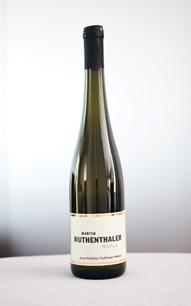
“The individual elements must all gel. You need the right grape variety, you have to do everything right in the vineyard, and you can’t afford any mistakes in the cellar.”
Armin Tement, a wine producer in southern Styria, knows exactly what he’s talking about when he mentions these new difficulties – without even speaking of the unfortunately increasingly frequent hailstorms, against which nothing can be done. All the rest can be managed: in hot years, leave more grapes hanging on the vine to delay ripening and preserve freshness. In rainy years, remove more grapes to improve air circulation. Never anything too extreme that might throw the vines out of their long-existing balance. Because it is the equilibrium of the vineyard that counts. Armin Tement explains the basic principle: “We will experience more and more extremes, but if the vineyard is in equilibrium, it can handle these swings. One day you have to deal with a lot of precipitation, the next day with a lot of drought.
100 S MAGAZIN GLASS WISE
03 Martin Muthentaler shows René Antrag his locations in the Spitzer Graben. In the past, they were ridiculed up here. Today everything pretty much fits.

101



Then, at the end of the process, sometimes the wine’s pithiness is emphasized and its juiciness at other times. Both features have their qualities.” For the wine producer, of course, this means that he can no longer work according to a pattern, but has to feel his way up to the respective vintage. With the emphasis on: feel. Because every decision a wine producer makes has an enormous impact, sometimes for many years to come.
04 Armin Tement knows that if a vineyard is in balance, it can withstand even extreme conditions. For the wine producer, of course, this means that a “pattern” no longer applies.
The biggest of all fundamental decisions concerns the question of which grape varieties a win e producer actually plants –and which will still be suitable for viticulture under future conditions. In particular, the typical Austrian varieties Zweigelt and Grüner Veltliner will probably no longer thrive everywhere in the way they used to. Armin Tement has it comparatively easy in this matter; the leading varieties of his region, especially Muskateller and Sauvignon Blanc, are coping quite well with global warming so far. A few kilometers to the west, in
a site that can certainly keep up with Spitzer Graben in terms of coolness and barrenness, the 2017 Sauvignon Blanc Ried Hochsteinriegl from the Wohlmuth winery in the Sausal valley also shows this – matured for a long time, but still not opulent, because cool nights promote aroma ripening without the sugar content immediately shooting up unpleasantly. René Antrag: “This is delicate and precise, this is absolutely the future, also in terms of aging: here the wine is given time, in the cellar and then also in the bottle.”
One that usually hardly ever got the time it deserved is Welschriesling. However, that is also changing, because the good old Heurigen variety is increasingly proving to be a real model for the future. Not only in Styria is it increasingly becoming the focus of top wine producers. How ever, due to the fact that the variety has long suffered from a poor image, old Welsch vineyards in great locations are unfortunately rare. Armin Tement fortunately still has a Welsch vineyard, which
102 S MAGAZIN



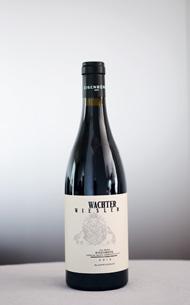
pro duces his Welschriesling Weinstock Alte Reben 2014 and which shows what this variety is capable of. René Antrag is – once again –enraptured: “For me, this has the elegance of an Aligoté from Burgundy. It’s not loud, not obtrusive, it conveys the terroir, has enough tranquility due to long yeast aging, and at the same time a vibrant acidity that makes this wine incredibly exciting. This also pairs quite nicely with delicate, elegant cuisine.”
A similar caliber, with a somehow also quite similar, yet somehow completely different story: Michael Wenzel, Furmint Garten Eden 2017 . Wenzel’s Garten Eden is located on a hill above Rust, with the best view of Lake Neusiedl, where his Furmint has been a matter close to the wine producer’s heart for years. He didn’t think about the climate at first – but now he’s also right. Hardly any other variety is so well adapted to the new, so-called high Pannonian period, can cope so well with the heat and even when fully matured still appears fresh and full-bodied and rich in tannins. And yes, that is a compliment!
Because the temperature is not the only thing that has changed over recent years. A lot has also changed in terms of style: white wines may, indeed should, have a certain phenolic structure; red wines, on the other hand, can also be more delicate and drinkable. Demand has also changed at Steirereck, says René Antrag: “Red and white wine styles are definitely converging. Of course, there are still the powerful, opulent red wines we know from the classic blockbuster vintages, and there probably always will be. But the trend is moving in a different direction. And in white wine, people are no longer just looking for young-fresh-crisp, but increasingly for expression and structure.” This will also change the evaluation of vintages: “I suspect that in the future people will derive more pleasure from the cooler vintages than with particularly sunny ones.
Today, the heat is simply too extreme too quickly for those.”
Where extreme prevails, must also be balance. When the weather fluctuates, the vineyard needs to rest itself. One doesn’t need to fully go into biodynamics. It is also enough if the wine producers give their vines what they need: a natural environment and a steady hand that acts in the awareness that yesterday’s received knowledge about vineyards is outdated. It is no longer about the highest sugar level or maximum extract, but about elegance, about a cool vibration, about white wines that become a bit like red wines, and about red wines like the St. Laurent Frauenfeld 2016 from Johanneshof Reinisch , of which René Antrag sings the following praises: “This is a wine that really embodies the Thermenregion, from a vintage that is really not a classic blockbuster vintage. This goes in a filigree, Burgundian direction, it’s red berry, floral, delicate, with super juicy tannin, subtle, playful, great.” A different Austrian state, a similar style – and once again an ode: Blaufränkisch Alte Reben, Weingut Wachter-Wiesler, 2014 vintage: “This is really outstanding. Internationally, Blaufränkisch has now become the leading Austrian signature variety. And also extremely well-suited for hot years. It’s bony, precise, always structured despite high ripeness, and keeps focus unless you do something to it in the cellar that doesn’t do it justice. But that’s definitely not the case here, the structure from the vineyard has been gently carried forward in the cellar. This is of course an advanced wine, not a flatterer, but super crisp, super juicy, has currant, grapefruit. And we’re talking about an officially bad vintage here. This is the kind of thing that comes out when the wine producer really engages with nature.”
That, in turn, is now a really good segue to talk about Gernot Heinrich, or better yet: with him. Whilst visiting Gols, the wine producer shows what he has – and
103
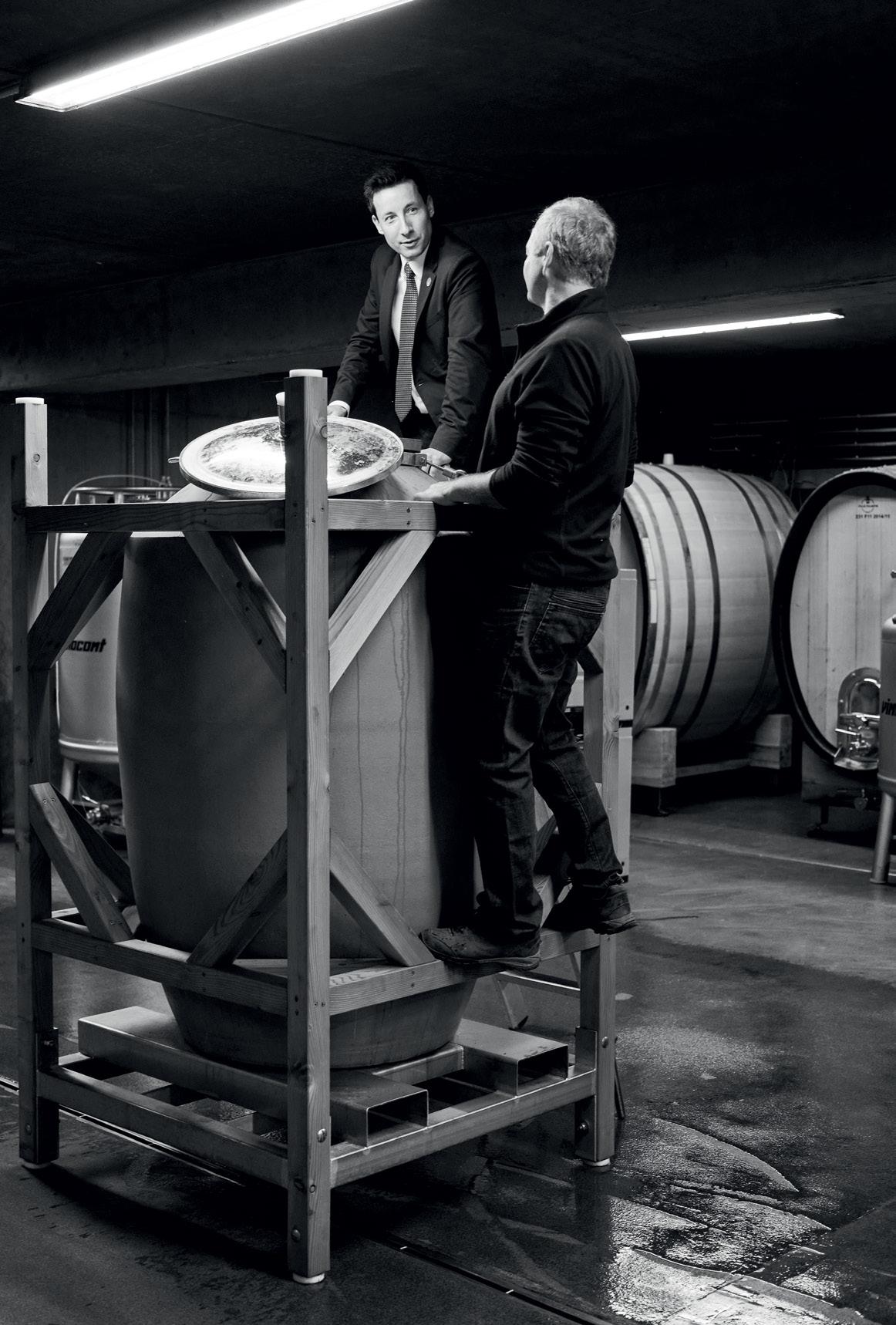
104 S MAGAZIN GLASS WISE

105
05–06 Visit to Gernot Heinrich’s vineyard in Gols. He says: “If you let nature take its course in the vineyard, then you must also be able to let go in the cellar.”
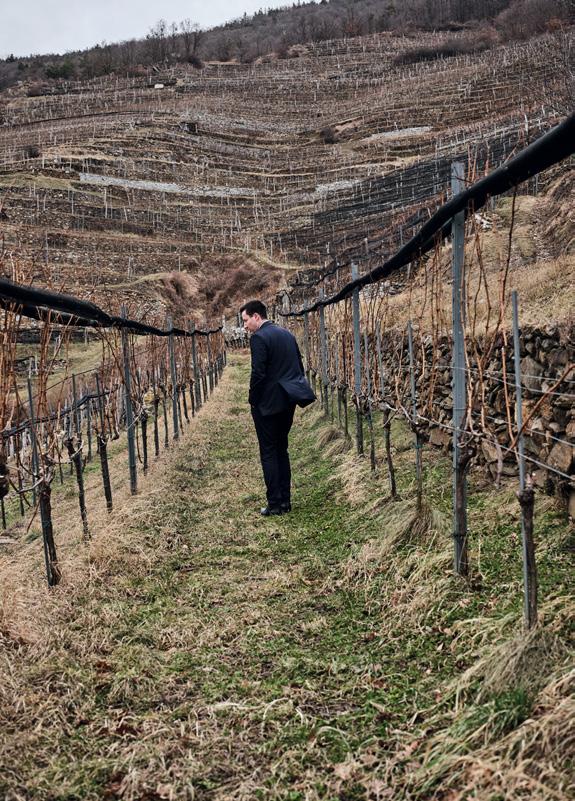
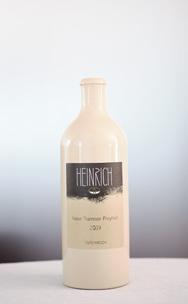

what he does with it: large concrete vats in which it, well, bubbles. Whole red wine grapes, complete with stem and stalk, lie on the mesh and perform, very gently and unceremoniously, the miracle of nature: tannins are leached out, sugar is converted to alcohol, colorants are released – but because it all happens so carefully, it also happens only in moderation. “If you let nature take its course in the vineyard,” says Gernot Hein rich, who has been working biodynamically for a long time, “then you also have to be able to let go in the cellar. I can’t work in the vineyard as homeopathically as possible and then according to a preconceived pattern in the cellar. I must also have some trust in my grapes.”
At the end of this process, which gives nature a long leash and trusts the grapes, are wines like Gernot Heinrich’s Roter Traminer Freyheit 2019 , which René Antrag is now conjuring out of the cooler: “Traminer is a grape variety that loses acidity very quickly after a certain maturity. Then it depends
on the time of harvest, but also on the vinification. If you vinify it classically, you get a very loud, fruity, creamy wine that lacks acidity. But if you vinify Traminer the way Gernot Heinrich does it, two weeks on the skins, gently extracted, with whole grapes, then you get back some of the structure, the tannin. Then the fruit is crisp, the wine light-footed, elegant and not at all flushed out. It’s crisp, it’s got citrus, bergamot, but still the fragrance of Traminer. It’s just uncomplicated at a high level. This is the future.”
The future can come.
106 S MAGAZIN GLASS WISE
08–09 Vines on the Spitzer Graben. Little in this world is as complex as climate, and nothing is as complicated as responding to new conditions as a wine producer.
When you go on a trip, then ... you also have to eat something. Or you want to. Or your spouse. Or both of you. The Reitbauers wanted to. And so they ended up in Hatzendorf, Styria, because there was someone there who knew how to cook. Who was also part of the Steirereck family. And whose father had already anointed Heinz with oil, artistically mind you. Severin Corti, on the other hand, traveled to Lake Garda because uncooked pasta is steamed in a pig’s bladder there. And Erwin Steinhauer? He traveled from the 19th district, where he lives, to the Stadtpark in the 3rd district. To eat and chat.
Near & far
S. 108
S. 116
S. 126
S. 128
OTHER HORIZONS
A TALE ABOUT PETER’S CULINARY ART AND ABOUT PETER HIMSELF CHEF AND ARTIST
THE BARN THAT BECAME A TEMPLE
107 S MAGAZIN NEAR & FAR
SUBSCRIPTION TO THE SAUSAGE STAND 4


01–03
The Troißingers: Peter Sr., master chef and recognized artist, immortalized his father’s hands as doorknobs.
108 S MAGAZIN HOME VISIT
Peter Jr. also not only cooks, but invents seasoning sauces and creates fine wooden boards for restaurants.
When Reitbauers make a culinary trip, they like to visit former employees. This time they visit Peter Troißinger, who once successfully insisted on being allowed to commute between Vienna’s Stadtpark and Styrian Pogusch.

A TALE ABOUT PETER’S CULINARY ART and
AB OUT PETER HIMSELF, CHEF AND ARTIST
TEXT: ACHIM SCHNEYDER
PHOTOS:
109
MIRCO TALIERCIO
It’s pretty incredible to have so many top chefs somewhere in the middle of nowhere, under the same roof and all at the same time. A rendezvous of the crème de la crème of domestic and international cuisine, so to speak, because among many others Johann Lafer and Harald Irka are there. In the stairwell you can meet Steffen Mezger, Johanna Maier and Wolfgang Puck. Juan Amador, Eckart Witzigmann, Mike Süsser and Manuel Ressi are hanging around somewhere, and now Heinz Reitbauer also comes in the door accompanied by his wife Birgit.
Heinz is immediately amazed when he spots all his professional colleagues. “This is extraordinary,” he says apprecia tively, “really quite great.” And the host, Peter Troißinger, accepts the compliment with a happy smile.
Now for the explanation: We are in the southeast Styrian Vul kanland in Hatzendorf, not far from Riegersburg. Whilst the vil lage of Hatzendorf is very unre markable in itself, the restaurant and art hotel Malerwinkl located there is impossible to miss. First, because it is located directly on the main road, and second, be cause countless sculptures and art forms decorate the area around the building. Peter Troißinger Senior, born in 1958, a trained chef and untrained artist, created all these works of art and, when you finally enter the restaurant, you can meet the aforementioned cooks. Over the past nine years, the selftaught artist has painted 80 portraits in oil on canvas, and Heinz Reitbauer is obviously one of this illustrious group. However, so is – no means as a matter of course, but all the more surprising nonetheless –Otonde Odera, the former personal chef of the Ugandan dictator Idi Amin. “Odera’s face fascinated me immensely,” says the cooking painter and painting chef, whose entire artistic oeuvre comes under the umbrella term “troiss eat & art”.
Today and here, however, it’s mostly about Peter’s son Peter, who has long since taken over the kitchen of his parents’ business, but is still happy to let his father lend a hand. “The future belongs to him, he calls the shots, he’s the boss at the stove, I’m an underling,” says Peter Sr., who once flexed his creativity as a master chef at the Hotel Vier Jahreszeiten in Hamburg and the Hotel Intercontinental in Cologne.

Peter Jr., born in 1986, has been at the stove since eight o’clock in the morning on the day the Reitbauers announced their arrival for lunch. “I feel bit like I used to when I had to prepare a rehearsal dinner for a boss,” says Peter, as he bones the pike fillet, which will later be steamed and finished with pike roe that has previously been marinated in salt and sugar for twelve hours and framed by Riesling foam as part of the excellent multi-course menu.
can be found in just about every corner of the Malerwinkl. Only the kitchen is virtually an art-free zone, except for the fact that what Peter and Peter create at the stove under the son’s leadership is indeed great culinary art.
Peter, whose sister Anna acts as hostess and hotel manager, while Mr. Karl, a friend of the family, has the wine under control and is in charge of the service, and Mama Gabi is the good spirit of everything at all, learned in his time in a business in Riegersburg. After his apprenticeship, he moved for a year to the Obauer brothers in Werfen, one of the top addresses in the country. “I was,” he reminisces, “always insanely ambitious. While the others took their five-minute smoke break during their apprenticeship, I kept on studying. Six times five minutes a day, that’s half an hour a day. When you reckon that over the four years of my apprenticeship, that’s a hell of a lot of time you have under your belt and then, in the end, that time might give you an edge on some others...”
“He wasn’t just ambitious, he was downright obsessed,” adds his father. “He stopped all his hobbies, creating dishes in his mind and taking notes in the evenings instead of continuing to play tennis, and on weekends and days off he watched every cooking
“The future belongs to him, he calls the shots, he’s the boss at the stove, I’m an underling,” (Peter Sr.)
110 S MAGAZIN HOME VISIT
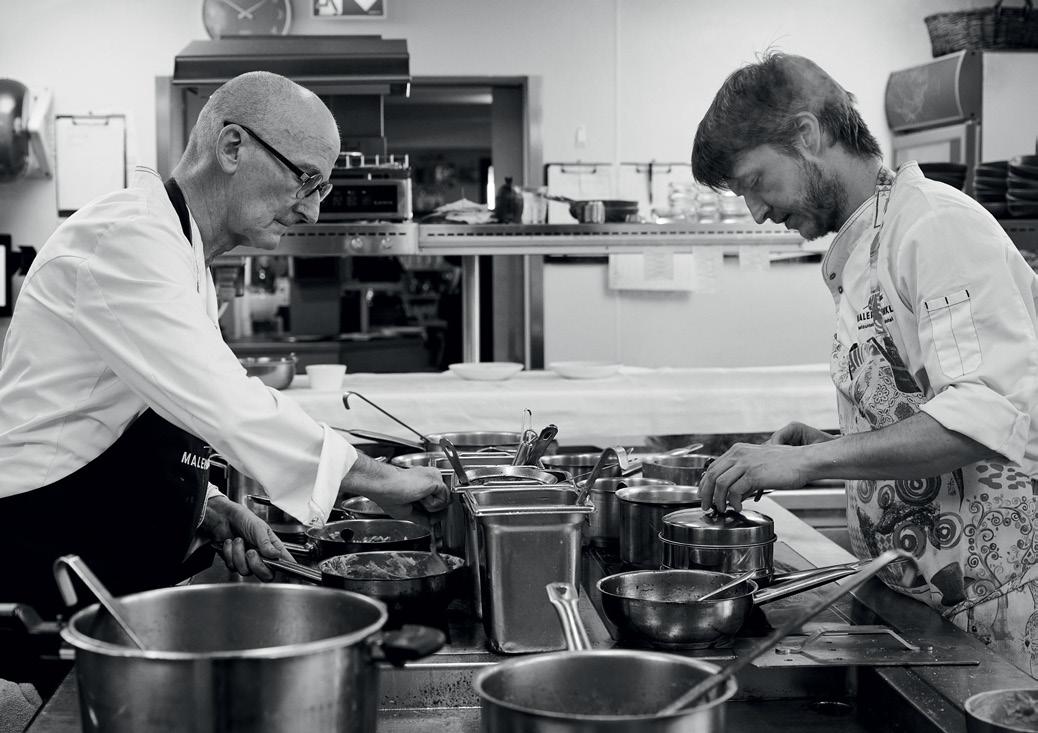
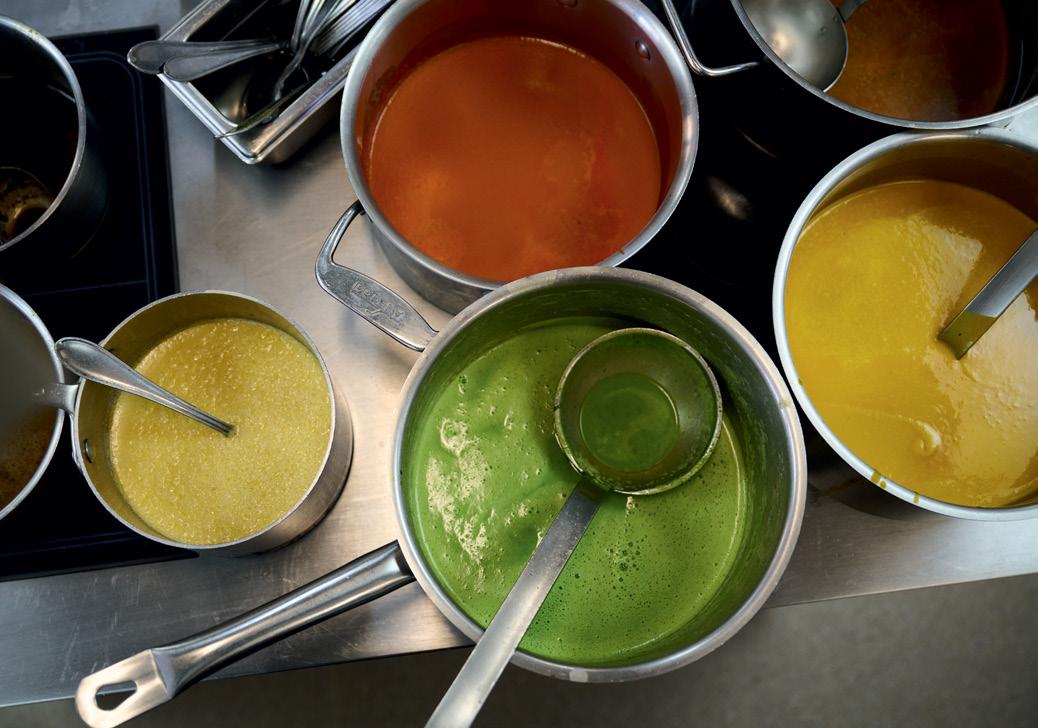
111

112 S MAGAZIN HOME VISIT
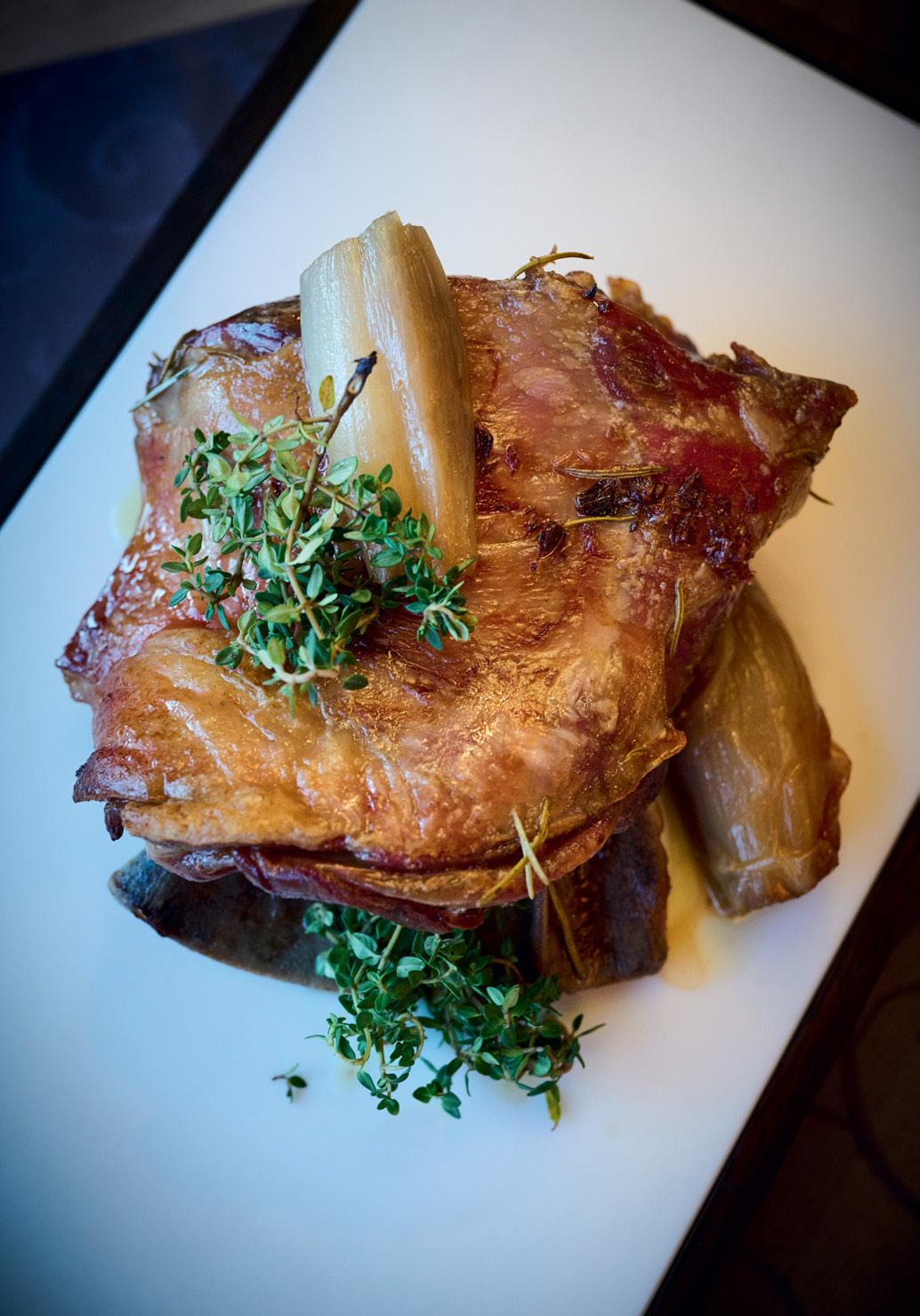
113


114 S MAGAZIN HOME VISIT
show imaginable on TV. Eventually, he became a state chef champion in the under-21 age group.” And by the way, he now plays tennis again, much to his father’s delight.
After the year with the Obauers, a job in a threestar restaurant in Italy beckoned, but there were six months to fill until that happened. “So I contacted Heinz Reitbauer because I wanted to go to Steirereck in Vienna. Reitbauer said no, because the kitchen at Steirereck was full, but then he offered me a job at Pogusch. ‘I’ll gladly take it,’ I said, ‘but only if I’m allowed to go to Vienna on Mon day and Tuesday, when Pogusch is closed, at least for a sniff around.’ He seemed to like that, so he said yes, ...”
“He was already immensely creative back then,” recalls Heinz, who eventually gave this inspired young chef at Steirereck after all, after the trip under those three-star Italian horizons ended a bit more quickly than originally planned. “It wasn’t really my thing there, although it was quite a great and famous place.” But today, when Peter talks about the kitchen at Steirereck and the people he was paired with there, his eyes light up: “Lukas Nagl, Philip Rachinger, Oliver Lucas and myself, we were quite a cool bunch, and all four of them eventually went off on their own and each made a career for themselves. And then there was Manuel Ressi, who was Reitbauer’s sous chef at the time. We were a great group!” After Steirereck, Peter went on to work in Shanghai and London before returning home in 2018.
second Malerwinkel in Austria, one with an E in front of the L, and it closed its doors forever at that time. While this regrettable error occurred, Peter Jr. just put his head down and kept working harder at his induction stove, and in 2021 was rewarded with a third Gault&Millau hat in 2021, source of pride for the cook and his fatherly sous chef.
“All too well deserved,” Birgit and Heinz pay their respects full of genuine enthusiasm as they finally enjoy foie gras, then lake trout, then pike, then Styrian-interpreted dumplings, then lamb, and last but not least, sweet rhubarb deli cacies.

Later, as the Reitbauers are about to set off again, they receive a small parting gift in the form of a small bottle. “A soy sauce, so to speak, but without any soy at all,” explains Peter, the inventor of Austria’s first fermented seasoning sauce based purely on Styrian sweet lupines. “The lupine is one of the most protein-rich fruits on earth, and we grow it in Vulkanland, harvesting and processing it ourselves.”
And while they chat a bit about the lupine and the elegant wooden boards for the catering trade, which Peter creates and produces together with a carpenter friend, Peter Sr. quickly pours a farewell sip. It is a red wine bottled exclusively for the Troißingers from the Kolleritsch winery in Tieschen, and the label was designed by Peter, who else?
At that time, two Gault&Millau chefs’ hats adorned the Malerwinkl, then a year later father and son also wore two together at the stove. And then, in 2020, the Malerwinkl suddenly disappeared from Austria’s leading restaurant guide. “A huge shock at first,” Peter and Peter recall, but the unfortunate circumstance was fortunately not due to a sudden decline in quality, but simply because there was a
“Bleibwein” or “wine to stay” is the name of the wine. And yes, that’s what you want here in the Malerwinkl once you’re there. Stay.
“The three-star temple in Italy wasn’t really my thing.” (Peter Jr.)
115
the extremely entertaining Mr. Karl, head waiter and expert in wine.
THE BARN THAT BECAME A TEMPLE
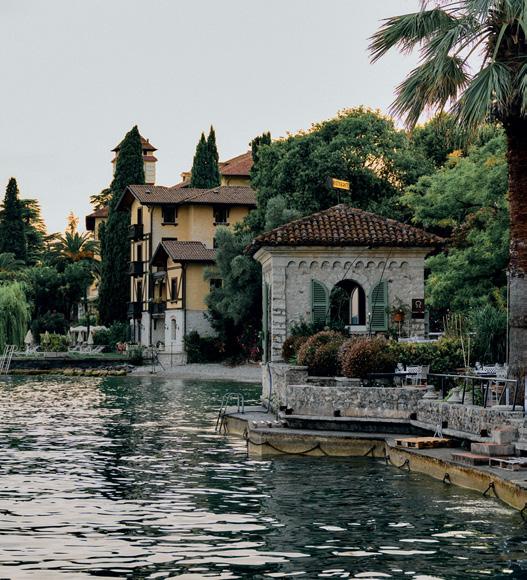
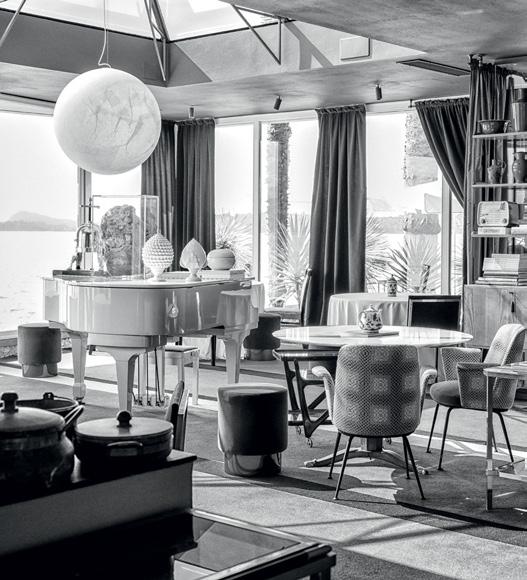 TEXT: SEVERIN CORTI
FOTOS: MIRCO TALIERCIO
01–03
TEXT: SEVERIN CORTI
FOTOS: MIRCO TALIERCIO
01–03
116 S MAGAZIN LAKE FESTIVAL
At Lido 84 (left), you enjoy with your feet in Lake Garda – so to speak: the former boathouse is now considered Italy’s best restaurant
RICCARDO AND GIANCARLO CAMANINI’S LIDO 84 MAY BE A COMPARATIVELY MODEST LAKE GARDA EATERY HOUSED IN A FORMER BOATHOUSE. BUT THE PLACE IS HAUNTINGLY BEAUTIFUL. AND THE CAMANINIS KNOW HOW TO CELEBRATE THE RAVISHING STRAIGHTFORWARDNESS OF ITALIAN CUISINE WITH WIT, BUT ABOVE ALL WITH THE VIRTUOSO TECHNIQUES OF HIGH CUISINE. THE RESULT IS FANTASTIC, CONTEMPORARY ITALIAN CUISINE. AND WHERE ELSE CAN YOU FIND IT?

117
It is like most places whose beauty is universally undisputed: You have to choose the time of your visit well in order to get the best out of it. If you go to Lake Garda in summer, i.e. at the wrong time, you will discover a somewhat out of date destination for German bus tourists and other senior citizens, when the place’s “splendor” is characterized by a faintly smelly breeze (although only in some places!) and incessant traffic jams along the impressive shoreline roads carved into the rock.
It’s better to come in spring, when here, south of the Alps, it starts to bloom and warm up much earlier.
Or in autumn, which at Lake Garda feels like an Indian summer until well into October. It is then that you have the breathtaking beauty of this impressive lake in the Southern Alps – and the no less impressive culinary traditions that are still cultivated here with jealous devotion – almost all to yourself.
If you approach the lake from the north, i.e. from Trento, the expanse that opens up can remind you of the sea. To the left and right, the mountains drop almost vertically into the water, whereas to the south the horizon loses itself in pink-golden infinity. The small towns on the northwestern shore have

118 S MAGAZIN LAKE FESTIVAL
enchantingly Italian names (Campione, Limone ...) and seem literally nailed to the cliffs, as the space between mountain and lake up here is so narrow. Further south, the landscape opens up and the mountain gives way to olive groves.
“The oil from here has a fruitiness all its own, smelling of fresh grass and bananas,” says Nicoletta Manestrini of Frantoio Manestrini in Soiano, who presses her oil on a press dating back to 1960. At the time, it was the first modern press in the region, and to this day many farmers bring their olives here because the gentle method of pressing makes the oil so particularly valuable. Deep green, with a noble pungency, it runs through the pipes when Ernesto Sanca, who has always worked in the olive grove and here at the Frantoio, fills the bottles. Some of these olive groves are home to very special treasures. Villa Arcadio above Salò is one of them, a former monastery in an eleven-hectare olive grove that has been transformed by Finnish-born Jaana Nakari and her son Aki into an intimate hotel with a magnificent view, choice antiques, and a really good restaurant (where, of course, they cook with the property’s own oil).
But today it’s off to a different restaurant. It’s lunchtime, exactly five minutes past 12:30 p.m. on
the shore road in Gardone Riviera, when the gate opens to reveal the narrow, steep road that leads down to Lido 84. Cars are already lined up outside, and a few guests have also arrived on foot. The ristorante has been bustling since the morning hours, but guests have to wait to be let down here to the lake and into the ristorante.
“We love the moment when the guests come in for lunch, when everything is set as it should be, the tables laid, the terrace swept, the kitchen in joyful anticipation of the lunch business. This is the moment when our restaurant is at its best,” says Giancarlo, “the moment when the guests sit down and the pranzo begins.” Together with his brother Riccardo Camanini, he runs Lido 84 in Gardone Riviera , right on the shore of the lake.
Since last October, Lido 84 has been considered Italy’s best restaurant, so to speak. It landed at number 15 in the highly regarded ranking of the “World’s 50 Best Restaurants,” virtually on a par with Steirereck (13) and with the best ranking of all Italian restaurants. For Riccardo Camanini, this was “a truly surreal moment”. The fact that this “better type of barn,” once built as a boathouse and which served for years as an ice cream parlor and then as a barbecue
04–06 Varied Garda delights: The Trattoria Al Miralago in Gargnano (r.), the excellently managed Hotel Villa Arcadio in Salò (olive harvest at Manestrini in Soiano (adjacent).


119

120 S MAGAZIN LAKE FESTIVAL
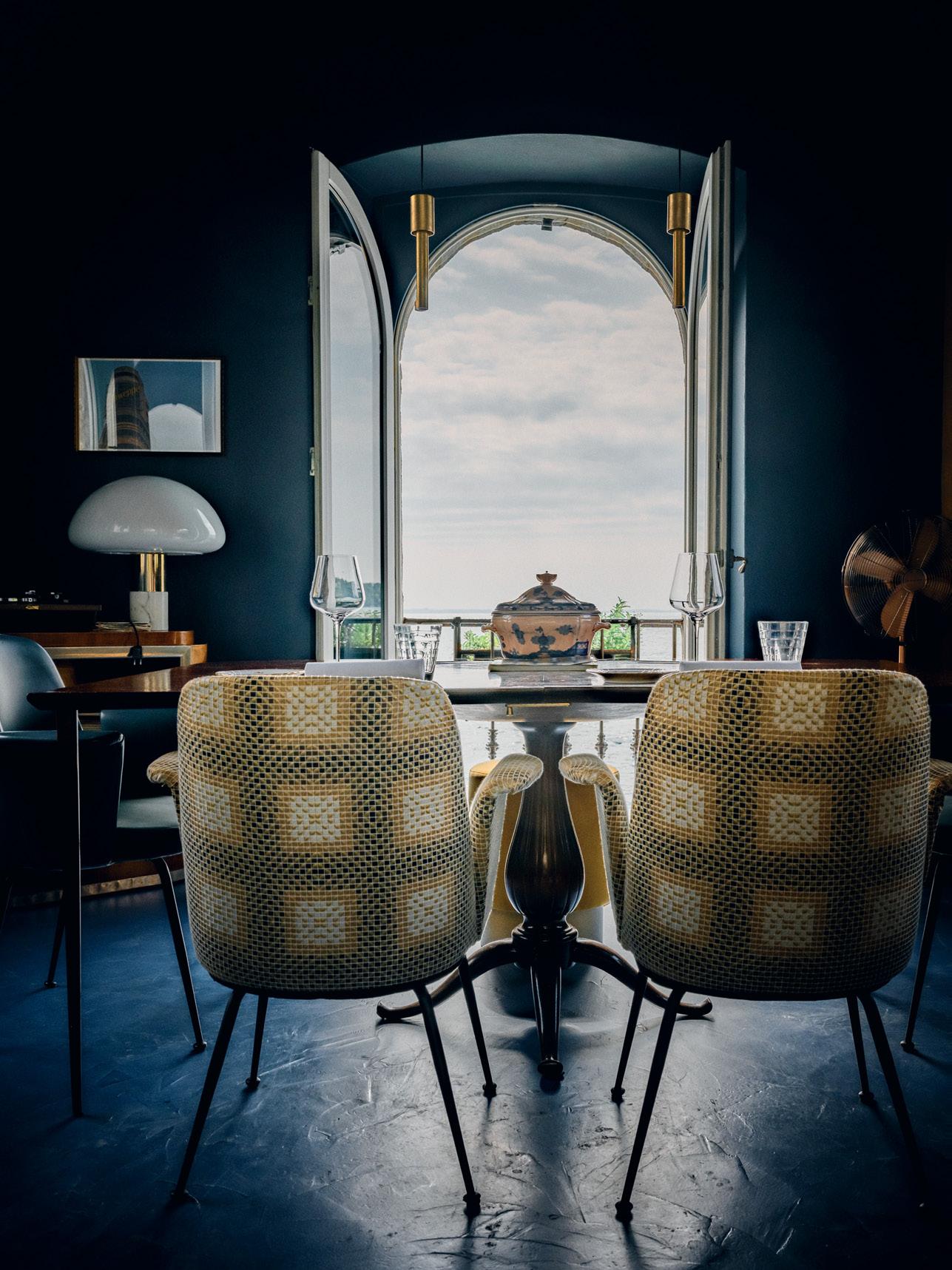
121
restaurant before the Camanini brothers took over, should suddenly be the most sought-after address in the motherland of good food came as a surprise to others as well. But the real connoisseurs have been celebrating Camanini’s cuisine for almost ten years as a revelation and one of the rare interpretations of Italian cuisine in the world of fine dining, which knows how to combine contemporaneity, elegance and actual good taste. In Italy in particular, creative cuisine too often fails to live up to the splendor of tradition.
At Lido 84, this is not the case at all. The greatness of Italian cuisine is presented here with wit and virtuosity, but above all with an unbroken reverence for good, very classical cuisine. Twelve chefs and just as many service staff are on hand for lunch and dinner to serve just 37 guests. The once modest 19 th century building has been transformed into a luxurious restaurant. Through the wide windows, every table has a commanding view of the lake, the water painting golden reflections of light on the ceiling. The lakeside terrace offers as many seats – but because the weather can change quickly here, only the inside or outside tables are assigned on principle: “Unfortu -
nately, far too often here an evening begins with glorious weather and ends with a wild thunderstorm,” says Giancarlo.
The menu celebrates the defining ingredient of Italian cuisine, pasta, in several signature dishes. But it also cultivates classically luxurious ingredients like turbot or pigeon (reportedly important to Michelin testers), and even gold leaf is used. Typical local specialties – not least wild fish from the lake –are the defining elements, however, along with the focus on pasta.
But all these are only the nominal trappings of a gourmet temple. What does the kitchen with all this in practical? “I’m an old man,” says the barely 50-year-old Riccardo without a noticeable hint of coquetry, “I started working when I was 14 and learned from experienced chefs like Gualtiero Marchesi (Italy’s first 3-star, note) or Raymond Blanc. That’s how I still cook today.” He only knows about celebrated and trendy kitchen tricks, such as sous-vide cooking, by hearsay. What touches Camanini when he eats is “the perfection of simplicity.”
09–12 (below) cooks classic Italian, so extremely regional – but with techniques he learned from some of the best chefs around. Below: Grilled and smoked sea fish. Right: Rigatoni “en Vessie” –steamed in a bladder.

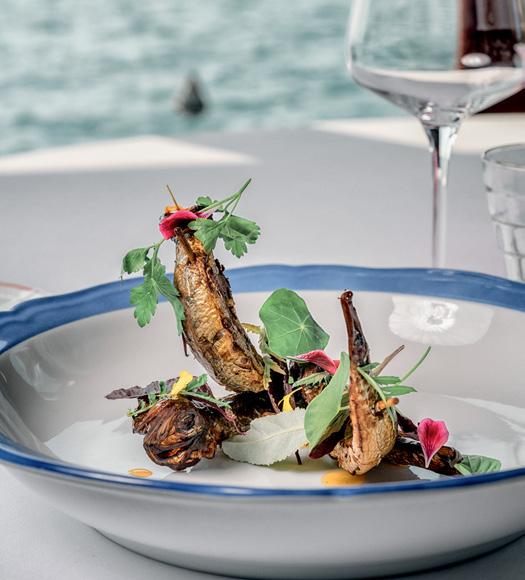
122 S MAGAZIN LAKE FESTIVAL
This pursuit of simplicity is why the wood-burning oven in his kitchen is fired up every day to artfully burn the skin of melanzani at 400 °C, for example, to keep the inside of the fruit as soft as a spoon but only delicately smoky – so that it can be combined at the table with a salsa of Sicilian cherry tomatoes, Parmesan cream and the traditional Campanian fish sauce “Colatura di Alici” to create a monument to Italian feel-good cuisine.
That’s why the ingenious dish with which Camanini first caused an international sensation is shockingly simple: his spaghettone al burro e lievito di birra consists of nothing but thick, firm-to-the-bite pasta in butter, which he garnishes with crumbs of brewer’s yeast dried in a wood-fired oven. It sounds like nothing at all, but explodes on the palate as a finely woven ideal of consistencies and flavors: the yeast crumbs crunchy yet delicately tangy, the pasta of bite-size smoothness, the sauce of butter and cooking water silky and transparent like a negligee. Who would have guessed that yeast could taste so damn delicious, gently nutty and with its subtle power reminiscent of truffles, with the penetrating power of Japanese natto and yet never vulgar? Alain
Ducasse, the most decorated chef on the planet, has put this very plate of pasta on record as “the best thing I’ve ever eaten.”
The question is whether he had already tasted the Rigatoni “Cacio e Pepe”, with which Camanini really pulls out all the stops of Grande Cuisine. The uncooked pasta is filled into a pig’s bladder with pecorino, hand-ground pepper, olive oil and water, hermetically sealed and cooked in a water bath for 25 to 30 minutes. The technique was once developed by the great Fernand Point in Vienne for poularde demi-deuil, a Bresse chicken stuffed with foie gras and black truffles and steamed in a pig’s bladder. Camanini devotes this highest level of culinary attention to a quintessential poor man’s dish.
At the table, the “vessie”, inflated into a ball by the steam, is shaken vigorously before being cut open so that the sauce emulsifies. The pasta is cooked “al chiodo”, i.e. much firmer to the bite than “al dente”, infused with the aromas of pepper and sheep’s cheese down to the very fibers, surrounded by a glorious creamy sauce.
“Unfortunately, far too often here, an evening begins with gorgeous weather and ends with wild thunderstorms.”


123
Camanini pays no less attention to the lake’s native delicacies. The finfish, called “sardines” because of their shape, are abundant edible fish in the lake, and he obtains them from Umberto, Luca and Marco Dominici in Gardone. The father and sons are Garda fishermen and go out before sunrise on the lake, which – in contrast to the extremely clean (and therefore very poor in fish) Austrian alpine lakes – is still teeming with fish.
Camanini first smokes the fish mildly, then fries it crispy and finally coats it with a glaze in which, in addition to all kinds of herbs and honey, the muchpraised lemons from Lake Garda find their way in. The dish is quite demanding, especially for cisalpine gourmets, who generally only encounter haute-cuisine fish when filleted and boned. Riccardo, on the other hand, specifically points out during serving that he considers the head and tail to be the most rewarding parts of the creation.
Lake Garda’s lemons go way back to the 19th century, when supplying northern Europe with citrus fruits became a lucrative luxury business – and timely transport across the Alps was a crucial factor. At
that time, cultivation began at Lake Garda, Italy’s northernmost location, “even though the winters here were far too harsh for the trees to survive,” says Fabio Gandossi of Limonaia La Malora in Gargnano. His farm is one of the last to survive, even independent of modern transportation. The lemons grow on spectacularly landscaped terraces that are barricaded with windows and wooden panels in winter to protect them from frost. A delicious side effect to the particularly slowly ripened and, according to gourmets, therefore particularly aromatic lemons: Caper bushes thrive in the stone walls of the Limonaias, which is why here, in the north of Italy, there is a caper tradition that is hardly inferior to that of Pantelleria in the south. Maria Teresa Giacomini from Gargnano puts the buds in salt, but she also ferments the caper leaves in brine according to an old tradition. Regional delicacies like these can be tasted in the same village, at the Trattoria Al Miralago, located directly on the lake.
The Camaninis’ love of the local lemon – and that, deeply Italian, of flamboyantly risen baked goods – is also evident in dessert, a virtuoso bow to the Torta di Rose, a yeast dough construct of the
13–15 Fabio Gandossi, one of the last Limonaias, or lemon growers, on Lake Garda – and makes excellent Limoncello. Maria Teresa Giacomini (r.) harvests capers, which she salts according to ancient tradition.
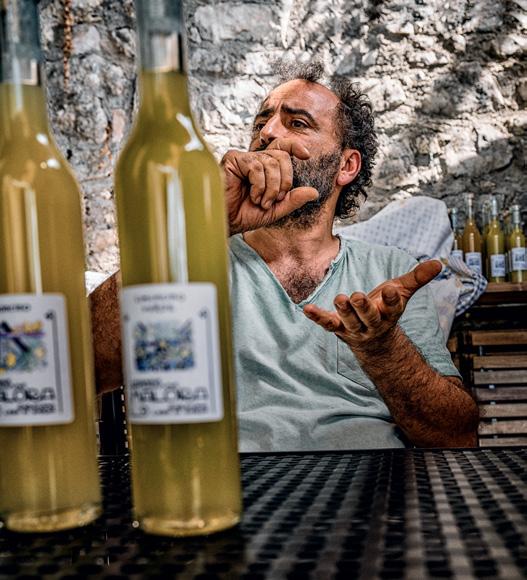
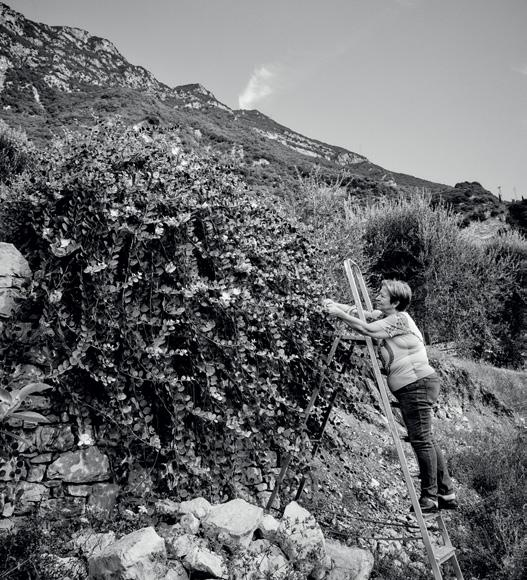
124 S MAGAZIN LAKE FESTIVAL
very airiest kind, lacquered quite old-fashionedly with lemon marmalade and topped with a sinfully creamy, equally lemony zabaglione. Tastes to die for, looks terrific – and yet is essentially made of air. You’ll think of this later, when you visit the Vittoriale of national poet Gabriele D’Annunzio, which towers high above Gardone, and where the Italian art of the grandiose gesture is immortalized in often frightening consistency.
THE WEBSITES OF THE ESTABLISHMENTS:
Lido 84, ristorantelido84.com
Frantoio Manestrini, manestrini.it
Villa Arcadio, hotelvillaarcadio.it
Limonaia La Malora, limonaialamalora.it
Kapern Giacomini, oliogiacomini.com

125
ERWIN STEINHAUERS
TASTE MEMORIES,
RECORDED BY ACHIM SCHNEYDER
SUBSCRIPTION TO THE SAUSAGE STAND
PHOTO: PHILIPP HORAK
Now that the great performer Erwin Steinhauer has reached his seventies and become an older type of gentleman, albeit a very sprightly older gentleman, the world just doesn’t seem the same as it used to. At least not when it comes to food and drink. In the past, he was not only a hedonist and a gourmet, in constant search of epicurean pleasure, but often and gladly also quite a gourmand, i.e. glutton. At the time, he described himself as a hedonistic gourmand. It’s just that the excessive part of this wonderful neologism, the gourmand, “died off one day”. It would still be there, my appetite for good things and lots of them, says Erwin, “but you have to pay tribute to age”. And that applies to both eating and drinking.
So today, the former ensemble member of Vienna’s Burgtheater ideally eats only once a day, often alone and mostly at home, usually in the afternoon, as healthily as possible and without any wine as an accompaniment. “That’s when I cook myself vegetables from the market, for example, plus a sour cream dip with lots of garlic, I drink water and I’m halfway satisfied.”

This may sound a little sad, but it should be noted that Erwin can still do other things. Whether out or at home, he enjoys company, sometimes in the evening and also with a glass of white wine, but more rarely now and even more rarely in excess.
However, since this story is served under the title of “Taste Memories,” we will now rehash the past.
When Erwin thinks of his childhood in Lichtental in Vienna’s 9th district, where he lived with his parents and paternal grandparents in a large apartment, two smells come to mind “that filled the whole Marktgasse for a day and burned themselves into my brain, back in the 1950s: baked fish on Friday, breaded schnitzel on Sunday”.
For a long time, his grandmother and grandfather were responsible for cooking in the Steinhauer home, because Erwin’s mother, who came from Ernstbrunn and therefore a simple countrywoman, was not allowed to touch anything in the kitchen at first. “She first had to learn from her parents-in-law and earn this right,” remembers Erwin, who was “always a bit of a ‘Wuzel’
126 S MAGAZIN ROUND THE TABLE
or glutton even as a boy”. However, his grandfather stopped cooking almost overnight after he had accidentally used semolina instead of breadcrumbs when breading the schnitzel, but only noticed this mistake when he took his first bite. “The schnitzels were as hard as wood and that hit him so hard in the soul that he declared his career at the stove over.”
Erwin’s career at the stove, on the other hand, didn’t even begin until he was 35. “Until then, I hadn’t lifted a finger in the kitchen. But freshly separated from the mother of my first two children, I was suddenly a single father, and it was no longer possible to mindlessly sit and sin somewhere after performances until four in the morning. No, the kids needed breakfast before school and lunch after school.”
Chicken escalopes in cream sauce was to be one of the first dishes he eventually mastered.
“Back then,” he says, “I much preferred eating to cooking; today it almost balances out.” Speaking of scales: “My problem in life was always quantity. I could eat so much of perfectly wholesome things that my diaphragm was up to my chin. And then I sat there, suffered a little and thought to myself: But at least it was healthy.”
Erwin, who one whimsical day gave himself the nickname ErVino (obvious) Rosso (referring to the color preference) Barocco (owed to the lifestyle), probably had his healthiest phase apart from now in 2008 and 2009, which came about like this: Erwin and his alter ego ErVino sat with a glass of Reihburg 2001, Uwe Schiefer’s beloved Blaufränkisch, pondering why Erwin had downright forgotten about his formerly preferred white wine drinking over all those years of red wine drinking. Then his ailing body told him that he could no longer tolerate these heavy reds so well anyway due to antihistamine intolerance. This gave Erwin food for thought and he decided to send Erwin to rehab and ErVino to the great drinking dens in the sky. After this period of rehab, Erwin then prescribed himself an additional one-year drought period, during which he lost a small barrel, so to speak – namely 30 kilos – but soon found this barrel again. “And since then, I’ve been drinking exclusively light whites.”
those in semi-boarding school in junior high, and can barely tolerate baby goat and hare to this day, since he personally knew all those kids and hares that were once served on his maternal grandparents’ farm in Ernstbrunn. What he particularly likes, on the other hand, is lamb and fish; when he prepares the latter himself, he acquires from a fishmonger called Gutfleisch.
On the other hand, Erwin has largely sworn off pork, except for hand-cut leg ham. “That’s another memory,” he says. “When I lived near the Rosenhügel film studios in the late 1970s, there was a delicatessen where I ate a hand-held sandwich with ham cut from the bone every day. And I still taste that today when I’m in the area, even though the store has long since ceased to exist.”
And another taste will accompany and beguile his senses – at least in his thoughts – for a lifetime. “In the 1980s, after performances at the Burgtheater, it was obligatory to make a pilgrimage to the sausage stand in Schottengasse, despite the canteen’s potroast sandwich during the intermission. I practically had a Burenwurst subscription there, ‘A Haße, amoi durch, an Schoafn und drei Pfefferoni’ (Viennese expression for ‘A Burenwurst sausage, cut in two, with hot mustard and three pepperoni’), that was always the same order, because one thing was important: not pre-cut into bite-sized morsels and not skewered with a toothpick, but split down the middle, because I wanted to take a bite myself, so that the fat would just splatter...”.

But back to the solid food. Erwin detests poppy noodles, for example, because they overfed him with
Then Erwin falls silent for a moment, looks up from his plate with the fantastic catfist served in the Steirereck, and finally says questioningly: “I really should treat myself to a Bur’nhax (Burenwurst) again, shouldn’t I? Yes, Erwin, absolutely!
ERWIN STEINHAUER is not just a great artist. Erwin has practically always been someone who has enjoyed the finer things in life, who became a cook when he was a part-time single father.
127
OTHER HORIZONS
RECOMMENDATIONS BY BIRGIT AND HEINZ REITBAUER PART 14
Antwerp is always worth a visit. A city that not only has a lot to offer in terms of art and culture, but also hosts a high density of great and exceptional restaurants.
The various concepts and lines of their excellent chefs enable us to dive into different worlds and always discover something new.
THE JANE Antwerpen
A legend! The location in a former church is amazing in itself, due to the design and architecture that provide exciting contrasts. Nick Brill’s team has done a truly extraordinary job here. Here you will experience great cuisine in a casual setting, presented by a troupe that lightheartedly and cheerfully creates a sensational atmosphere.
HERTOG JAN @ BOTANIC Antwerpen
Many foodies already know Gert De Mangeleer & Joachim Boudens well from their restaurant in Bruges, who have now found a new venue in the heart of Antwerp, in the beautifully renovated Hotel Botanic Sanctuary. The simple, elegant setting is an impressive and perfect backdrop for the excellent cuisine.
’T ZILTE Antwerpen
This great restaurant is also housed in an astonishing building. Located on the last floor of the Museum aan de Stroom, it offers spectacular views over the sea, harbor and city. Viki Geunes and his wife, with their fine, elegant cuisine and warm service, create a place where you will want to come again and again to spend delightful moments.
HOF VAN CLEVE Kriusem
Lieve and Peter Goossens’ beautiful restaurant is located about an hour’s drive from Antwerp. Here, you are transported into the singular Hof van Cleve world. Peter’s aromatic and tasty cuisine, the orchestrated service under the direction of Lieve and the magically beautiful place let everyday life fade into oblivion for a few hours. Absolutely worth a trip!
ADDRESSES
THE JANE Paradeplein 1 2018 Antwerpen thejaneantwerp.com
HERTOG JAN @ BOTANIC
Lange Gasthuisstraat 51 2000 Antwerp hertog-jan.com
’T ZILTE Hanzestedenplaats 5 2000 Antwerpen zilte.be
HOF VAN CLEVE Riemegemstraat 1 9770 Kriusem hofvancleve.com
128 S MAGAZIN RECOMMENDED RESTAURANTS








































































 PHOTOS: MIRCO TALIERCIO
PHOTOS: MIRCO TALIERCIO









































































 TEXT: SEVERIN CORTI
FOTOS: MIRCO TALIERCIO
01–03
TEXT: SEVERIN CORTI
FOTOS: MIRCO TALIERCIO
01–03














